 |
 |
| SGH TOPICS |
| DATE | OUTLINE | PICTURE |
| 2020/ 2/11(Tue.) 1,2,3rd year (17th, 16th, 15th) |
SGH 7th Senior High School Students’Day for Considering International Issues (1,2,3rd year) At Kobe Fashion Mart on Rokko Island, the seventh Senior High School Students’Day for Considering International Issues was held. It was hosted by the Hyogo Prefectural Board of Education, Osaka University, and the World Health Organization (WHO) Kobe Center. Senior high school participants from 27 schools in and outside of Hyogo prefecture joined the event and presented 119 posters. Twenty students from Hyogo Prefectural International Senior High School (HIS) participated in it. Fifteen of them were first-year students, three were second-year students, and three were third-year students. First, Ms. KAWAMURA Hiromi, Public Relations Secretary for the Tokyo Organising Committee of the Olympic and Paralympic Games or TOCOG, made a keynote speech about the following theme; Tokyo 2020 Olympic and Paralympic Games (Tokyo 2020) seen from the international point of view. Next, three representative senior high school students joined a panel discussion. They discussed the Olympics and Paralympics and international issues. During lunchtime, a seminar for teachers was held. The purposes were to share examples of their SGH activities with each other, and to improve the SGH activities of each school. Mr. Maekawa from Hyogo Prefectural International High School (HIS) reported the use of the HIS’ SGH rubric, which was developed by HIS to four teachers from Hyogo Prefectural Seiryo High School, Hyogo Prefectural Miki High School, and Hyogo Prefectural Sanda Shounkan High School. Mr. Maekawa from HIS reported that the general HIS SGH rubric is modified for each SGH activity and used in evaluation of students’ activities such as debate, making migrant maps, and writing theses on a proposal for Japan’s migrant policies. The rubric is also used for improving these research activities. In the afternoon, there was a poster session. The HIS students made eight presentations. The HIS first-year students presented posters about: (1st year) (1) “A report on Cambodian high school students' attitude toward working in Japan ---compared with the survey results from Thai and Philippine students” (2)“A report on the analysis of survey results of Cambodian workers who have worked in Japan ---the comparison between the survey results in 2016 and those in 2019” (3) “A study about the history of Japanese migration to Brazil---how the society of Japanese immigrants in Brazil developed between 1908 and 1980”(Picture ①②③) (2nd year) (4) “Case studies about the poverty of children of migrant people in Japan---focusing on cafeterias for these children (5) “A study about the language competence and self-recognition of people with dual heritage ---focusing on people mixed with Japanese and Indonesian backgrounds” (6) “Case studies of language assistance to migrant women---focusing on the Japanese language education for migrant women living in Japan”(Picture ④⑤⑥) (3rd year) (7) "Ethnography--description of a student from overseas who studies at a Japanese high school---how the mother tongue and culture of a student from overseas living in Japan are passed down" (8) "A case study on acceptance of immigrant workers---focusing on technical interns and their families" Each group gave a ten-minute presentation and a 5-minute question-and-answer session twice. The HIS presentations caught the attention of a lot of the audience including university lecturers, high school teachers and students, and other people. The HIS students reported their research results, and the audience asked questions, which HIS students answered.(Picture ⑦⑧) There was a second-stage judgement of the poster presentation contest in the afternoon. Eight representatives from eight schools that passed the preliminary round presented their posters at the hall, and questions were asked by three judges. One of the eight representatives was an HIS second-year student Ms. SEIMA. She made a ten-minute poster presentation about “Case studies about the poverty of children of migrant people in Japan---focusing on cafeterias for these children.” In the following three-minute question-and-answer session, she answered questions from three judges. After the poster sessions, there was an awarding ceremony and comments were made by the judges. The HIS second-year student Ms. Seima won an award for excellence. (Pciture ⑨)Medical Doctor KAYANO Ryuma at the WHO Centre for Health Development (WHO Kobe Centre)(WKC) made some comments and talked about why research is important and how to make further research. He mentioned the importance of collecting preceding research, case studies, and factual data. He highly evaluated Ms. SEIMA for having gone through the basic process of collecting these. We are grateful to him for highly evaluating her HIS research. At the same time, the prize will surely motivate her and other students for further research. The HIS first-year and second-year students learned a lot from the day’s activities since they are continuing their research. The event was also good for the third-year students because they had written their reports and had a chance to present them. (Picture ⑩) |
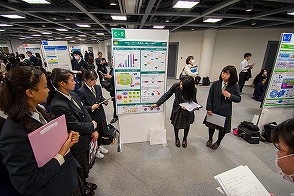 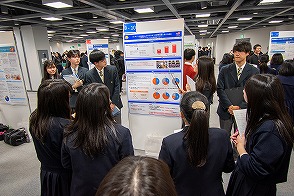 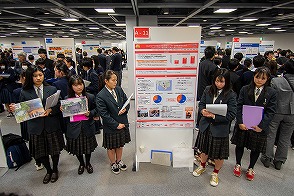 (Picture ①②③)1st-year groups present their posters. 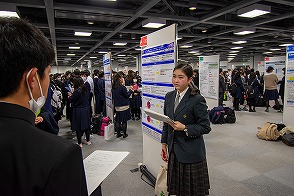 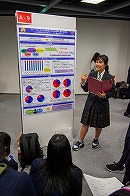 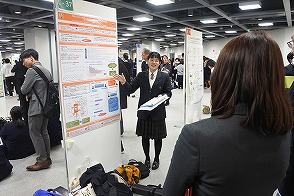 (Picture ④⑤⑥) 2nd-year students show their posters. 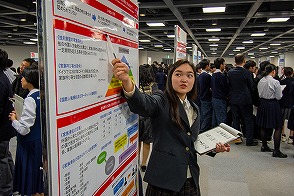 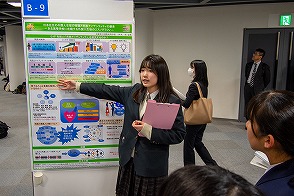 (Picture ⑦⑧) 3rd-year students explain their posters. 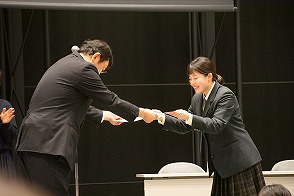 (Pciture ⑨)Ms. Seima wins an excellece award. 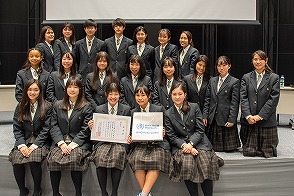 (Picture ⑩)All the HIS students including the award-winner are smiling. |
| 2020/ 2/8(Sat.) 1st & 2nd year (17th, 16th) |
2020 SGH Fieldwork in Ikeda (1st & 2nd year) 2020 SGH Fieldwork in Ikeda~ Visit to ‘Poplar’ Special Nursing Home for the Elderly (1st ,2nd year) Sixteen first-year and second-year students from Hyogo Prefectural International High School(HIS) went on SGH fieldwork and visited 'Poplar', a special nursing home for the elderly in Ikeda City, Osaka. (Picture ①) Their main goals were to visit a nursing home which accepts care workers from overseas, to learn about the present situation of Japan’s nursing homes and migrant workers there, and to have a chance to consider what Japan will be like with more immigrants in the future. Another purpose was to visit the same nursing home that students from HIS have visited for the past four years and learn about any changes in the employment of care workers from abroad. First, a Poplar staff member explained some things about the facility. (Picture ②) The special nursing home Poplar was established 15 years ago and this is the sixteenth year for the home. 900 staff members in total are working in all related facilities. Poplar started to employ immigrant workers in 2009, and now there are 41 migrant care workers working in all the related facilities. Of the 41 employees, seventeen workers are care workers and care worker candidates from the Philippines. 15 are Nepalese, and thirteen of them have the ‘college student’ status of residence, one has the ‘nursing care worker’ status, and one is the spouse of a Japanese national. There are four Vietnamese people among the migrant workers, and all of them have the residence status of ‘student.’ Out of the three Chinese immigrant workers, two have the status of ‘student,’ and one has the status of the ‘spouse.’ One worker from Myanmar is a student, and one person from Saudi Arabia is the spouse of a Japanese national. The nursing home increased the number of migrant workers from 24 last year to 41 at present, which is an increase of 14. The facility has accepted not only migrant care worker candidates under an Economic Partnership Agreement (EPA) but also migrant people with the residence status of ‘student’, ‘spouse’, and ‘nursing care worker’. They come not only from the Philippines but also other countries such as Nepal, Vietnam, China and Saudi Arabia. Poplar had the first EPA care worker candidate who passed the test to become a certified care worker, and is one of the oldest facilities which has accepted migrant care workers. Now Poplar has five care workers--one certified care worker and four care workers who have finished school for nursing care work. Also, it is going to accept 24 technical interns as care workers from Myanmar this May. The facility is now building a new dormitory and migrant workers from Myanmar who are already working in the facility are going to help the new workers from Myanmar. Poplar established the Poplar International Training Center in September, 2019, and has taught migrant technical interns over the course of one to two months. They have come to Japan for the first time and are taught about the knowledge necessary for working and living in Japan for one to two months. This training center is teaching the care workers the Japanese language, the knowledge about life and nursing, and techniques for nursing care work. A facility named ‘Poplar Gakuen (Poplar Academy)’ is now scheduled to be open in April, 2020. The academy was formerly expected to be open by March 2020. After the academy opens, it is going to train migrant care workers, and hopes to let them work not only at Poplar but also at other nursing facilities. Poplar set up the nursing school Poplar Academy in Nepal, and it has now 72 students--36 students per year in a two-year course. In October, 2019, the exam in designated activities of nurse and care work was conducted for the first time in Nepal. In order to work with the ‘designated activities’residence status of nursing care work in Japan, candidates should pass the fourth grade of the Japanese proficiency test, the Japanese language test about nursing care, and the skill test about nursing care. When people in Nepal tried to apply for the exam on the website, there was a lottery to become an applicant, and only ten students at Poplar Academy in Nepal were able to take the test. That is why more and more students are now worried about working in Japan. In the Philippines, on the other hand, the exam under the category of designated activities of nursing care work was first held overseas, and one thousand applicants passed the exam. They are going to visit Japan in spring, 2020. Exams are going to be conducted in Mongolia, Myanmar, and Cambodia in the future. Next, the HIS students interviewed the migrant care workers at Poplar. (Picrture ③) They had interviews with six people--- one certified care worker, two EPA care worker candidates, all from the Philippines, a care worker from Nepal who has finished studying at a Japanese school to get the qualifications for becoming a care worker, a student who is now studying at a Japanese language school, and one Chinese person with the residence status of ‘student.’ When they were asked about why they came to Japan, the two EPA care worker candidates from the Philippines said that they first intended to go to Saudi Arabia, but their families opposed the destination. They were recommended to go to Japan, a safer country, and that that’s why they came to Japan. One care worker from Nepal with the qualifications for becoming a care worker in Japan answered that she came to Japan because it is safer than in Nepal where it is dangerous for a woman to go out after eight o’clock at night. Next, they were asked about what was troublesome to them when they came to Japan. All of them answered they had trouble learning the Japanese language. When they were asked about whether they would like to stay in Japan or go back to their home countries in the future, four out of the six answered that they would like to keep on working in Japan. Lastly, they were asked about what would be necessary for Japan to accept a lot of care workers. Six of them answered that helping new comers to learn Japanese would be necessary. One certified care worker from the Philippines, who had passed the national exam to get the qualifications and now has lived in Japan for ten years and who is now applying for permanent residence in Japan, answered, “We would like to learn Japanese, but care working is a very busy and both physically and mentally tiring job. That’s why it would be hard for us to learn the Japanese language during our time off”. She appealed to nursing and care facilities to improve their working conditions. The HIS students learned a lot about the present circumstances surrounding Japan’s nursing homes and migrant care workers. The students will take advantage of their experiences there to carry on their research. |
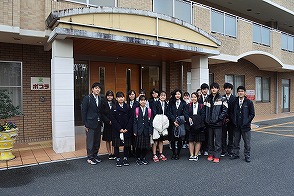 (Picture ①)HIS students visit Poplar, a nursing home for the elderly in Ikeda City. 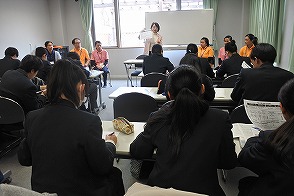 (Picture ②) A Poplar staffer talks about Poplar. 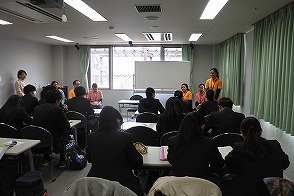 (Picture ③) Migrant care workers answer some questions from HIS students. |
| 2020/ 2/1(Sat.) 1st year (17th) |
SGH Fieldwork at the 2020 One World Festival (1st year The 2020 One World Festival (OWF) was held at Ogimachi Square of Kantere (Kansai TV) and the North Ward Community Center. All the first-year students from Hyogo Prefectural International Senior High School (HIS) conducted fieldwork there. In 2015, the United Nations held the Sustainable Development Summit and adopted 17 Sustainable Development Goals (SDGs). The OWF’s purpose was to share these 17 goals, and to offer a chance and a place to meet organizations and institutions, see information and people, and work in the future. The OWF is one of the largest events of this kind in Western Japan, in which more than 100 organizations including non-governmental organizations (NGOs), nonprofit organizations (NPOs), administrative offices, businesses, schools, and other education-related institutions had booths to inform participants of their efforts to promote international cooperation and to solve social issues. The HIS students’ objective was to conduct fieldwork with a chance to consider solving social issues such as immigration policy, which is their SGH research topic, and to imagine what Japan will be like in the future. The HIS students prepared questions to ask beforehand, asked them at related booths and took notes when they got answers. (Picture ①-④) Some HIS students visited a model tent, which was the same as one used in a refugee camp by the UNHCR, listened to the challenges and problems the refugees are having from staffers there, and asked them some questions.(Picture ⑤) The HIS students filled in their worksheets about what they learned. It was a very good chance for them to think about various kinds of issues which the global community is now facing. |
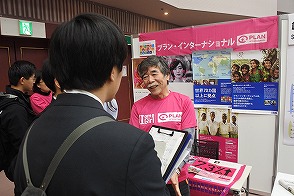 (Picture ①)HIS students visit 'Plan Int'l Japan'. 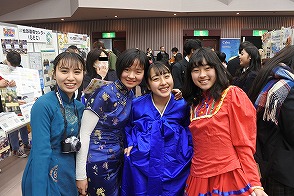 (Picture ②) HIS students wear ethnic dresses. 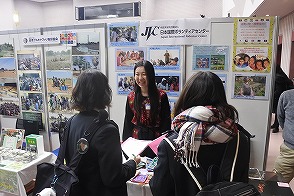 (Picture ③)The students go to 'JVC Volunteer Center'. 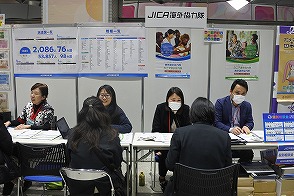 (Picture ④) They ask questions at JICA. 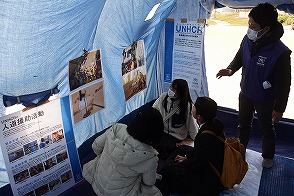 (Picture ⑤) They touch a UNHCR tent. |
| 2020/ 1/25(Sat.) 1st, 3rd year (17th, 15th) |
SGH :the 2nd High School Students' Forum on Global Health at Takatsuki
High School (1st, 3rd year) Two third-year students from Hyogo Prefectural International High School (HIS) and one first-year international student, who came from Cambodia through the “Kakehashi (building bridges)” scholarship program and has been studying at the HIS participated in the 2nd High School Students' Forum on Global Health at Takatsuki High School. 135 students from Takatsuki Junior and Senior High School and 18 students invited from other SGH high schools joined it. First, Dr. Sarah Louise Barber, Director of WHO Kobe Centre (WKC), made a keynote speech about global health in English. Next, workshops on different themes were conducted. The students were divided into 16 workshops and discussed each theme in a group in English. One third-year HIS student joined a workshop about fast fashion and health. She pointed out in a discussion that low-paid migrant workers and female workers in developing countries, such as Bangladesh, are producing fast fashion products. (Picture ①) Another third-year student joined a workshop about assistance and health. She summarized a discussion for a PowerPoint presentation in English later. (Picture ②) The international students from Cambodia joined a workshop about obesity and health. He shared his own experience with members in a discussion. (Picture ③) After the workshops, all the students including the three HIS students gathered and presented what they discussed in English. Some English comments on the reports were made and the forum was finished after the closing speech. (Picture ④) The HIS students were able to exchange their opinions with other SGH students. It was a very good opportunity for them. (Picture ⑤) |
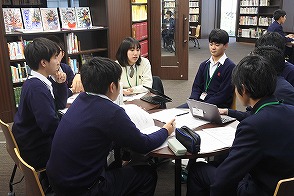 (Picture ①)The group discusses fast fashion and health. 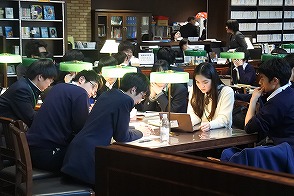 (Picture ②) The members talk about assistance and health. 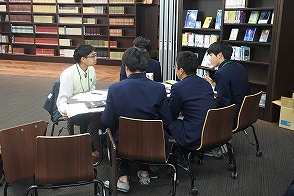 (Picture ③)An HIS student shares his experience with his group. 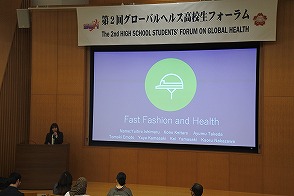 (Picture ④) An HIS student reports about fast fashion and health. 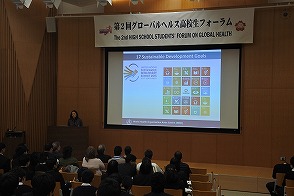 (Picture ⑤) Comments are made about the reports. |
| 2020/ 1/16(Thu.) 1st year (17th) |
SGH Research Activity: Presentations of "World Migration Maps" (1st year) In the Super Global High School (SGH) research project, the first-year students made "World Migration Maps", and presented them on January 16th. This year the students focused on migration between Japan and Brazil. The theme was the history of Japanese people who migrated to and from Brazil. The students in Class 1 made maps of the migrant flow from Japan to Brazil in 1908 and described why Japanese people emigrated to Brazil. (Picture ①) The students in Class 2 made maps of the migrant flow from Brazil to Japan between 1908 and 1980, and described how Japanese immigrant society in Brazil developed. (Picture ②) The students in Class 3 made maps of the immigrant flow from Brazil to Japan and explained why the number of Japanese Brazilians shot up in Japan. (Picture ③) Each class’s poster carried a graph and a map showing the flow of migrants from one country to another, push factors that sent emigrants out of a country, pull factors that attracted immigrants into a country, and a conclusion. They presented their posters in a poster session, and evaluated each other’s presentations. They attained a deeper understanding of the migration between Japan and Brazil for the past 110 years. |
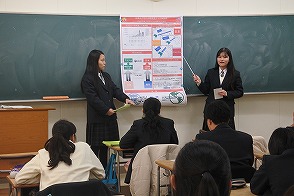 (Picture ①) Class 1 describes the reason for Japanese emigration to Brazil. 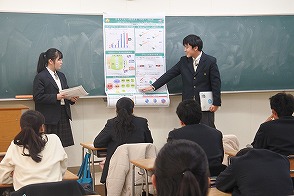 (Picture ②) Class 2 explained how Japanese immigrant society developed in Brazil. 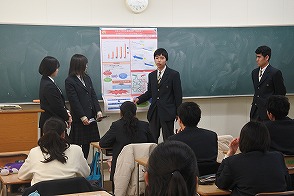 (Picture ③ )Class 3 talks about the increase in the number of Brazilians in Japan. |
| 2020/ 1/15(Wed.) 2nd & 3rd year (16 & 15th) |
SGH the First Lunch-Hour Street Preaching-Style Open-Air Lecture (2nd & 3rd year) During the lunch hour on January 15th 2020, two third-year students taught twenty second-year students, who were researching migration. The two third-year students completed their research papers and got awards at the 2019 Research Festa at Konan University. The 20 second-year students were preparing to write their academic papers. They learned some important points in writing their thesis from the third-year students: (1)the theme of a paper should be a concrete one, not an abstract one, (2) you should find previous research which has the same theme as yours, and (3) you should try to make your research original, which means you should consider new social conditions which other previous research has not taken into account and conduct original surveys for your research. (Picture ①②) The lecture was a good opportunity for the third-year student to share some advice with the second-year students and help them write their own papers. |
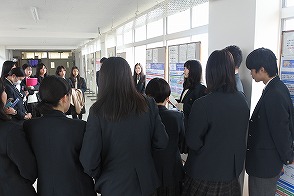 (Picture ① ) 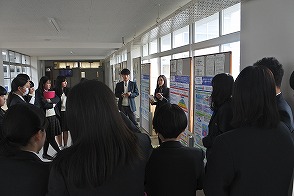 (Picture ②) |
| 2019/ 12/22(Sun.) 1st-3rd year (17-15th) |
SGH Research Activity :2019 Konan University Research Festa (1-3rd year) The 2019 Research Festa was held at the Okamoto campus of Konan University, and 1,150 participants---university students and lecturers of Konan University and senior high school students and teachers from Hyogo prefecture and other prefectures---gathered. 357 titles of research were presented. Fourteen students from Hyogo Prefectural International High School (HIS) —ten first-year, one second-year, and three third-year students-- participated in it.) The third-year students presented a poster about the results of their three-year research. One of them, Ms. Mae presented her research titled "Ethnography--description of a student from overseas who studies at a Japanese high school---how the mother tongue and culture of a student from overseas living in Japan are passed down".(Picture ①) Ms. Nakazawa talked about her research, "A case study on the Japanese nationality system". (Picture ②) Ms. Nagano presented her research, "A case study on acceptance of immigrant workers---focusing on technical interns and their family". (Picture ③)They finished writing their research paper in the class named ‘Proposal: Japan’s choice’ organized by the HIS. A second-year student, Ms. Iwaasa talked in English about her research, “Consideration of survey results from Filipino who have moved out of the Philippines: What we can do for foreigners”. (Picture ④) First-year students, Ms. Aiso, Ms. Omura, Ms. Sakaguchi, Ms. Hachiya, and Ms. Hayashi presented their research about results of the surveys on Cambodian, Filipino, and Thai high school students' attitude toward working in Japan. (Picture ⑤) Another group of the first-year students, Ms. Mizukami, Ms. Sato, Ms. Uchida,Ms. Dozono, and Ms. Hosogoshi presented the research, "A report on surveys of Cambodian workers who have worked in Japan"—comparison between results of the 2017 survey and those of the 2019 survey.” (Picture ⑥ ) After the presentations, the HIS students and other schools’ students worked togetherto solve an assignment in a meeting. After the meeting, Ms. Nagano got the Judges’ special award in an over-all evaluation, and Ms. Mae received the attractive presentation award and the logical design award in each category. (Picture ⑦) This event gave the HIS students a good chance to learn about other kinds of research by other high school students and undergraduates and graduates of Konan University. |
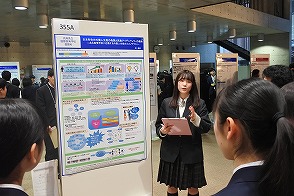 (Picture ①) Ms. Mae presents her poster. 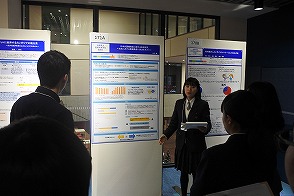 (Picture ②) Ms. Nakazawa talks about nationality. 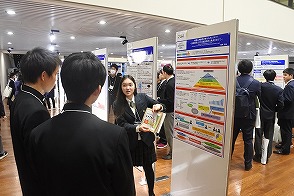 (Picture ③)Ms. Naganodiscusses immigrant workers and their family. 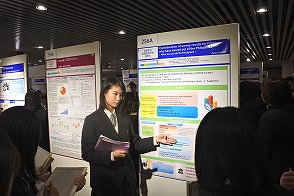 (Picture ④)Ms. Iwaasa talks about immigrant workers from the Phillipines. 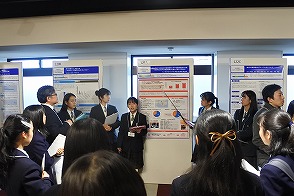 (Picture ⑤)A first-year group compares workers from Cambodia, the Phillipines, and Thailand. 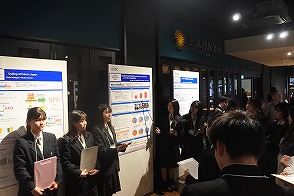 (Picture ⑥)The other first-year group compares surveys in 2017 and those in 2019. 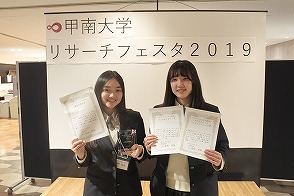 (Picture ⑦) Ms. Nagano receives the Judges' special award,and Ms. Mae gets two awards. |
| 2019/ 12/22(Sun.) 2nd-year (16th) |
SGH Study Tour @ All Japan High School Forum 2019 (2nd year) Four 2nd-year students from Hyogo Prefectural International High School (HIS) and one teacher went on a study tour to participate in the All Japan High School Forum 2019. The forum was held at Tokyo International Forum. At 10:00, the opening ceremony was held (Picture ① )and at 10:30, four students from the HIS participated in a sub discussion group, “Social Environment and Our Daily Life”. They talked in English about what they thought was the most important social issue, what was the cause of it, and what high school students could do to solve the issue. (Picture ②) After their talks, at 12:50, the HIS group presented their poster, “Consideration of survey results from Filipino people who have moved out of the Philippines: What we can do for foreigners”. (Picture ③) Then, all the participants had a plenary session, an awarding ceremony, and a closing ceremony. (Picture ④) 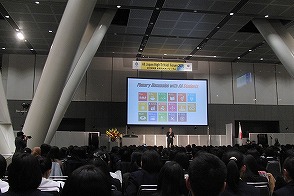 (Picture ④)They attend the plenary session. |
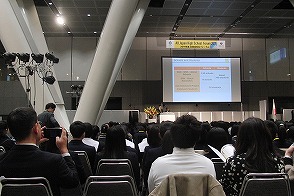 (Picture ① )The students atend the opening ceremony. 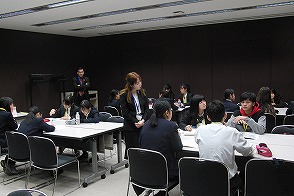 (Picture ②) The HIS students discuss important social issues. 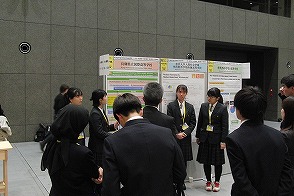 (Picture ③ )The HIS students present the poster about immigrant workers from the Phillipines. |
| 2019/ 12/18(Wed.) 1st-3rd year (17-15th) |
SGH Presentation @ International Exchange Seminar (1-3rd year) Two third-year students and four second-year students from Hyogo Prefectural International High School (HIS), all SGH project members, presented their posters in English to 40 international students from University of Hyogo (UH) in a poster session held at Ashiya Luna Hall. Presentations and discussions were made in English. First, after masters of ceremony, HIS third-year students announced the commencement of proceedings in English., the students from HIS and those from UH were divided into groups and introduced themselves in English. Then, the HIS students presented their posters about the results of SGH research. Ms. NAKAZAWA, a third-year student, showed her poster titled “A case study on the Japanese nationality act: focusing on people with multiple nationalities”, and talked in English about the relationship between Japan’s nationality system and the identities of people with multiple nationalities. (Picture ②) Another third-year student, Ms. NAGANO showed her poster titled, “A Study on Foreign Workers in Japan: Focusing on Technical Intern Trainees and Family Accompaniment in Japan”. She reported that because of various kinds of laws in Europe, migrant workers were allowed to live with their families. She insisted that from the standpoint of human rights, migrant workers in Japan should also be allowed to bring their families to Japan and live together.(Picture ③) The group of four second-year students presented their poster titled “Consideration of survey results for Filipino who have moved out of the Philippines: What we can do for foreigners.” They analyzed the results of the interviews to former migrant workers, especially to Japan. They found out what were problems for migrant residents in Japan, and proposed some measures to build a county where both Japanese and migrant people can live together comfortably. After the presentations, they discussed some issues in English. The UH students asked the HIS students some questions, and HIS students answered them in English. The HIS students were supported by two international students to HIS from Cambodia and the Czech Republic. Some first-year HIS students participated in a discussion. This was the first time for some HIS students to present their research to international university students. The university students gave them a lot of advice and opinions, and the HIS students learned a lot from them. |
 (Picture ①)HIS students introduce themselves to international students from UH.  (Picture ②) Ms. Nakazawa presents her poster about identities of people with multiple nationalites.  (Picture ③)Ms. Nagano insists that technical intern trainees and their families should be allowed to live together in Japan. |
| 2019/ 12/18(Wed.) 1st-3rd year (17-15th) |
2019 SGH Final Presentation of Research & Overseas Study Tour Presentation (1-3rd year) 2019 SGH Final Presentation of Research was conducted at Ashiya Luna Hall, and all the year students presented the results of their research. Before that, the second-year students presented reports on their overseas trip to the UK, the US,and Canada to the first-year students who were going to choose one of these three countries for their trip in the next school year. (Picture① ) The final presentations of SGH research followed them. First, the HIS principal and the chief supervisor of the Hyogo Prefectural Board of Education made opening speeches.(Picture ②) Then the presentations were given as follows: Part 1 1.1st-year students (1)"The 2019 SGH Cambodia study tour report" (Picture ③) (2)"A report on Cambodian high school students' attitude toward working in Japan"(Picture ④) Conclusion: Japan should allow immigrants who have a status of residence with no restriction in employment to be able to bring their family to Japan and live together. (3)"A report on surveys of Cambodian workers who have worked in Japan".(Picture ⑤) Conclusion: Japan should improve the way technical interns work. 2.1st and 2nd year students "The SGH presentation at Nishinomiyahama junior high school". (Picture ⑥) 3.2nd-year students (1) "An attitude survey on disaster assistance in the US, the UK, and Canada". (2) "A case study on disaster prevention education for immigrant workers in Japan".(Picture ⑦) Conclusion: Companies and working places where people from overseas are working should actively help them to get disaster prevention education. (3) "An attitude survey on volunteering in New Zealand". (Picture ⑧) Part 2 4.3rd-year students (1) "Ethnography--description of a student from overseas who studies at a Japanese high school---how the mother tongue and culture of a student from overseas living in Japan are passed down".(Picture ⑨) The present situation of immgrant students: they have two different senses of value and social networks---they live in two worlds at the same time. (2) "A case study on the Japanese nationality system" (Picture ⑩) Conclusion: There is a gap between Japan's nationality system and the identity of a person with dual nationality, so the nationality system should be hopefully changed. (3)"A case study on acceptance of immigrant workers---focusing on technical interns and their family" (Picture ⑪) Conclusion: Japan should change the current system so that technical interns and their families can live together in Japan. After those presentations, nine panelists---a former parliamentary vice-minister of foreign affairs Mr. YAMADA Kenji, Superintendent of the Ashiya City board of education Mr. FUKUOKA Kensuke,Board member of Japan Society of Social Design Studies Ms. SANO Atsuko, Chief Supervisor of the Hyogo Prefectural board of education Mr.TSUJI Toshio, three HIS students and one graduate from the HIS held a panel disussion. (Picture ⑫) The panelists talked about their impressions of the presentations. The HIS students got some advice from some panelists to make their research better. 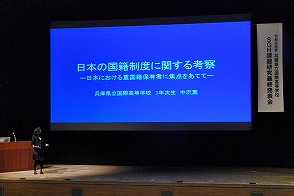 (Picture ⑩)The 3rd-year student talks about why the nationality system should be changed. 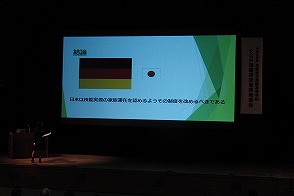 (Picture ⑪)The 3rd-year student talks about the present situation of technical interns in Japan. 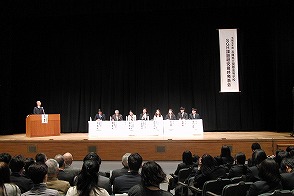 (Picture ⑫)The HIS student get some advice from the panelists. |
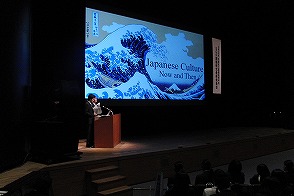 (Picture ① )2nd-year students present Japanese culture. 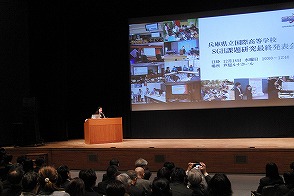 (Picture ②) 2nd-year students present Japanese culture. 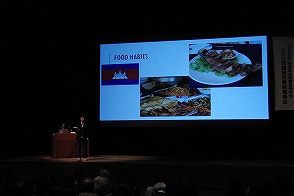 (Picture ③ )1st-year students report on the study tour to Cambodia. 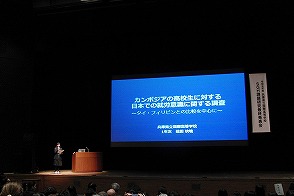 (Picture ④) They report how Cambodian high school students think about working in Japan. 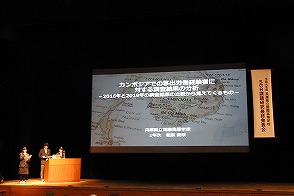 (Picture ⑤)The 1st-year students report surveys of Cambodian immigrant workers. 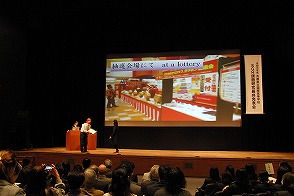 (Picture ⑥) They perform a drama about culture of the world. 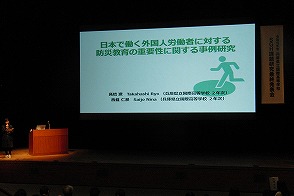 (Picture ⑦ )They talk about the importance of disaster prevention education for overseas people. 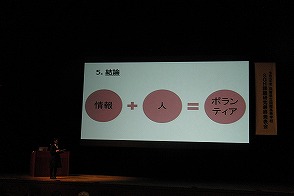 (Picture ⑧) The 2nd-year student talks about how New Zealanders volunteer. 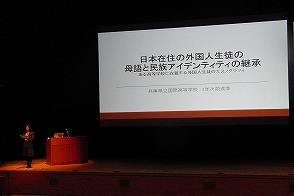 (Picture ⑨)The 3rd-year student talks about how a student from overseas in Japan maintains two cultures. |
| 2019/ 12/7(Sat.) 2nd year (16th) |
SGH 2019 Study Tour at Winter Conference of JAMPS (2nd year) The 2019 Winter Conference of the Japan Association for Migration Policy Studies (JAMPS) was held at Nagasaki University. Three second-year students from Hyogo Prefectural International High School (HIS) took part in it. First, they joined the “Refugee Interest group.” They listened to Prof. TAKIZAWA Saburo, a special advisor to a non-profit organization, Japan for UNHCR (United Nations High Commissioner for Refugees). (Picture ①) He presented his report on specified skilled workers and the refugee status recognition system in Japan. The HIS students got a deeper understanding of how to receive refugees and specified skilled workers from abroad, and had a chance to think about their problems too. Next, a society coalition session was held. Ms. IWATANI, an HIS second-year student, talked about assistance for migrant women who live in Japan, focusing on Japanese language education. (Picture ②) Another HIS second-year student, Ms. SEIMA presented her report on a case study of poverty in regard to immigrant children in Japan and a child cafeteria tackling that poverty. (Picture ③) The other HIS student Ms. SADAYOSHI reported her research on language competency and self-identity of people with mixed Indonesian and Japanese ethnicity.(Picture ④) After their presentations, questions and answers followed. Many experts asked questions, and the HIS students answered them. (Picture ⑤) This was the seventh opportunity in a row for the HIS students to make presentations at a JAMPS conference. Presenting their research at JAMPS conferences has been a good experience for them all. They are hopefully continuing to improve their papers. Next, in the society coalition session, Mr. AKASHI Junichi and Ms. SASAKI Yuka from University of Tsukuba presented their report on developments, challenges, and problems with the ‘job education’ project for settled foreign children at University of Tsukuba. This was a good occasion to think about how to help children of foreign nationality. Then, a plenary symposium was held and the HIS students took part. The theme was Japanese society facing a new era of migration and asking questions about immigration policy based on the actual current situation in Kyushu. The new residence status, “specified skills” has been made, and the participants talked about the problems of accepting more migrant workers in Japan. After the conference, the HIS group went from Nagasaki University to Nagasaki Airport. They went back to Osaka by plane. |
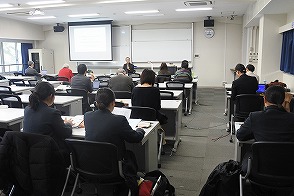 (Picture ①) Prof. TAKIZAWA talks about the 'specified skilled ' workers and refugees in Japan. 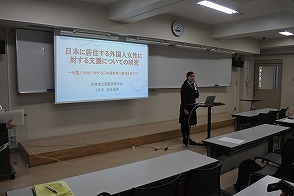 (Picture ②) Ms. IWATANI talks about assistance for migrant women in Japan. 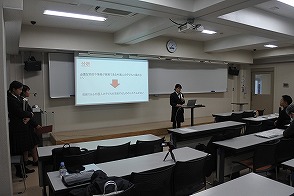 (Picture ③) Ms. SEIMA discusses poor migrant children in Japan. 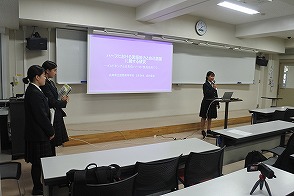 (Picture ④) Ms. SADAYOSHI reports language and self-identity of double ethnicity. 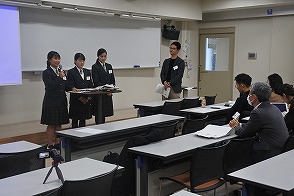 (Picture ⑤)The three HIS students answer some questions from experts. |
| 2019/ 11/16(Sat.) -17(Sun.) 2nd year (16th) |
SGH Study Tour at the 2019 JAHSS・JASID Joint International Conference (2nd year) Two students from Hyogo Prefectural Senior High School (HIS) participated in the 2019 Joint International Conference of the Japan Society for International Development (JASID) and the Japan Association for Human Security Studies (JAHSS). It was held at the Komaba campus of University of Tokyo. On the first day, the two students presented their research in poster sessions held at the MM hall in the Komaba campus. They reported a case study of disaster education for migrant workers in Japan. They focused on migrant workers who live in Japan, and they tried to find out whether local governments or companies hiring migrant workers are offering migrant residents enough disaster education or not in the research. They cited some data to show not many local governments are providing migrant workers with disaster preparedness education. They reported the results of the surveys conducted in Himeji, and they have found that many of the migrant workers have no chance to learn about disaster preparedness. They urged the Japanese government, the local governments, and businesses to offer migrant workers disaster preparedness education so that the migrant workers can be saved when disaster occurs. (Picture ①②) In this international conference, a lot of researchers from abroad listened to the HIS students’ poster presentation, and the HIS students answered the questions from them in English. The HIS students’ poster presentation was evaluated by experts. The HIS students repeated their poster presentation seven times. Some researchers highly evaluated the HIS students’ research because they said that high school students were conducting research about disaster preparedness education for migrant workers, which had never been done before. On the other hand, some mentioned that the research should have a clearer definition of the phrase, ‘disaster preparedness education’, and others gave some advice to the HIS students. The advice will surely help them improve their research. After the poster session, keynote lectures were given in English and the HIS students listened to them. The theme was refugees/migrants and education/employment in the age of global compacts. The lecturers were Dr. Jeff CRISP from the Refugee Studies Centre at University of Oxford, Ms. Eva ÅKERMAN BÖRJE, a senior policy advisor at IOM, and Prof. TAKIZAWA Saburo, former representative of UNHCR Japan Office.(Picture ③) After the keynote lectures, a plenary panel about work and employment was held. The panelists were Mr. Khadiza BEGOMU, a Rohingya refugee and worker at UNIQLO; Ms. FUKUHARA Nobuko, director of Policy Division of Immigration Service Agency at Ministry of Justice; Prof. Jacqueline ANDALL from University of Tokyo; and Mr. SUZUKI Takashi, President of Sakae Foundry Corporation. A report on the actual situation of refugees working in Japan was shared, and the importance of the refugees working in Japan was discussed in a panel discussion in English. The HIS students learned a lot about the current situation and problems with refugees working in Japan. On the second day, regular and special sessions were held. The two 2nd-year HIS students went to different sessions. One of them, Mr. TAKAHASHI, went to a round table about ‘Blockchain and Refugee Protection’ and a round table about disaster preparedness and human security after the 2011 Great East Japan earthquake in terms of resilience. (Picture ④)In the afternoon, he joined a regular session about conflict. The other HIS student, Ms. SAIJO participated in a round table about international development with volunteers, and a thematic session titled, ‘What has JOCV (Japan Overseas Cooperation Volunteers) brought to Development Aid.’ She took part in a regular session on field research on poverty in the afternoon. They learned a lot about migrants and refugees from the latest research. After that, they went to Haneda Airport and flew back home. Later on December 19th, the executive committee of the 2019 Joint Conference gathered and decided to give the HIS pair the JAHSS・JASID Encouragement Prize. |
 (Picture ①)Mr. TAKAHASHI explains their research.  (Picture ②)Ms. SAIJO presents their poster.  (Picture ③)A keynote speech is given.  (Picture ④) The HIS student joins a session. |
| 2019/ 11/14(Thu.) 1st-3rd year (17-15th) |
SGH Special Lecture on How to Realize a Harmousious Multicultural Society (1st-3rd year) All the students of Hyogo Prefectural International High School (HIS) participated in an SGH special lecture on how to realize a multicultural society in Japan where workers from other countries and Japanese people live harmoniously. The lecturer was YAMAWAKI Keizo, a professor of the School of Global Japanese Studies at Meiji University. He discussed: 1. Introduction A) A new era of multicultural society B) Making the most of migrant workers C) A turning point, the year 2014, D) An aging society with fewer children E) Multiculturalism in local communities 2. Problems the local governments tackled: A)1970s B)1980s C)1990s D)2000s E)2010s 3. Problems the Japanese government tackled: A)2006-2013 B)2014-2016 C)2017 D)2018 E)2019 4. Problems other countries tackled: A)Germany B)South Korea C)Taiwan D)Cities’ Networks (Intercultural City, Cities of Migration and Welcoming Network) 4.Conclusion A) Issues to be tackled by the Japanese government B) Educational issues C) Issues to be tackled by local communities D) Issues to be tackled by businesses The lecture was followed by a question and answer session (Picture ②) |
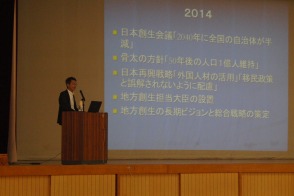 (Picture① )Prof. Yamawaki gives a special lecture. 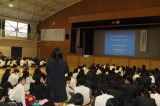 (Picture ②) HIS students ask questions. |
| 2019/ 10/25(Fri.) 1st year (17th) |
SGH Cambodia Study Tour (Day 4) (1st year) On October 25, the HIS students woke up at six, had breakfast, and started their fieldwork. They arrived at Plong village, Siam Riup at nine. The village was the same as the one in which previous HIS students had interviewed villagers on a last field trip in March, 2016. They were welcomed by the mayor and the deputy mayor of the village. The HIS students divided into two groups were led to three families. There the HIS interviewed former migrants. They asked them questions in English, and translators used Khmer to help the HIS students communicate with them. (Picture① ) Seven Cambodian former migrant workers in six families were interviewed. Many of them answered that they had gone to work in Thailand because it was close to Siam Riup. However, most of them answered that they would not like to go to Thailand to work again because they couldn’t earn more in Thailand than in Cambodia, so they would not like to take the risk of working outside their country. The HIS students realized that the economy in Cambodia had grown more since the last interview was conducted. (Picture ②) Among the interviewees, there was a man who had been to Japan. He worked as a technical intern on a farm in Nagano. He sometimes worked between 2:00 a.m. and 17:00 p.m. the next day, earned 150,000 yen to 200,000 yen, and sent about 100,000 yen from his earnings to his parents’ house. He said that with the money he sent, he was going to build a house, let one of his sisters go to university, and let another sister go to senior high school and university. He is now going to a Japanese language school in Cambodia to work as a technical intern in Japan again. The HIS students realized that a migrant’s life and his family’s life depended greatly on the country the migrant worker went to, and expected that a lot of migrant workers would come to Japan from Cambodia. They had a good opportunity this time because they could obtain a lot of data from the interviews. After the fieldwork, the HIS students passed by Angkor Wat and arrived at Siam Riup Airport. They flew via Ho Chi Minh to Kansai International Airport. They were able to finish their Cambodia study tour safely. |
 (Picture① )The HIS students visit Plong village, Siam Riup.  (Picture ②) The HIS students interview Cambodians at Plong village, Siam Riup |
| 2019/ 10/24(Thu.) 1st year (17th) |
SGH Cambodia Study Tour (Day 3) (1st year) On the morning of October 24, the HIS students ate breakfast at the temple in the village of Samor, Takeo. Then, they went to Phnom Penh by car. They arrived at the Northwest Campus of Western International High School (WIHS)at ten past ten. In a third-floor classroom, the HIS students gave a power-point presentation in English to 149 1st-year students of Western International High School. (Picture① ) First they introduced HIS and presented similarities and differences in culture and life between the two countries. When the HIS students explained a Japanese bon dance during summer holidays, they performed a bon dance while wearing yukata, or summer kimono. (Picture ②) Then, the HIS students asked questions about what the Cambodian students thought about working in Japan. After the survey, the HIS students and Western International High School students talked with each other. While the HIS presentation was suspended for a while because of a blackout caused by a fire in the neighborhood, many of the Western International High School students seemed to be interested in Japan, and the students from two schools discussed a lot of things. Each of the HIS students, surrounded by a lot of Cambodian students, talked with them. The HIS students tried to communicate with the Cambodian students by showing items from Japan. They had a good time exchanging their opinions. (Picture ③) Afterwards, the HIS students flew to Siem Reap, concluding the activities for Day 3 of the study tour. |
 (Picture① )The HIS students introduces HIS to WIHS students.  (Picture ②) The HIS students perform a bondance in summer kimono.  (Picture ③) The HIS students make friends with the Cambodian students. |
| 2019/ 10/23(Wed.) 1st year (17th) |
SGH Cambodia Study Tour (Day 2) (1st year) On the morning of October 23, the HIS group moved from the capital of Phnom Penh to Takeo. The HIS students had raised funds, and helped to build a well in a village in Cambodia before. The HIS students checked in on the well. (Picture① )Later, the HIS students met the villagers. Then, the group went to the village of Samor, Takeo. Mr. Howung Korng, deputy executive director of the Khmer Asian Friendship Society (KAFS), explained their activities in this village, and introduced ten local staff members. (Picture ②) After lunch the HIS students played with children who gathered at a temple. The HIS students taught them how to play a Japanese game with their hands and taught them some origami designs. The HIS students tried to communicate with them with a dictionary in hand, and they became more and more friendly. Then, the HIS students divided into three groups visited eleven houses in total to interview people who had an experience of migrating to work overseas. The HIS students asked questions in English, which interpreters put into the Khmer language. Interpreters, then, translated the answers into English for the HIS students. In total, eleven Cambodian people were interviewed. (Picture ③) Although the purpose was to ask the same questions as the HIS students had done on the first Cambodia study tour, they couldn’t interview the same people, because many of the former interviewees who had returned from overseas to Cambodia were working in Phnom Penh, instead of returning to the village of Samor. It has been three and a half years since the last interviews were conducted, and the HIS students found out that the situation of migrant work in Canbodia had changed a lot. After dinner, the HIS students met and talked with the villagers. The students sang the Japanese song Paprika, and danced to the Cambodian song Arapiya, which a Cambodian student taught them at school. He is now studying at HIS through the Asia Kakehashi (Bridge-building) Project hosted by the Japanese education ministry. Later, they enjoyed dancing to Cambodian songs with the local people. The HIS students had a good time with the local people. |
 (Picture① )The HIS students check in on the well.  (Picture ②) Deputy Executive Director , Mr. Howong Korng explains KAFS activities.  (Picture ③) The HIS students interview eleven Cambodian villagers. |
| 2019/ 10/22(Tue.) 1st year (17th) |
SGH Cambodia Study Tour (Day 1) (1st year) On October 22, a group of HIS students on the Cambodian study tour gathered at Kansai International Airport at 20:00 (JST). They arrived at Phnom Penh via Ho Chi Minh at 17:00. The group had dinner with Mr. Rong Chhorng, chairperson of the Khmer Asian Friendship Society (KAFS), and four former Cambodian students that the Japan Asian Association Asian Friendship Society (JAFS) used to give educational assistance to. (Picture① ) The HIS students tried to make themselves understood in English and Khmer, the Cambodian language, using a Cambodian dictionary they had. (Picture ②) Then, Mr. Rong Chhorng gave a lecture on the present situation of migrant work in Cambodia. He talked about Cambodian people who move to work within the country of Cambodia and those who migrate to work in other countries. First, he talked about the movement of workers inside Cambodia. He pointed out that at least one member of each family moved somewhere inside the country in 2013, and that 71 % of the people who were working in Phnom Penh were people who moved to work within the country. Many of them said they migrated for an economic reason--to make money. The second biggest reason was to get education. Next, Mr. Rong Chhorng talked about people who were migrating to work overseas. In the 1990’s, the largest number of Cambodian people went to Thailand, followed by the Philippines, and Malaysia. These days, however, the number of Cambodian people who have gone to Malaysia and Korea is increasing. They find it difficult to go to work in Japan because labor standards in Japan are strict. Then, he answered some questions asked by the HIS students. The HIS students had a good opportunity to learn about the current situation of Cambodian migrants. (Picture ③) |
 (Picture① )The HIS students have dinner with the Chair of KAFS, Mr. Rong Chhorg.  (Picture ②) The HIS students try to communicate with the Cambodian youth.  (Picture ③)The HIS students ask some questions. |
| 2019/ 9/30(Mon.) 1st year (17th) |
SGH ‘Migration Map’ Lecture on the 110-year History of Japanese Migrants
in Brazil (1st year) Mr. NAKAMURA Shigeo, Vice Chair of NPO Regional Cultural Planning, gave an SGH ‘Migration Map’ lecture to Hyogo Prefectural International High School (HIS) 1st-year students. He talked about the 110-year history of migrants between Japan and Brazil to help students draw maps about migrating people between the two countries. He discussed: ① Why Japanese people emigrated to Brazil during the time until 1908 ② How Japanese immigrants in Brazil lived between 1908 and 1945 (Picture① ) ③ How Japanese immigrants in Brazil contributed to Brazilian society ④ Why Japanese Brazilians came to Japan during the time between 1946 and 2019. He then answered several questions from the HIS students. (Picture ②) |
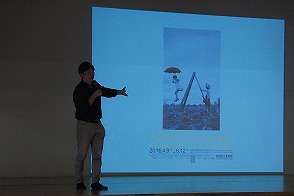 (Picture① )Mr. Nakamura discusses how Japanese migrant people lived in Brazil. 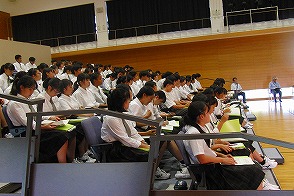 (Picture ②) HIS students ask questions. |
| 2019/ 9/21(Sat.) 1st, 2nd year (17th, 16th) |
SGH Fieldwork in Rokko—-Waku-waku Meeting in Nada (1st, 2nd year) The SGH fieldwork in Rokko, Waku-waku (exciting) meeting in Nada was held, and five students—one first-year and four second-years-- from Hyogo Prefectural International High School (HIS) participated in it. (Picture①) The purposes were to attend the meeting which helped immigrant children to study and to see how the children were assisted there. Another purpose was to interview the organizer of the meeting and the children who were studying there in order to consider the present circumstances and problems about the educational assistance. First, the HIS students listened to the representative of the organization Mr. Murayama. The organization is now assisting 25 children who are from the Philippines, the Commonwealth of Dominica, Laos, China, Vietnam, Nepal, Australia, New Zealand, Thailand, and Pakistan. They range between 6 years old children and third-year junior high school students. There are 16 voluntary supporters in the organization. Many of them used to teach at elementary, junior and senior high school. He mentioned that what was most challenging was to collect funds because the organization does not collect money from the children. However, it depends on funds sent by some groups such as the Hyogo prefectural Japanese language volunteer network, and the money was used to pay for transport costs for the supporters and for teaching materials. In order to help more children, more supporters are needed, but the organization doesn’t have enough funds now. The second problem is to keep enough supporters at hand. Many of the supporters are former teachers but they are getting older and older. The organization asks some groups including Hyogo prefectural International Exchange Association to collect supporters, but it is hard to recruit new members. Mr. Murayama said that younger people including university students would be needed. Next, the HIS students went to see the children helped by the supporters and they also helped the children to study. (Picture ②) On that day, there were twelve children there, and some came to Japan less than one month ago. Some were doing their homework, and others were preparing for entrance exams. The HIS students learned that these children had various kinds of needs that have to be met. By finishing the day’s activities, the HIS students had a good experience in learnning that immigrant children were being assisted close to them and that there were a variety of problems these children face.(Picture ③) Some HIS students who joined the fieldwork that day are now continuing to help children study regularly. |
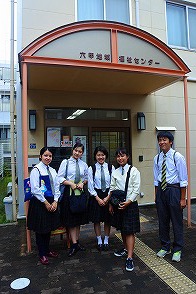 (Picture①) HIS students visit the Waku-waku meeting in Nada. 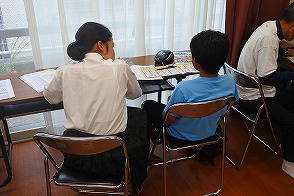 (Picture ②) HIS students help a child to study. 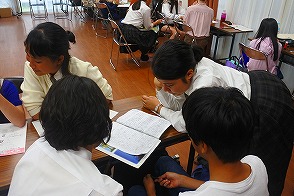 (Picture ③) Children have a variety of needs. |
| 2019/ 9/21(Sat.) 1st, 2nd year (17th, 16th) |
SGH Fieldwork in Rokko—-Waku-waku Meeting in Nada (1st, 2nd year) The SGH fieldwork in Rokko, Waku-waku (exciting) meeting in Nada was held, and five students—one first-year and four second-years-- from Hyogo Prefectural International High School (HIS) participated in it. (Picture①) The purposes were to attend the meeting which helped immigrant children to study and to see how the children were assisted there. Another purpose was to interview the organizer of the meeting and the children who were studying there in order to consider the present circumstances and problems about the educational assistance. First, the HIS students listened to the representative of the organization Mr. Murayama. The organization is now assisting 25 children who are from the Philippines, the Commonwealth of Dominica, Laos, China, Vietnam, Nepal, Australia, New Zealand, Thailand, and Pakistan. They range between 6 years old children and third-year junior high school students. There are 16 voluntary supporters in the organization. Many of them used to teach at elementary, junior and senior high school. He mentioned that what was most challenging was to collect funds because the organization does not collect money from the children. However, it depends on funds sent by some groups such as the Hyogo prefectural Japanese language volunteer network, and the money was used to pay for transport costs for the supporters and for teaching materials. In order to help more children, more supporters are needed, but the organization doesn’t have enough funds now. The second problem is to keep enough supporters at hand. Many of the supporters are former teachers but they are getting older and older. The organization asks some groups including Hyogo prefectural International Exchange Association to collect supporters, but it is hard to recruit new members. Mr. Murayama said that younger people including university students would be needed. Next, the HIS students went to see the children helped by the supporters and they also helped the children to study. (Picture ②) On that day, there were twelve children there, and some came to Japan less than one month ago. Some were doing their homework, and others were preparing for entrance exams. The HIS students learned that these children had various kinds of needs that have to be met. By finishing the day’s activities, the HIS students had a good experience in learnning that immigrant children were being assisted close to them and that there were a variety of problems these children face.(Picture ③) Some HIS students who joined the fieldwork that day are now continuing to help children study regularly. |
 (Picture①) HIS students visit the Waku-waku meeting in Nada.  (Picture ②) HIS students help a child to study.  (Picture ③) Children have a variety of needs. |
| 2019/ 8/26(Mon.) 1st, 2nd, 3rd-year (17th, 16th, 15th) |
2019 SGH Fieldwork @ Himeji (1st-3rd year) 11 first-year students, 5 second-year students, and 1 third-year student from Hyogo Prefectural International High School (HIS) participated in the 2019 Fieldwork in Himeji. The purpose was to visit the same companies in Himeji which the HIS students visited in 2016 and to look into the present situation of the companies and immigrant workers. In 2016, the HIS students conducted a survey on immigrant workers who were working in those companies. Another purpose was to have a chance to consider more about accepting immigrant workers. First, they visited Sawada Precision Company. (Picture ①) They listened to the introduction of the company. It has been employing 7 immigrant workers out of 82 employees. Three immigrant workers out of the seven have the status of residence named ‘Engineer / Specialist in Humanities / International Services’ , (an ‘Engineer/Humanities visa’ in short) and four have the status of residence named ‘technical intern training’. Those three workers with the engineer/humanities visa are employed as full-time workers. The immigrant workers are all from Vietnam. The reason why the company started to employ people from other countries is that in 2012 when the new president took office and a large number of workers left the company, he started to accept technical intern trainees from Vietnam. Since then, the company has employed 16 Vietnamese intern trainees in total. Sawada Precision Company opened its factory named ‘Sapan’ in Vietnam in 2018. Among those who were employed for the first time in 2012 was Mr. Minh. He said in the 2016 interview with HIS students that he would like to make a company similar to Sawada Precision Company back in Vietnam. He cooperated greatly with Sawada Precision Company and helped it open a factory in Vietnam. Next, the HIS students went to look around the company. (Picture ②) The international workers were working together with Japanese people at each section. After that, the HIS students interviewed two Vietnamese workers in the company. (Picture ③) One was a person Mr. S, with whom the HIS students had an interview in 2016. He has an Engineer/Humanities visa. He asked his wife and three-year-old child to come to Japan from Vietnam, and has lived in Japan together since 2018. When asked what troubled him most in Japan, he answered the Japanese language, because he had trouble communicating in Japanese when he brought one of his family members to a hospital. In the interview he said he would like to open and work for a factory ‘Sapan’ in Vietnam. The other person the HIS students interviewed was a female technical intern trainee from Vietnam. When she was asked what was a trouble for her in Japan, she said it was difficult to learn Japanese. She said that though she had studied Japanese by herself, she had difficulty learning Chinese characters. She said that if she was back in Vietnam she would not be sure whether she would stay in Vietnam or she would come to Japan again to work. After lunch, the HIS students visited Kajiwara Iron Works Co. ltd. First they heard the introduction of the company. (Picture ④) The company has 10 immigrant workers among 98 employees. Out of these ten, nine workers are from Vietnam, and one person is from China. Eight of them are technical intern trainees, and two have the engineer/humanities visa and are full employees. The reason why the company started to employ immigrant workers was that Japanese employees were becoming older and there were not enough young employees in the company. Therefore, it employed six Chinese technical intern trainees in 2003. Recently, the number of Chinese technical intern trainees has been decreasing because of China’s economic development, and the company has started to accept technical intern trainees from Vietnam. This year, the resident status ‘specified skills’ was created, allowing companies to continue employing technical intern trainees. When the managers at Kajiwara Iron Works were asked whether they would like to go on employing technical intern trainees, they answered that they would do so if a trainee is an industrious worker. Next, the HIS students interviewed immigrant workers from Vietnam working at Kajiwara Iron Works. (Picture ⑤) They interviewed Mr. L, whom the other HIS students had an interview with in 2016. Mr. L took an interview test in the STEP HARIMA in HANOI project hosted by the Himeji Employers’ Association, passed it and got employed in Japan. He has an engineer/humanities visa. He married a Vietnamese woman this April, and is going to have a baby next year. He has been living in Japan with his family. He says that he would like to live with his family in Japan until his child becomes 18 years old, because he wants his child to get an education in Japan. He says that after his child turns 18, Mr. L will return to Vietnam to help the country to develop more. The HIS students interviewed another 27-year-old male worker who has an engineer/humanities visa. He got employed this year. He says that he misses his parents and brother in Vietnam, but he hopes to work in Japan for a long time. The HIS students found that there was a big change between the interviews in 2016 and the ones in 2019 held at two companies they visited. That difference was that an immigrant worker was single in 2016 when he came to Japan, but now he is hoping to ask his family to come to Japan and will stay together in Japan for a long time. When the students finished their activities, they went back to school by bus.(Picture ⑥) |
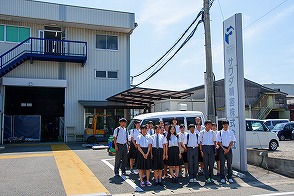 (Picture ①) HIS students visit Sawada Precision Company. 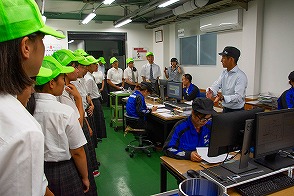 (Picture ②) HIS students look around the company. 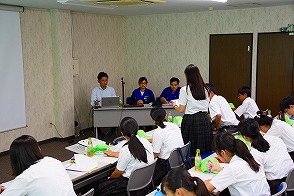 (Picture ③) The students interview Vietnamese workers. 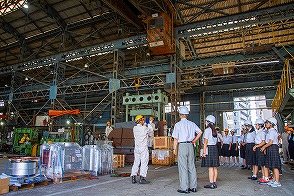 (Picture ④) HIS students visit Kajiwara Iron Works. 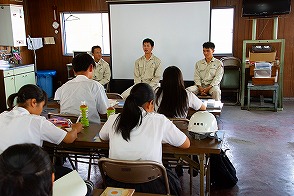 (Picture ⑤) They interview Vietnamese workers. 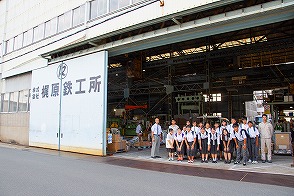 (Picture ⑥) HIS students stand at the factory. |
| 2019/ 8/1(Thu.) 2nd, 3rd-year (16th, 15th) |
2019 SGH Study Tour @ Kwansei Gakuin University (2nd , 3rd year) Two HIS second-year and three third-year students went on a 2019 study tour at Kwansei Gakuin University. The purpose was to participate in the workshop titled ‘Using AI for SDGs---WWLC(Worldwide Learning Consortium) leading project’, and to work out solutions to problems about the HIS’ immigration research by using Artificial Intelligence (AI). First, Mr. NINOMIYA Testuya made a keynote speech about the use of AI. He said that agricultural products are tagged with IC chips and that AI is used in the management systems of products and in the analysis of the merchandise’s channels. He talked about the possibility that society would advance through the use of AI. Next, two lectures about how to utilize AI to achieve sustainable development goals (SDGs) were given. Mr. SHINYO Takahiro talked about using AI in architectural technology in order to achieve SDGs goal 11, ‘sustainable cities and communities’. Mr. MIWA Hiroyoshi talked about the outline of AI technology and the utilization of AI. He emphasized the importance of solving problems in real society by making use of AI. In the afternoon, participants worked in groups. (Picture ①) The participating high school students made groups of five, and discussed how to use AI to solve problems. HIS students who had been researching the relationships between the promotion of the female workforce and the employment of international workers participated in group work to realize gender equality. They shared their research results with other members and had positive discussions. The HIS student who was researching how to give assistance to people in Japan from other countries at the time of disaster shared her data in the group and discussed ways to pursue world peace. Other HIS students joined a group which aimed to solve poverty. After that, each group presented the results of their discussion. Many of the HIS students volunteered to present what each group discussed, and were highly praised for that by the students and teachers of Kwansei Gakuin University (KGU). (Picture ②) The HIS students researching immigration had an excellent chance to think about how to solve problems by using AI |
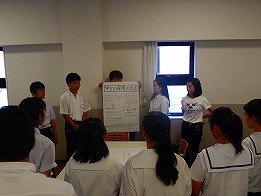 (Picture ①) Participans work in groups. 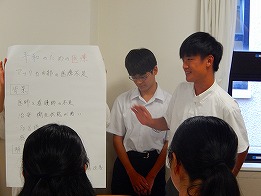 (Picture ②) HIS students report their discussion. |
| 2019/ 7/18(Thu.) 1st-year (17th) |
SGH Study Tour @ 3 Universities (1st year) 120 Hyogo Prefectural International High School (HIS) first-year students went on a study tour to three universities. (1) Study Tour at University of Hyogo (UH) Forty students from HIS joined a study tour at University of Hyogo (UH). They travelled from HIS by bus to the Kobe campus for commerce. A staff member at UH’s School of Economics and Management (SEM) introduced the HIS students to the SEM department. In the 2019 school year, HIS and UH’s SEM were designated as cooperative schools for promoting projects between high school and universities connection reforms. He explained that in these projects both institutions are going to specialize in dealing with the global environment. Educational resources at UH will give advanced studies to HIS students to help them attain a very high command of English and a better global perspective. Next, Mr. Gong YUAN-YUAN, a UH lecturer at the school of economics and management and the school of social information science, lectured on the topic, “Should the taste of Coca-Cola be different from country to country?” First, he explained globalization. He said that globalization is the movement of people, goods, money and information across national borders and the process of integration among cultures, markets and economies. In the globalizing world, similar goods and services become popular all over the world, and as all countries have cultural, institutional, and economic differences, it becomes an important strategy for a company to meet the needs and tastes of local people. He insisted that people should consider local customs and religions in order to develop products. Lastly, he said that when the world is being globalized, it is important to realize that we have people with various backgrounds and to accept these varieties. After the lecture, two graduates from HIS talked about their university life. They told the HIS first-year students that it would be very important for the first-year students to maintain and develop the things they learn in the first year of HIS life for the future. After that, they had a meal at the UH cafeteria, went around the campus, and came back to the HIS by bus. (2) Study Tour at Kobe City University of Foreign Studies(KCUFS) Forty first-year students from Hyogo Prefectural International High School (HIS) participated in a study tour at Kobe City University of Foreign Studies (KCUFS). They went by bus to the university. After they listened to a presentation about the university, they attended a lecture by Mr. OTA Yusuke, an associate professor of the General Culture Course. He talked about France, a migration society, based on the viewpoint of the second generation. First, he mentioned that France has the birthright citizenship, so there are people born in France to parents who are not French. They are called ‘the second-generation immigrants.’ He said that there was a discussion about the definition of who was the French in 1980’s. Do French people mean only pure French people, or do they include mixed French people? ‘Pure French people’ blamed the second-generation ‘mixed French people’ for ‘stealing their bread.’ Unlike their parents, the second-generation French people had no home countries to go back to except France,and they had cultures different from those of their parents. Nevertheless, the second-generation French people were denied in France where they were born, and told to ‘go back home’ in discrimination against them. As they don’t know about their parents’ home country and are not allowed to regard France as their own home country, they would have a problem with losing their identities. He pointed out that the immigration control law was revised in 1990 in Japan, and that second-generation immigrants would appear. They were going to live between their parents’ home countries and Japan. When the second-generation Japanese people consider what they should think about having been born in Japan and how they should live in Japan, they should keep the 1980’s French examples in mind. As the HIS first-year students have been researching France’s migration policy, they learned a lot from the lecture. They will hopefully use this experience to improve their skills in an SGH debate. After the lecture, they had lunch at the university, and went on a campus tour. Then, the HIS students met with HIS graduates who were currently studying at KCUFS. Three graduates came to meet the HIS students. Some conducted SGH research when they were at HIS. They advised the first-year HIS students about SGH research and gave them some encouraging words. After the meeting, the HIS students went back to school by bus. (3) Study Tour at Ritsumeikan University Forty 1st-year students from HIS participated in a study tour at Ritsumeikan University. They traveled from HIS by bus to the university’s Kinugasa campus. First, they attended a lecture by Mr. YONEYAMA Hiroshi, a professor from the College of Letters at Ritsumeikan University. The title of his lecture was ‘Reconsidering ‘Borders’ and ‘Movements’.” First, he asked the HIS students about questions about school screening: Who can enter school and who is qualified for entering school? How can they be regarded as being qualified or not being qualified? Are people with no qualification allowed to enter school? Next, he showed examples from a station; who can enter the station and who is qualified for entering the station? How can they be regarded as being qualified or not? Are people with no qualification allowed to enter the station? Professor YONEYAMA said that people think that places with borders have their own meaning, but it is not the case, and the reality is opposite. He explained that meaningful borders are set in order to control the movements of people. Next, he talked about why people make ‘borders.’ He said that human societies set territories and ‘borders’. Human societies have various ‘borders’ such as ‘national borders’ and ‘nationalities’. ‘National borders’ and ‘nationalities’ are systems to control people. Those systems are made to separate citizens and non-citizens, and separate illegal foreign people from legal foreign residents. The systems to make illegal people are ‘national borders’ and ‘nationalities’. He said that they were all made by advanced countries. He mentioned that people separated with ‘national borders’ and ‘nationalities’ are facing discrimination, and that that kind of discrimination should be abolished but the reality is that the discrimination remains as it is. Next, he talked about emotional barriers and the concept of citizenship. He asked the HIS students whether there were pure Japanese people in Japan. Japanese people have moved since the ancient times, and some Japanese people come from other continents, and others come from the south. He showed a picture of one woman, and asked the students what kind of a person she was. He said that she was a Japanese American. He pointed out that there are people who seem to be Japanese but who are not Japanese in fact. He said that she had difficulty with her identity. Lastly, he mentioned that the true meaning of researching ‘migrating’ people was to open your own ‘world’. He emphasized that ‘to live together’ means not to ‘accept migrants’ but to live together equally. The lecture was a good occasion to consider what ‘migrants’ mean. The first-year HIS students are going to talk about the United States of America and France in debates, so it was very helpful. After the lecture, the HIS students met with HIS graduates who were currently studying at Ritsumeikan University. They advised the first-year HIS students about SGH research and gave them some encouraging words. After the meeting, the HIS students went on a campus tour and had lunch. They went back to school by bus. |
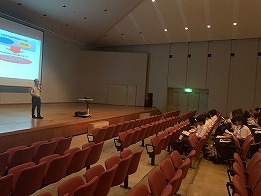 (Picture ①) A UH staffer talks about SEM. 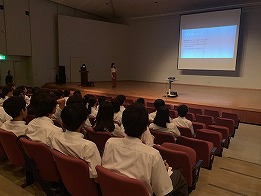 (Picture ②) A UH lecturer talks about globalization. |
| 2019/ 7/12(Fri.) 1st, 2nd, 3rd-year (17th, 16th, 15th) |
SGH Special Lecture: The Present Situation of Refugee Assistance in Japan—in
order to Understand Refugees Correctly― (1st-3rd year) Mr. TAKIZAWA Saburo, a special advisor at the non-profit organization, Japan for the Office of the United Nations High Commissioner for Refugees (UNHCR) , and a guest professor at the Graduate School of Toyo Eiwa University gave an SGH special lecture to all the Hyogo Prefectural International High School (HIS) students. The theme was learning about the present situation of the refugee assistance in Japan in order to understand refugees correctly. (Picture①) His main points included: ① What is a research paper? ② Part 1: Refugee issues in the world 1)What are the problems? (Picture ①) 2)What are the causes? 3)What are some possible solutions? (Picture ②) ③ Part 2: Refugee issues in Japan 1)What are the problems? 2)What are the causes? 3)What are some possible solutions? ④ What can we do? He answered several questions from the HIS students during the question and answer session that followed his lecture. (Picture ③) 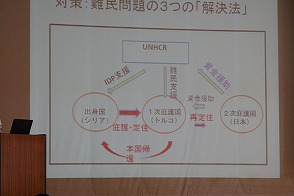 (Picture ②) Three possible solutions to the refugee issues are suggested. |
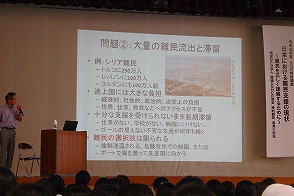 (Picture①) What are refugee problems in the world? 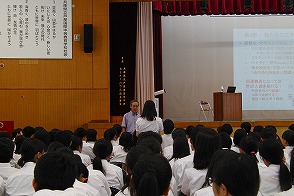 (Picture ③) An HIS student asks a question. |
| 2019/ 7/5(Fri.) 2nd-year (16th) |
SGH Presentation @ Nishinomiya Municipal Nishinomiyahama Junior High School
(2nd year) Four 2nd-year students from the English Speaking Society (ESS) at Hyogo Prefectural International High School (HIS) gave presentations on HIS Super Global High School (SGH) activities to eighty 3rd-year students at Nishimomiya Municipal Nishinomiyahama Junior High School. The presentations were carried out both in English and Japanese. First, the HIS students introduced their school, including activities such as learning a second foreign language besides English, going on an overseas study trip in the second year, and joining club activities.(Picture①) Next, they performed an English play. In the play, an HIS student goes on a trip to China, Korea, and Brazil. During the trip, the HIS students asked some quiz questions, and the junior high school students answered them. (Picture ②) After the presentations, there was a question and answer session, and the HIS students answered the junior high school students' questions. This was the second time that the HIS students presented their SGH research Nishinomiyahama Junior High School. The students of both schools had a good chance to interact with each other. 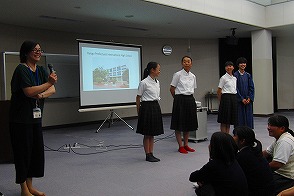 (Picture③) The HIS students answer questions. |
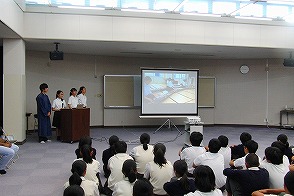 (Picture①) The HIS students introduce their high school. 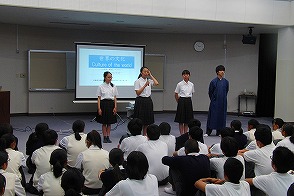 (Picture ②) The HIS students introduce different cultures in a play. |
| 2019/ 6/24(Mon.) 1st- year (17th) |
SGH Project: Debate (Final) (1st year) The first-year students' debate final was held. The affirmative team, Group C from Class 2, and the negative team, Group A from Class 2, had the highest scores during the preliminary rounds, so they competed against each other in the final round of the debate. The theme of the debate was that Japan should adopt the migrant policy from France, not the one from America. The affirmative side argued: 1. The French policy of equality enables migrant people to face no discrimination in life and it leads to a society where people and migrant people can live peacefully together. 2. France’s reception and integration policy (contrat d'accueil et d'integration=CAI) asks migrant people in France to acquire a certain level of knowledge about France and the French language so that foreign people can improve their academic level and skills. As a result, the number of highly skilled migrant people will increase. 3. Income support (Revenu de solidarité active =RSA) for unemployed people helps migrant people to become socially and economically independent.(Picture① ) The negative side argued: 1. The United States of America has a system which helps children of migrant people get education. 2. The U.S. has a system which makes migrant people more motivated to work. 3. Migrant people in the U.S. have a financially and economically good effect on local communities and the whole nation.(Picture ②) Both teams showed their own evidence to support their arguments, and debated each other. (Picture③) The other first-year students and Professor TOBA from the School of Sociology at Kwansei Gakuin University and Chief Supervisor KOIKE Hironao from the Human Rights' Education Department of Hyogo Prefectural Board of Education judged the debate, and the affirmative side won. After the debate, Professor Toba and Chief Supervisor Koike commented on the debate. (Picture④) 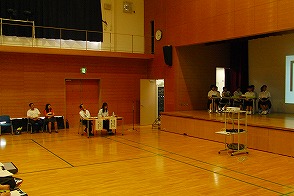 (Picture④) Two judges make comments. |
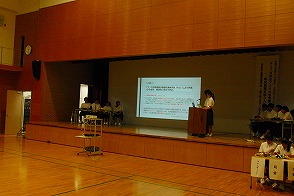 (Picture① )The affirmative side gives a constructive speech. 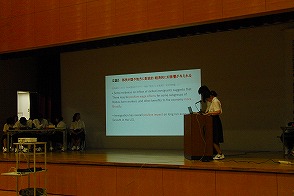 (Picture ②) The negative side gives a constructive speech. 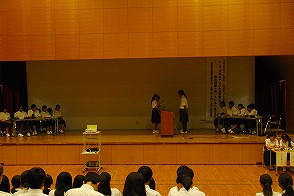 (Picture③)They question each other. |
| 2019/ 6/7(Fri.) 1,2 year (17th, 16th) |
SGH the First Lunch-Hour Street Preaching-Style Open-Air Lecture (1st & 2nd year) During the lunch hour on June 7, twenty-three first-year students, who were leaders and sub-leaders of the debate groups this year, listened to five second-year students who debated last year ---two on the affirmative side and three on the negative side -- in the PC room. There were two main reasons for this event. One was to give some advice about debate to the first-year students who were going to join a debate contest. The other was to help them perform better. First, the second-year students both on the affirmative side and on the negative side gave their constructive speeches from the last year’s finals. Next, the second-year students gave a few pieces of advice. One second-year student advised, “It is important to prepare a lot of evidence, but it is more important to make your points easy for the audience to understand.” Another second-year student suggested that debaters should not just read a script. They should make eye contact with the audience while debating. The first-year students listened to these pieces of advice attentively. It was certain that the first-year students learned a lot from the second-year students’ advice. |
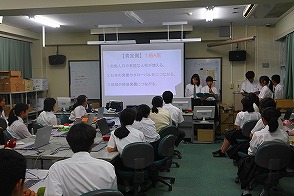 (Picture① )The affirmative side gives a constructive speech. 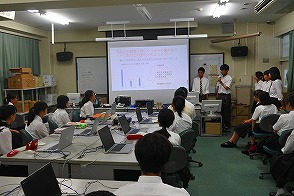 (Picture ②) The negative side explains. |
| 2019/ 6/1(Sat.)-2(Sun.) 1,2 year (17th, 16th) |
SGH Study Tour @ the National Solidarity Forum with Migrants, Tokyo ,Japan
2019 (1st & 2nd year) Thirty-six students (twenty-six 1st-year students and ten 2nd-year students) from Hyogo Prefectural International High School (HIS) and three teachers went on a study tour to participate in the National Solidarity Forum with Migrants, Japan Tokyo, 2019, which was held at the Japan Education Center in Tokyo.(Pictures ①) On the first day, two famous people talked about their lives. One was Yano David, a musician and the representative of ‘Enije’, an education support group in Ghana. He was born to a Japanese father and a Ghanaian mother in Ghana, and then came to Japan. He experienced a lot of difficulties in Japan. He also visited Ghana. Through these experiences, he thought that he should live his own life instead of struggling to adjust to people around. The other was Sahel Rosa, an actress and TV personality. She was born in Iran, was taken to Japan by her step mother when she was eight, and she went through a variety of difficulties in Japan. In spite of her hardships, some Japanese people were kind to her and helped her overcome such situations. Ms. Sahel Rosa now asks Japanese people to be kind to migrant people and to ask migrant people who seem to be in trouble if they are all right.(Pictures ②) After their talks, people were separated into 15 subgroups to discuss 15 different topics such as: migrant women, technical trainees, and hate speech and discrimination. The HIS students learned about various problems in which migrant people were involved. (Pictures ③) In the morning of the second day, there was a plenary session at the Japan Education Center. The theme was how people should make an immigration policy and what it should be like. First, Ms. SUZUKI Eriko, a vice representative board member of the National Solidarity Network with Migrants(NSNM) and professor at Kokushikan University, explained the 2018 renewed immigration control law and how people should deal with it. Next, Ms. TAKAYAMA Sachi, an NSNM board member and associate professor at Osaka University, explained a booklet made by the NSFM titled ‘Immigration Society—Twenty Proposals.’ (Pictures ④) Then a discussion was held by three people—Angelo ISHI, I Sonhi, and KIN Ryusuke. Mr. Angelo Ishi is a professor of the social department at Musashi University. He was born in Sao Paulo, and then came to Japan. Ms. I Sonhi is a researcher of the Center for Northeast Asian Studies at Tohoku University. She was born in Seoul, Korea, and came to Japan in 1994. Mr. Kin Ryusuke is a lawyer, and a third generation Korean in Japan. They talked about what they thought would be the most important thing from their points of view if an immigration policy was to be made in Japan.(Picture ⑤) Finally, the appeal of the National Solidarity Forum with Migrants, Japan Tokyo, 2019 was adopted, and the forum was closed. After the forum, some HIS students were interviewed in an NSFM-related radio program. (Picture ⑥) Then, the HIS students went back to Osaka. 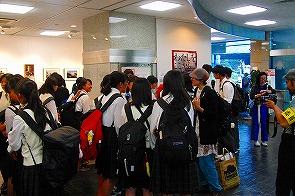 (Picture ⑥) ラジオ番組でインタビューを受ける県立国際生 |
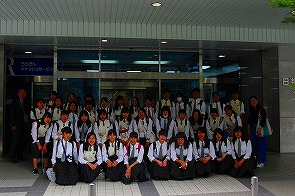 (Pictures ①)The HIS students gather in front of the Japan Education Center. (Pictures ①)The HIS students gather in front of the Japan Education Center.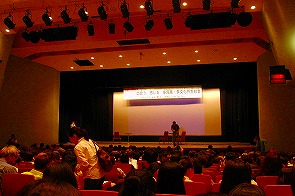 (Pictures ②)Yano David and Sahel Rosa talk about themselves. 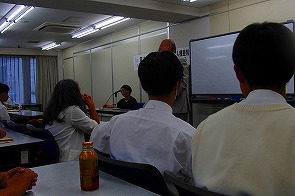 (Pictures ③)The HIS students join sub-group discussions. 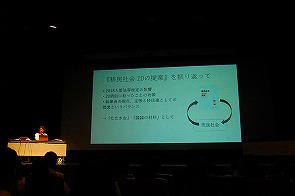 (Pictures ④)The NSNM book is introduced. 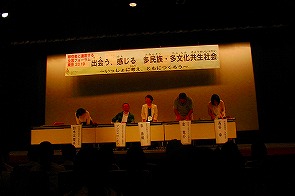 (Picture ⑤)Three people talk about what would be important in making an immigration policy in Japan. |
| 2019/ 5/24(Fri.) 1,2 year (17th, 16th) |
SGH Report on Study Tour in the Philippines (1st & 2nd year) Twenty students from Hyogo Prefectural International High School (HIS) who had participated in the study tour in Thailand in November 2018 reported on it to 1st-year and 2nd-year students. They presented: 1) an introduction of Japanese culture and their school, and the results of their SGH research, which were given at the presentation when they visited Ateneo de Manila University. 2) the results of the survey conducted at the university. (Pictures ①~④) Next, Ms. Nagano, a third-year student who won the second place merit award in a section of the round-table discussion at the 2019 SGH Koshien, talked about why she participated in the discussion and what she discussed.(Picture ⑤) Finally, it was announced that the destination of the 2019 SGH study tour abroad would be Cambodia.  (Picture ⑤)Ms. Nagano talks about her discussion at the 2019 SGH Koshien. |
    (Pictures ①~④)20 students on the 2018 Philippine study tour show their presentations. |
| 2019/ 4/22(Mon.) 1st year (17th) |
SGH Keynote Lecture: Migration Studies—From the Perspective of ‘the Movement
of the Peoples’(1st year) Professor Emeritus TSUDA Mamoru of Osaka University and Nagoya University of Foreign Studies gave an SGH keynote lecture to Hyogo Prefectural International High School (HIS) students. He lectured on migration studies from the standpoint of the movement of people in the world. He talked about: 1) diaspora studies, 2) the movement of people, 3) human beings’ movement and their journey over the course of their lives, 4) the ‘Immigration Control’ and ‘Refugee Recognition’Act by the Japanese government, 5) a family’s present, past and future, 6) Mr. TSUDA Mamoru’s personal history, and 7) the TSUDA family’s story. All the first-year students listened to his lecture. After the lecture, he answered questions from HIS students. 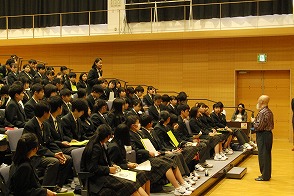 (Picture ③) An HIS student asks him a question. |
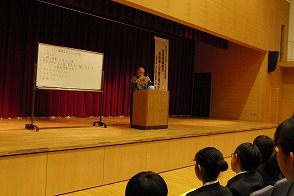 (Picture ①) Professor Emeritus Tsuda talks about the movement of people. 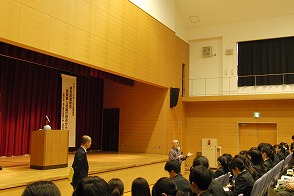 (Picture ②)HIS students listen to his talk. |
| 2019/ 3/23(Sat.) 1,2nd year (16,15th) |
2019 SGH Koshien --Second Place in the Round-table Discussion (1st, 2nd year) The 2019 SGH Koshien, the National Super Global High School Research Presentation, was held at the Uegahara campus of Kwansei Gakuin Universtiy. About 2,400 people from 109 schools and other places from all over Japan attended. Ten students --one second-year student and nine first-year students-- from Hyogo Prefectural International High School (HIS) participated. (Picture ①) After an opening ceremony was held in the Central Auditorium, a round-table discussion was held in the G wing. HIS second-year student Ms. Nagano, who had passed the first screening, joined the discussion. The theme was what problems will come up when Japan tries to have women work more in society and how Japanese people can solve these problems. Six students from six schools discussed how to solve the problems. (Picture ②) First in each group, a moderator, a presenter, and a reporter were decided. Ms. Nagano became a presenter voluntarily. After that, a discussion about the theme was held. Ms. Nagano from HIS talked about what problems arise when women in Japan work more in society. She used concrete data to show that few Japanese husbands were expected to help with housework, and that although women’s employment rate is growing, most of them are employed as part-time workers. She also cited data to show that as more house workers were employed in European households, more women were employed outside. In conclusion, Ms. Nagano proposed that house workers from other countries should be employed in Japanese houses to free up Japanese women to work outside. In a group discussion, some suggested introducing a ‘Papa Quota system’, and others suggested further promoting gender education further to solve these problems. Ms. Nagano asked them questions with her specific data to have a further discussion. After the discussion, she summarized these opinions and solutions and presented them. Judges commented that each student had their own data, and that they discussed the theme very well. The HIS group of nine first-year students presented their research poster in a poster presentation. They presented case studies about migrant workers in the Philippines who had worked in Japan. They also talked about what Japanese people should keep in mind when accepting migrants. They reported what they learned from interviews they conducted with migrant workers in the Philippines in 2018, and they discussed problems and solutions. After their five-minute presentation, they answered questions. (Picture ③④) In the award ceremony, awards were given to the winners in each section. In a section of the round-table discussion, the HIS second-year student, Ms. Nagano, won a merit award (the second place). It was a great pleasure that her efforts were rewarded after she had actively researched migration and presented her report at the Japan Association for Migration Policy Study. (Picture ⑤⑥) Each student became more confident because they reported their research at a national presentation, and they will certainly be motivated to go on working on their next study. They also learned a lot from other research studies by other high school students.   (Picture ⑤⑥) Ms. Nagano comes in second place in the round-table discussion. |
 (Picture ①)The ten students from HIS attend the SGH Koshien.  (Picture ②)Ms.Nagano(2nd year) proposes a solution.   (Picture ③④)The first-year students present their poster. |
| 2019/ 2/23(Sat.) 1,2nd year (16,15th) |
SGH Presentation in Ashiya City: HIS Project to Discover Historical Things
about Japanese Emigration (1st, 2nd year) At Ashiya City Kamimiyagawa Culture Center, fifteen 1st-year and 2nd-year students of the project team from Hyogo Prefectural International High School (HIS) presented the results of their research activities. (Picture ①) The students were conducting Super Global High School (SGH) research concerning a project to discover historical things about Japanese migrants who emigrated from Japan to Brazil. This presentation was cohosted by Ashiya City and HIS in order to inform more people of the results of one of the SGH research activities conducted by HIS. Forty citizens from children to adults attended the presentation. First, the HIS jazz band played music to welcome them, and then the HIS students showed a short documentary movie titled 'KISEKI or Trajectory', which was about a Japanese woman who had emigrated to Brazil. (Picture ②) This movie was produced in cooperation with various institutes after the HIS students collected historical materials such as documents and pictures about Japanese migrants to Brazil. HIS students interviewed Japanese people who had migrated to Brazil to learn about the situation of their emigration and the pains they endured at emigration sites. When this movie was produced, Ms. WAKABAYASHI Akane, a filmmaker who lives in Ashiya, cooperated with the HIS students. The audience seemed to be very interested in this film. Next, the HIS students presented the history of Japanese emigrants to Brazil. The first presentation was about why Japanese people migrated to Brazil. The HIS students explained why the Japanese people went to Brazil, focusing on economic situations in Japan and Brazil and international trends. (Picture ③) Next, the HIS students talked about the Japanese emigrants’ way of living, focusing on what they wore, what they ate, and where they lived. The HIS students showed slides with pictures showing how migrants started to live in Brazil, and then some HIS students wore the clothes emigrants had used and showed them to the audience. Lastly, the students presented how the Japanese emigrants ate in Brazil. They explained what characteristics the migrants’ eating habits had in each decade, how the Japanese migrants ate, and what influence the Japanese food had on Brazilian society. (Picture ④) After the presentations, the HIS students showed their posters in the hall, and answered questions from the audience. (Picture ⑤) The HIS project team had been working on this project for two years, and they had a very meaningful time 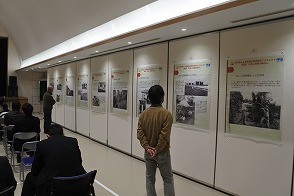 (Picture ⑤)Their posters are presented in the hall. |
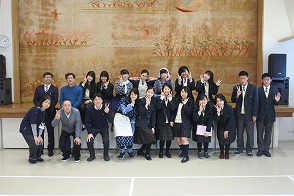 (Picture ①) Fifteen students from HIS attend the presentation. 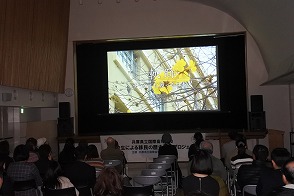 (Picture ②) A short film about emigration is shown. 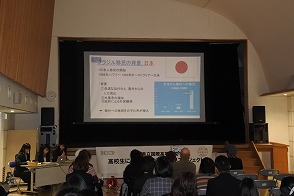 (Picture ③)The HIS students explain why Japanese people emigrated to Brazil. 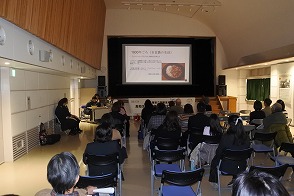 (Picture ④)The HIS students talk about Japanese food in Brazil. |
| 2019/ 2/19(Tue.) 1,2nd year (16, 15th) |
2019 SGH Fieldwork in Hamamatsu (Day 2) (1, 2nd year) On the second day of the 2019 fieldwork in Hamamatsu, the HIS students visited Hamamatsu Foundation for International Communication and Exchange (HICE). (Picture ①)The main purpose was to learn about activities by HICE, which was playing a major part in Hamamatsu City with its multicultural coexistence policy, and to have a chance to think about Japan’s migration policy from now on. Another purpose was to interview Japanese Brazilian workers at HICE and learn about the present situation of Japanese Brazilians. First, the HIS students learned about what HICE was doing. (Picture ②)HICE was established as a parent organization for the promotion of international exchanges and multiculturalization in Hamamatsu City thirty-six years ago. HICE has two main facilities—the Hamamatsu Intercultural Center and the Hamamatsu Foreign Resident Study Support Center. Hamamatsu City now has a lot of international residents from Brazil, the Philippines, Vietnam, China, and Peru. The Hamamatsu Intercultural Center has been conducting six kinds of activities-- consultation and information provision, local interculturalism, disaster prevention in the intercultural community, personnel development, intercultural city development, and support of intercultural activities. In addition, Hamamatsu City has provided foreign residents with support of language and mental care. Next, the HIS students interviewed two Japanese Brazilians—Ms. Shimone OKADA and Mr. Chit OSHIMA, who were second-generation Japanese Brazilians in their fifties. Both came to Japan in 1991, and became naturalized and were given Japanese nationality. They answered, however, that they considered themselves to be completely Brazilian, people who were found to identify as Brazilians. When asked why they became naturalized, Ms. Okada answered that although she had wanted to go back to Brazil, she got Japanese nationality because she had to take care of her three children and live in Japan, since the children were born in Japan. On the other hand, Mr. Oshima said that he fnaturalized in Japan because he found it troublesome to renew his visa and wanted to live and work in Japan. When he was asked what kind of help he needed while working in Japan, he answered that he hoped for a better working environment. Both came to Japan more than twenty years ago, and have had a lot of different kinds of work. Still they have their work contract renewed every year, so the HIS students realized how important it was to help immigrants get jobs. Later they looked around the HICE facilities. The HIS students found information magazines and pamphlets in various kinds of languages for migrants placed all around, and the students realized that multicultural coexistence had been promoted. After all the activities were over, they arrived at Shinosaka Station and went home. |
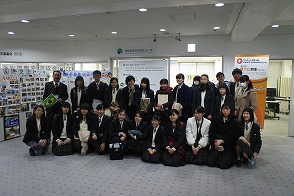 (Picture ①) HIS students visit HICE. 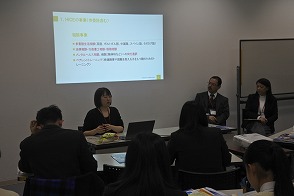 (Picture ②)HIS students learn about HICE activities. |
| 2019/ 2/18(Mon.) 1,2nd year (16, 15th) |
2019 SGH Fieldwork in Hamamatsu (Day 1) (1,2nd year) Twenty-three 1st- year and 2nd-year students from Hyogo Prefectural International High School (HIS), who had been conducting a project to discover historical things about Japanese emigration to Brazil, participated in the 2019 fieldwork in Hamamatsu. On the first day, the HIS students visited Hamamatsu Gakuin University (HGU). (Picture ①) The purpose was to report the results of the research about the project to Associate Professor MITSUYASU Aparecida Mitsue and ask for her advice in order to give better presentations, which were going to be given at Ashiya City Kamimiyagawa Culture Center on the 23rd of February. In addition, the HIS students were going to attend Ms. MITSUYASU’s lecture to learn about the present situation of Japanese Brazilians and to have a chance to consider how all people can live together. At the same time, the HIS students aimed to improve their further research by interviewing Japanese Brazilians who are studying at Hamamatsu Gakuin University. First, the HIS students presented their research titled “A project to Discover Historical Things about Japanese Migration to Brazil.”(Picture ②) The first part was about why the Japanese people emigrated to Brazil, and the second part was about how the Japanese emigrants lived in Brazil. They explained these things with slides. After the presentation, Ms. Mitsuyasu gave them some advice. She advised the HIS students to inform more people of the results of their research so far because very few Japanese people today know why Japanese people migrated to Brazil in the past. Next, she gave a lecture about the current situation of Japanese Brazilians and multicultural synergy. (Picture ③) First, she talked about the relationship between Japan and Brazil. Japanese migration to Brazil began in 1908, and many Japanese emigrants have lived in Sao Paulo and Parana. Ms. Mitsuyasu talked about her roots; her family consists of people from Japan and people of Japanese, African, Portuguese, and Italian ancestry, and other various backgrounds. Next, she mentioned thriving Japanese companies in Brazil, and popular Japanese anime. She explained that Brazilian society had accepted Japanese businesses and culture. She said that goods such as iron ores, coffee, soy beans, asai, and airplanes were exported from Brazil to Japan. The HIS students found that Brazil had close relations with Japan. Then she talked about the present situation of Japanese Brazilians. Due to the revised Immigration Control Law in1990, people of Japanese ancestry migrated from South American countries and the Philippines to Japan with long-term resident status. They stayed in Japan and became permanent residents. They were qualified as long-term residents. After the Lehman shock in 2008, the number of Japanese Brazilians coming to Japan decreased, but recently the number has started to increase again because of the Brazilian government and worsening economy there. She pointed out that as a result, the number of children from Brazil who couldn’t speak Japanese was rising, and that they had trouble being unable to understand Japanese at school. Lastly, she explained that there would be a lot of challenges to tackle before multicultural coexistence could be realized. For example, people should carefully understand migrants’ problems about Japanese language study, housing, truancy, and discrimination. After the lecture, she answered questions from the HIS students. In the end, the HIS students interviewed Mr. Watanabe, a student at Hamamatsu Gakuin University. (Picture ④)He is a third-generation Japanese Brazilian, who came to Japan when he was in the third grade in elementary school. He said he found it difficult to study Japanese, but he managed to learn it by himself. It was found that he identified himself to be both Japanese and Brazilian. When he eats Brazilian bean dishes called feijao at home, he uses soy sauce so it shows a mixture of two cultures—Brazilian and Japanese. On the day, the HIS students ate at a Brazilian restaurant named Servitu, where Brazilian dishes are served and Brazilian goods are sold. (Picture ⑤)Most of the customers there were Japanese Brazilians. A lot of newspapers and magazines in Portuguese were available there. The HIS students have found that the city of Hamamatsu is where Japanese Brazilians live together and can maintain Brazilian life styles and culture. |
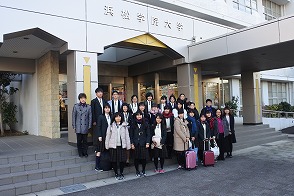 (Picture ①) Twenty-three HIS students visit HGU. 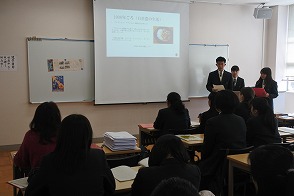 (Picture ②)HIS students give a presentation. 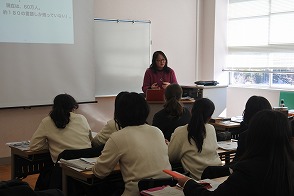 (Picture ③)Ms. Mitsuyasu gives a lecture. 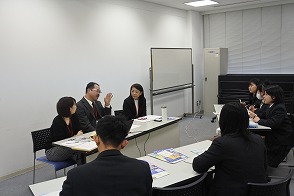 (Picture ④)A Hamamatsu Gakin University student is interviewed. 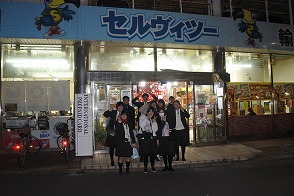 (Picture ⑤)HIS students visit a Brazilian restaurant. |
| 2019/ 2/11(Mon.) 1,2,3rd year (16,15,14th) |
SGH 6th Senior High School Students’Day for Considering International Issues (1,2,3rd year) At Kobe Fashion Mart on Rokko Island, the sixth Senior High School Students’Day for Considering International Issues was held. It was hosted by the Hyogo Prefectural Board of Education, Osaka University, and the World Health Organization (WHO) Kobe Center. There were about 500 senior high school participants from 26 schools in and outside of Hyogo Prefecture. Twenty-four students from Hyogo Prefectural International Senior High School (HIS) participated in it. Thirteen of them were in their first year, nine were in their second year, and two were third-year students. First, Vice-President, Professor KURIMOTO Eisei, made a keynote speech about the following theme; Goals and Challenges in the world---Change from MDGs (Millennium Development Goals) to SDGs (Sustainable Development Goals)where ‘no one will be left behind.’ Next, four representative senior high school students joined a panel discussion. They discussed how SDGs could be realized. During lunchtime, a seminar for teachers was held. The purposes were to share examples of their SGH activities with each other, and to improve the SGH activities of each school. Six schools’ teachers joined it, including Mr. Maekawa from Hyogo Prefectural International High School (HIS) and teachers from Hyogo Prefectural Nagata High School, Hyogo Prefectural Kaibara High School, Hyogo Prefectural Kawanishimeiho High School, Tokushima Prefectural Joto High School, and Osaka Prefectural Senri High School. Mr. Maekawa from HIS reported how the SGH rubric of HIS was used. He explained that the HIS’ SGH rubric was modified for each SGH activity and used in activities such as debate, making migrant maps, and writing theses on a proposal for Japan’s course about migrants. Some teachers from the other schools commented that making different rubrics for each SGH activity was an impressive and good idea. In the afternoon, there was a poster session. The HIS students had ten presentations. (Picture ②③) The HIS first-year students presented posters about: (1) case studies of Philippine people who have migrated to Japan and what Japanese people should think about when they accept immigrants, (2) a case report on surveys about what university students in the Philippines think about working in Japan in the future, and (3) case studies of Philippine people who have migrated to countries other than Japan and what Japanese people should think about when they accept immigrants. Five HIS second-year students presented posters about: (4) a study about Japan’s nationality system, focusing on people of multiple nationalities, (5) a study report on surveys of what high school students and university students think about immigration, (6) a study about accepting immigrant workers in Japan, focusing on whether technical interns’ families should be allowed to come and live together in Japan, (7) “Thai youths' attitude toward working in Japan-From the results of interviews of high school and college students in Thailand-”, which was presented in English and (8) a study about demands for immigrant house workers in Japan—in order to improve Japanese women’s work-life balance. Third-year students showed posters of (9) proposal for language and life assistance to immigrant children’s parents, (10) Koreans in Japan who maintain their Korean identity and their Korean language abilities – from the results of surveys about people’s ethnic identity and their language abilities. Each group’s presentation went for ten minutes followed by a five-minute question-and-answer session. This was repeated twice. The HIS students presented the results of their research, attracting an especially large audience including university and high school teachers and students as well as other adults. They presented the results of their study to the audience, and answered questions from the audience. After the poster sessions, the participants gathered at another location and listened to comments. Mr. Kakizawa from Osaka University looked back on the poster sessions and talked about what would be necessary to conduct further research. He said that research means the process of verifying hypotheses, and he talked about the importance of analysis based on logical thinking in these processes. He commented on two of the HIS presentations. (Picture ③④) The HIS students were very glad because he held them in high regard. They were surely motivated to do further research. The event was a good experience for the 1st-year and 2nd-year students because they would go on with their research, and for the 3rd-year students because they had a chance to present their final papers. |
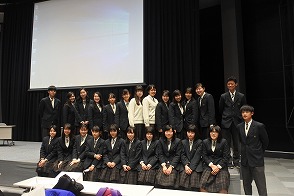 (Picture ①) Twenty-four HIS students join the meeting. 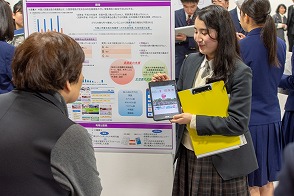 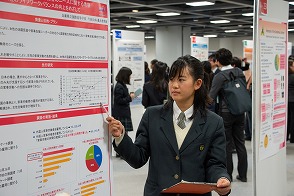 (Picture ②③)The HIS students present their posters. 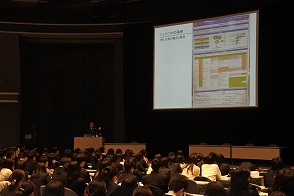  (Picture ③④)Two HIS posters are mentioned in the closing meeting. |
| 2019/ 2/9(Sat.) 1,2nd year (16,15th) |
2019 SGH Fieldwork in Ikeda~ Visit to ‘Poplar’ Special Nursing Home for
the Elderly (1st ,2nd year) Sixteen first-year and second-year students from Hyogo Prefectural International High School(HIS) went on SGH fieldwork and visited 'Poplar', a special nursing home for the elderly in Ikeda City, Osaka. (Picture ①) Their main goals were to visit a nursing home which accepts care workers from overseas, to learn about the present situation of Japan’s nursing homes and migrant workers there, and to have a chance to consider what Japan will be like with more immigrants in the future. Another purpose was to visit the same nursing home that they have visited for the past three years and learn about any changes in the employment of care workers from abroad. First, a staff member of Poplar explained some things about the facility. As of this February, the home employs 24 foreign care workers out of their 60 staff members. Seventeen of the foreign workers are care workers and care worker candidates from the Philippines. The rest of them include six international students-- four from Nepal and two from Vietnam—and one Vietnamese person who is the spouse of a Japanese national. The number of foreign workers was 19 as of last January. For the past few years, however, the situation surrounding the acceptance of migrant care workers in Japan has been changing because of new laws. As a result, the number of immigrant care workers in Japan has been greatly increasing. Before the Economic Partnership Agreement (EPA) care workers and candidates could work as care workers, but now international students can also work as care workers in Japan. At the same time, the number of countries migrant workers come from is increasing—now including the Philippines, Nepal, and other countries. The speaker explained that care workers with new types of residence status such as ‘technical intern training’ and ‘designated skills’ would be employed at Popular. He said that in the past, care worker candidates who couldn’t pass the national EPA exam by the end of a certain year had to go back home. But the speaker said that Poplar would continue to employ care worker candidates even if they failed the exams by changing the status of residence from ‘designated activities’ to ‘designated skills’. Moreover, the speaker talked about the idea of establishing a care worker training school named ‘Poplar Academy (tentative)’ near the special nursing home ‘Poplar’. In addition, they plan to set up ‘Poplar Academy Nepal Branch’ in Nepal, and train 200 Nepalese people to become care workers, who are going to be employed at ‘Poplar’ in the future. Next, the HIS students interviewed the care workers at Poplar—one person from the Philippines who had passed the test to become an EPA care worker, three care worker candidates who came to Japan from the Philippines in 2018 and a student from Vietnam who was going to a Japanese language school. (Picture ②) When the workers were asked why they came to Japan instead of going to more popular destinations such as Taiwan or Saudi Arabia, some answered that Japan was a familiar country to them and was interested in Japan because they watched Japanese anime and dramas. Others answered that Japan was a safe country. When the HIS students asked them, “What is troubling you in Japan?”, some of them answered that they found it difficult to understand Chinese characters on maps and signboards at a station when they went out. When the HIS students asked the workers whether they would like to work in Japan or go back home, all of them answered that they would like to pass the national EPA test to become the EPA care workers, and continue working in Japan. Some answered that if they fail in the national exam, they would go back home and teach Japanese. The HIS students learned a lot about the present circumstances surrounding Japan’s nursing homes and immigrant care workers. The students will take advantage of their experiences there to carry on their SGH research. |
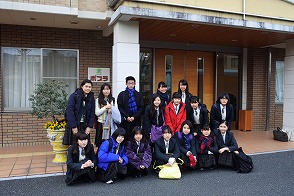 (Picture ①) Sixteen HIS students join. 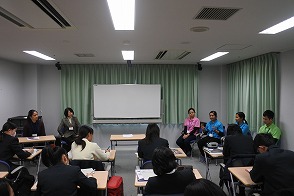 (Picture ②) HIS students interview migrant care workers. |
| 2019/ 2/2(Sat.) 1st year (16th) |
2019 SGH Fieldwork at the One World Festival (1st year) The 2018 One World Festival (OWF) was held at Ogimachi Square of Kantere (Kansai TV) and the North Ward Community Center. All 108 of the first-year students from Hyogo Prefectural International Senior High School (HIS) conducted fieldwork there. In 2015, the United Nations held the Sustainable Development Summit and adopted 17 Sustainable Development Goals (SDGs). The OWF’s purpose was to share these 17 goals, and to offer a chance and a place to meet organizations and institutions, see information and people, and work in the future. The OWF is one of the largest events of this kind in Western Japan, in which more than 100 organizations including non-governmental organizations(NGOs), nonprofit organizations(NPOs), administrative offices, businesses, schools, and other education-related institutions had booths to inform participants of their efforts to promote international cooperation and to solve social issues. The HIS students’ objective was to conduct fieldwork with a chance to consider solving social issues such as immigration policy, which is their SGH research topic, and to imagine what Japan will be like in the future. T he HIS students prepared questions to ask beforehand, asked them at related booths and took notes when they got answers. (Picture ①) Some HIS students joined workshops and discussed world issues. (Picture ②) The HIS students filled in their worksheets about what they learned. It was a very good chance for them to think about various kinds of issues which the global community is now facing. |
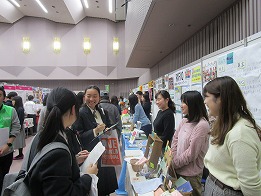 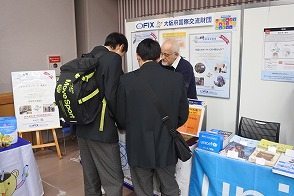 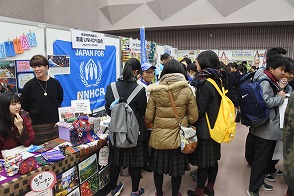 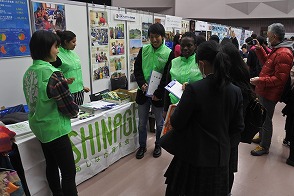 (Picture ①) HIS students visit a lot of booths. 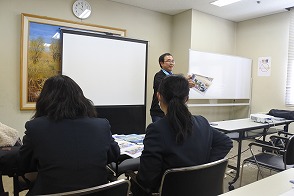 (Picture ②)Some HIS students join workshops. |
| 2019/ 1/16(Wed.) 2,3rd year (15,14th) |
SGH Lunch-Hour Street Preaching-Style Open-Air Lecture(2nd, 3rd year) During the lunch hour on January 16, nineteen second-year students gathered in a classroom and listened to a talk from a third-year student. The third-year student finished writing her research paper, and got an award at the 2018 Research Festa at Konan University last December. These 19 second-year were preparing to write their academic papers. They learned some important points in writing their thesis from the third-year students. She gave the following points of advice: (1)the theme of a paper should not be an abstract one but a concrete one, (2) you should find previous research which has the same theme as yours, (3) you should collect enough background data, (4) you should collect your own data using tools such as surveys, and (5)you should analyze the data and write your research paper. The second-year students listened to her carefully, and asked some questions after her talk. The lecture was a good opportunity for the third-year student to share some advice with the second-year students and help them write their own papers. |
 (Picture ①) The 3rd-year student talks about her thesis.  (Picture ②)The 2nd-year students listen to her advice. |
| 2019/ 1/12(Sat.) 2nd year (15th) |
SGH : Global Health Senior High School Students’ Forum at Takatsuki High
School (2nd year) A second-year student from Hyogo Prefectural International High School (HIS) participated in the Global Health Senior High School Students’ Forum at Takatsuki High School. About 130 students from Takatsuki Junior and Senior High School and about 20 students inivited from other SGH high schools joined it. First, Mr. Kayano, a professional staffer from the WHO Kobe Centre (WKC), and Professor Kihara from Kyoto University made keynote speeches about global health in English. (Picture ①) Next, workshops on different themes were conducted. The students were divided into 16 workshops and discussed each theme in a group in English. The second-year HIS student joined a workshop about long working hours and health. (Picture ②) She presented her report based on a survey about technical interns working in Japan and their long working hours. The group focused on the problem of long-hour labor by migrant workers, and discussed how to solve it in English. After the workshops, all the students gathered again. The reporters from each group gave reports in English. One of the reporters was the HIS student. (Picture ③)Some comments were made in English, and the forum was closed. The HIS student had a good chance to talk with students from other Super Global High Schools. |
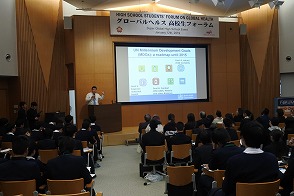 (Picture ①)A keynote speech is made. 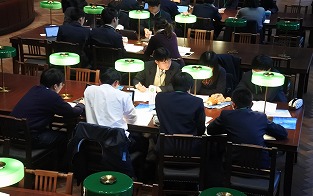 (Picture ②) The HIS student discusses long-hour labor. 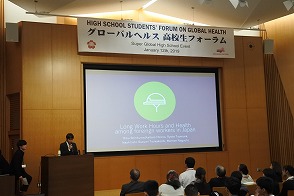 (Picture ③)The HIS student reports her group's discussion. |
| 2018/ 12/23(Sun.) 1-3rd year (16-14th) |
SGH Research Activity :2018 Konan University Research Festa (1-3rd year) The 2018 Research Festa was held at the Okamoto campus of Konan University. Eight students from Hyogo Prefectural International High School (HIS) —three first-year, two second-year, and three third-year students-- participated in it.(Picture ①) A third-year student presented her poster titled ‘consideration on accepting migrant nurses in Japan---through fieldwork about EPA nurses from the Philippines’. (Picture ②)Another third-year student presented her poster about Koreans in Japan who maintained their Korean identity and Korean language abilities. She based her study on fieldwork about Korean identity and language in Japan. The other third-year student showed her poster and talked about her consideration on mother tongue assistance education for migrant children in Hyogo Prefecture. The group consisting of two second-year students presented their poster titled ‘Thai youths’ attitude toward working in Japan—From the results of interviews of high school and college students in Thailand’. (Picture ③)The group consisting of three 1st year students presented their poster about case studies of people people from the Philippines who have migrated to Japan. (Picture ④)They talked about what Japanese people should think about when they accept immigrants. The second-year group presented in English, and the other students gave their presentations in Japanese. All of them answered questions after their presentations. A lot of other senior high school students, university undergraduates, and graduates joined the Reserch Festa and presented posters about their research projects. In the closing ceremony, two third-year students from HIS were awarded prizes. One of them, Ms. Yoshikawa, got a big data award, (Picture ⑤)and the other student Ms. Onishi got a logical design award. (Picture ⑥) 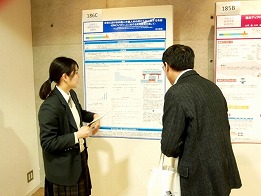 (Picture ⑤) Ms. Yoshikawa gets a big data award. 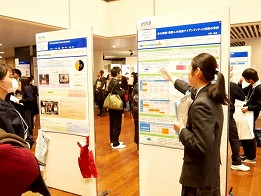 (Picture ⑥)Ms. Onishi wins a logical design award. |
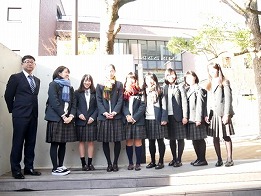 (Picture ①)Eight HIS students join the 2018 Research Festa. 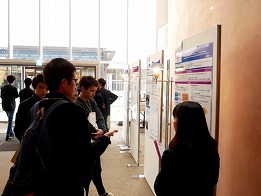 (Picture ②)A third-year presents her poster. 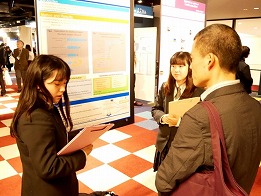 (Picture ③)A second-year pair talks about Thai young people. 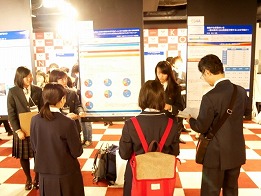 (Picture ④)A first-year group talks about migrants from the Philippines to Japan. |
| 2018/ 12/20(Thu.) 1st year (16th) |
SGH Research Activity: Presentations of "World Migration Maps"
(1st year) For the Super Global High School (SGH) research project, the first-year students made "World Migration Maps", and presented them on December 20th.(Picture ①) This year the students in Class 1 made maps of the immigrant flow from Vietnam to the U.S.A.; the students in Class 2 made maps of the immigrant flow from Cambodia to Malaysia; the students in Class 3 made maps of the immigrant flow from the Philippines to Australia; and the students who had joined the Philippine Study Tour made maps of the immigrant flow from the Philippines to the U.S.A. Each group’s poster had a graph and a map showing the flow of migrants from one country to another, things that pushed emigrants out of a country, things that pulled immigrants toward another country, and a conclusion. They presented their posters in a poster session, and evaluated each other’s presentations.(Picture ②) |
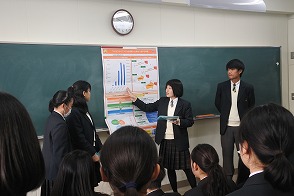 (Picture ①)Each group presents their posters. 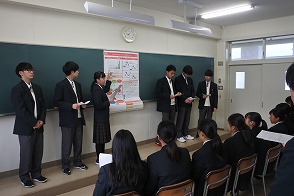 (Picture ②)They evaluate each other's presentations. |
| 2018/ 12/19(Tue.) 1-3rd year (16-14th) |
2018 SGH Midterm Presentation of Research & Overseas Study Tour Presentation
(1-3rd year) First, HIS Principal Mr. Matsumoto made an opening speech.(Picture ①) Next, the HIS students gave midterm presentations about the results of SGH research on immigration with the following themes: 1.First-year students presented: (1)a report on surveys of workers from the Philippines who have worked in Japan. (Picture ②) 2.Second-year students presented: (1)a project to discover historical things about Japanese immigrants and to make a short movie titled 'KISEKI or Trajectory', which was about an interview of a Japanese woman who has been to Brazil, (Picture ③) (2)a report on Thai youths' attitude toward working in Japan(Picture ④) (3)a report on the results of surveys in regard to working in Japan from their overseas study tours to America, Canada, and the U.K.,(Picture⑤), and (4) a study on Japan's nationality system.(Picture ⑥) 3. Third-year students presented: (1)a study on accepting nurses from other countries,(Picture ⑦) (2)a study on teaching immigrant children their home countries' languages, (Picture ⑧),and (3)a study on Korean immigrants in Japan maintaining their ethnic identity and their ability to speak the Korean language. (Picture⑨) After the midterm presentation of research was over, the socond-year students talked about the study tour to three countries---the U.S., the U.K., and Canada to help the first-year students choose one of the three countries. (Pictures ⑩~⑮) 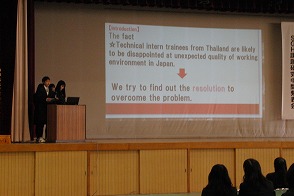 (Picture ④) A 2nd-year group reports onThai youths' attitude toward working in Japan. 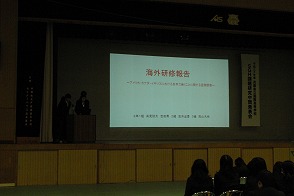 (Picture ⑤)Another 2nd-year group reports on surveys of Americans, Englishmen, and Canadians about working in Japan. 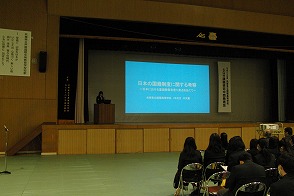 (Picture ⑥)A second-year student reports on her study about the Japan's nationality system. 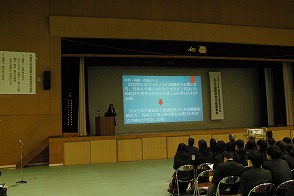 (Picture ⑦)A third-year reports on her study about accepting immigrant nurses. 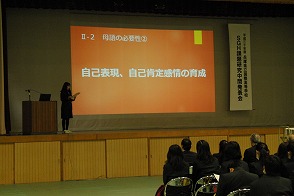 (Picture ⑧)A third-year student reports about teaching immigrant children their home countries' mother tongue. 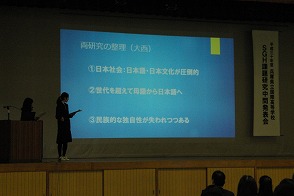 (Picture ⑨)A thrid-year student reports about the importance of maintaining Korean identity and language for Korean immigrants. |
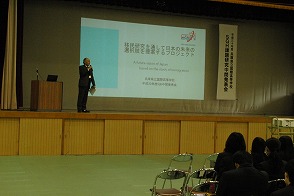 (Picture ①)Principal Matsumoto makes an opening speech. 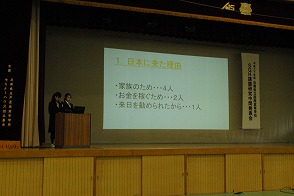 (Picture ②)First-year groups report on surveys of workers from the Philippines who came to Japan. 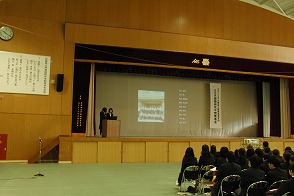 (Picture③) A second-year group shows a movie titled 'Trajectory of Japanese immigrants to Brazil'. 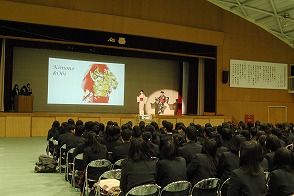 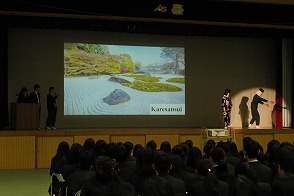 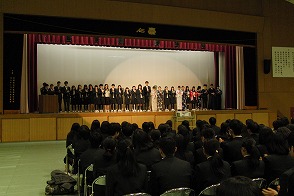 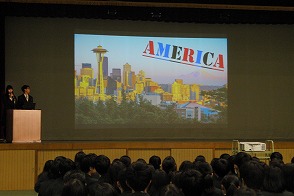 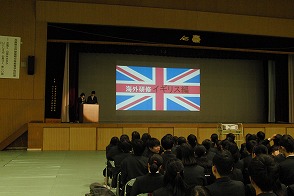 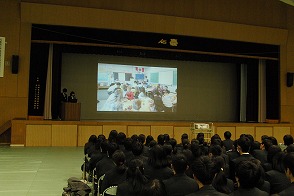 (Pictures ⑩⑪⑫⑬⑭⑮)Second-year students talk about Japan's beauty in English and then their overseas study trip to three countries in Japanese. |
| 2018/ 12/15(Sat.) 1,2 year (16,15th) |
2018 Study Tour at Winter Conference of JAMPS(1st, 2nd year) The 2018 Winter Conference of Japan Association for Migration Policy Studies (JAMPS) was held at the University of Shizuoka. Ten students--two first-year and eight second-year students-- from Hyogo Prefectural International High School(HIS) took part in it. First, they joined the “Refugee Interest group.” They listened to Jafar Atay, a refugee from Afghanistan. When he was four years old, a civil war occurred, and he moved to Pakistan as a refugee, and then he came to Japan in 2009. He applied for refugee status, but he was denied recognition as a refugee, so he has been living with special permission to stay in Japan. Unlike recognized refugees, people with special permission to stay in Japan have no economic or other support from the Japanese government. He said that he saw a lot of people dying in front of him abroad. HIS students had a good chance to think about accepting refugees to Japan. Next, free presentation sessions were held in four places, and researchers presented the results of their studies. Ten students from HIS listened to them and learned a lot about the latest immigration policy. At eleven, the society coalition session was held at another place, and three third-year students from HIS made presentations about their research. First, Ms. Nagaoka talked about her research titled, “Japan’s challenges and thoughts about accepting immigrants --- by comparing Japan and Spain.” She reported that Spain, which had been slow in accepting immigrants from other countries, developed its immigration policy in the 21st century, and it has now become one of the model nations for taking in immigrants. She especially touched upon education Spain was giving to immigrants, and she insisted that it should be important for Japan to give education to immigrants. Next, Ms. Yoshikawa presented her report titled “consideration on accepting migrant nurses in Japan through a survey conducted at a special elderly nursing home named ‘Poplar.’” She cited data which showed that Japan was suffering from a serious shortage of caregivers, and insisted that Japan should accept more nursing care workers from other countries. Concretely, she pointed out from the results of the questionnaire given at Poplar that there was no system in Japan which enabled EPA nursing care worker candidates to work continuously at nursing homes, and insisted that the system used to accept migrant caregivers should be improved. Lastly, Ms. Ito presented her report titled “problems and thoughts about Japanese aging society with fewer children and comparison between Japan’s and Australia’s acceptance of migrants.” She dealt with acceptance of highly skilled migrants in both countries. She used data and compared Australia, where highly skilled workers were accepted based on a point system and Japan. She explained from data that Japan’s system was less attractive to highly skilled migrants than Australia’s, and insisted that the Japanese system should be improved. After three HIS students gave their reports, they were asked questions by some experts from the audience, and the HIS students answered them. The HIS students presented their reports at the JAMPS conference four times in a row, and this was the first time that three HIS students presented their reports at the same time at JAMPS. They all had a very good experience, and hoped to write a better paper by using what they learned from the conference. In the afternoon, a symposium was held and HIS students participated in it. The theme was Japan’s refugee policy with regard to the global compact on refugees. The HIS students learned more about the present situation of Japan’s acceptance of refugees and its problems. After the conference, they rode a train and made reports on the train. After arriving at Osaka as a group, they went home. |
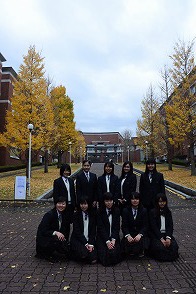 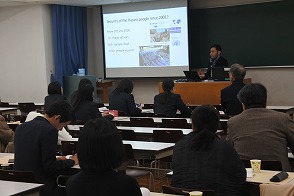 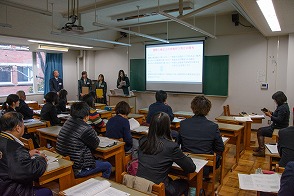 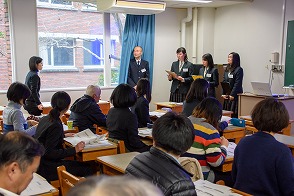 |
| 2018 11/15(Thu.) 1,2,3rd year (16th) |
SGH Special Lecture: Present Situation of Japan’s Refugee Support (1,2,3rd
year) Ms. ISHIKAWA Eri, Chair of the Board of the Japan Association for Refugees (JAR), gave an SGH special lecture to all Hyogo Prefectural International High School (HIS) students. (Picture①) She talked about the present situation of Japan’s support for refugees. Her main points were: ① from which countries refugees are coming and which countries are accepting them in the world, ② what is necessary to solve refugee issues,(Picture②) ③ how Japan has accepted refugees in history and how Japan is accepting refugees now, ④ what problems are there with Japan’s refugee policy, ⑤ what JAR is doing to help refugees coming to Japan to be independent, and ⑥ what is ‘social integration’. She then answered several questions from HIS students.(Picture ③) 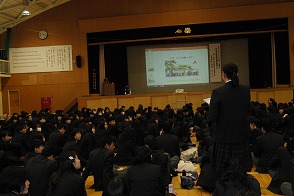 (Picture ③)Ms. Ishikawa answers questions from an HIS student. |
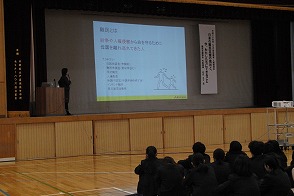 (Picture①)Ms. Ishikawa defines 'refugees'. 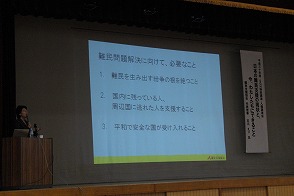 (Picture②) She explains what is necessary to solve refugee issues. |
| 2018 11/5(Mon.) 11/6(Tue.) 1st year (16th) |
2018 Philippine Study Tour (Day 4-5) (1st year) In the morning, the HIS students visited Ateneo de Manila University. After the campus tour, Dr. Benjamin A. San Jose from the Japanese Studies Program gave them a lecture on multiculturalism. (Picture①)He posed four questions to answer first: 1. How is assimilation different from multiculturalism? 2. What makes something Japanese? Some place Japanese? Someone Japanese? 3. Is Japan a homogenous society? 4. Can Japan become a multicultural society with a belief in Japanese homogeneity? During his lecture he let students form their answers to those questions. The HIS students were sure to understand the importance of establishing a multicultural society. Next, one of the four HIS groups conducted a questionnaire on about 30 students who attended Dr. San Jose’s lecture. The HIS students asked them seven questions one by one. This was followed by a question-and-answer session. Some university students asked questions about the presentation. Then the HIS students and the Ateneo students talked with each other in several groups freely. (Picture②)Next, the second HIS group presented the results of three interview surveys conducted in Japan. The group talked about interviews with factory workers, hotel workers and nurses who were working in Japan. After their presentation they were asked several questions. After lunch, two more presentations were made: one to introduce HIS, and the other to introduce Japanese culture. (Picture③)The HIS students also answered questions after these two presentations. After they visited a library, and a museum with important documents about the parts of the war in the Philippines between Japan and America, and then a store in the university. They left the university at 16:00. They dropped in at another store selling Philippine goods and a Spanish restaurant before they returned to the hotel. The next day, the HIS students left Manila in the afternoon, (Picture④)and arrived at Kansai International Airport in the evening.  (Picture④)HIS group leaves the Philippines. |
 (Picture①)HIS students get a lecture on multiculturalism.  (Picture②) HIS students talk with Ateneo University's students.  (Picture③)HIS students introduce their school. |
| 2018 11/4(Sun.) 1st year (16th) |
2018 Philippine Study Tour (Day 3) (1st year) In the morning, the HIS students went by bus to Sisig-Lakas Pre-school, which is located in the suburbs of Manila City (Phase 4, Paliparn3, Dasmarinas, Cavite) where students learn more after their normal classes end. ASI and JAFS are giving educational assistance to this place, and a researcher from ASI, Ms. Niobe was arranging to teach children there. About 20 students from elementary to high school students welcomed the Japanese students by performing dances and singing songs. After that, the HIS students interviewed five former overseas workers now living in the Philippines. The students asked them why they went overseas for working and why they came back to the Philippines.(Picture①) After eating lunch consisting of Filipino dishes, the HIS students played with children in the community. (Picture②)In the afternoon, they met with the elementary and high school students inside, and danced and sang songs to deepen their friendship. (Picture③)At 15:00 the HIS students went back to the hotel by bus.  (Picture③) HIS students make friends with young people in the village. |
 (Picture①)HIS students interview villagers.  (Picture②) HIS students play with children. |
| 2018 11/3(Sat.) 1st year (16th) |
2018 Philippine Study Tour (Day 2) (1st year) The HIS students attended a lecture at the Asian Social Institute (ASI) (Picture①)in Manila. First, Vice President Prof. Dennis Y. Batoy gave a presentation on the university, and talked about migrant workers in Myammar, Cambodia, and Vietnam, and elsewhere in the world. After that, Mr. Kaipe from Myammar, Mr. Dal Vanny from Cambodia, and Ms. Bernadette from Vietnam elaborated on migrants in their own countries. After lunch, Dr. Batoy taught the HIS students about migrants from the Philippines. Mr. Yokoyama, a staff member of the Japan Asian Association & Asian Friendship Society (JAFS), who was coordinating the study tour in the Philippines, helped the students understand the lecture by translating and elaborating on what the speakers said. In the afternoon, The HIS students visited one of the fieldwork sites Dr. Batoy was in charge of. It was a part of the town of San Andres (BRGY 807, AMISTAS ST. SAN ANDRES BUKID MLA CITY). The HIS students were divided into three groups and in total asked 15 people questions about their experiences working abroad. (Picture②)The HIS students listened to them answer 12 questions. After the interviews, they visited a dance school supported by ASI, and saw children dance there.(Picture③ At night, the students had a hot pot dinner and dropped in at the supermarket on their way back to the hotel.  (Picture③)HIS students dance together. |
 (Picture①) HIS students introduce themselves.  (Picture②) HIS students interview former immigrants. |
| 2018 11/2(Fri.) 1st year (16th) |
2018 Philippine Study Tour (Day 1) (1st year) Twenty first-year students and two teachers from Hyogo Prefectural International High School (HIS) went on a study tour to the Philippines between November 2nd and 6th, 2018. The students and teachers gathered at Kansai International Airport at 7:50, and flew to Manila, in the Philippines by air, arriving at 13:30. That afternoon, the HIS group looked around the city of Manila. First, they visited Rizal Park(Picture①), where a statue of Jose Rizal, one of the greatest heroes of the Philippines, was built. They also visited Fort Santiago(Picture②), where Jose Rizal was captured, and San Agustin Church(Picture③), which was built in the baroque style and now is one of the World Heritage sites. After arriving at a hotel at 18:00, the HIS students went to dinner at a Japanese restaurant, and visited a supermarket on their way back to the hotel.  (Picture③) |
 (Picture①)HIS students visit Rizal Park.  (Picture②) The group pays a visit to Fort Santiago. |
| 2018 10/25(Fri.) 1st year (16th) |
Immigration Discussion with Five Dutch Teachers Visiting HIS (1st year) Five teachers from Holland visited Hyogo Prefectural International High School (HIS), observed classes, and discussed immigration policy with five HIS 1st-year students in the seventh period. First, Mr. Maekawa, a senior teacher spoke about the present situation and problems with Japan’s immigration policy. Then three HIS students made short speeches about ① contributions which residents from other countries have made in Japan, ② the present situation of Japan’s acceptance of refugees, and ③ differences between Japanese people and people from other countries in regard to rules in everyday life. (Picture①)The five Austrian teachers gave their opinions related to those speeches and the current circumstances of the Netherlands’ immigration policy. (Picture②)The HIS students had a very good chance to learn about the acceptance of immigrants in the Netherlands. |
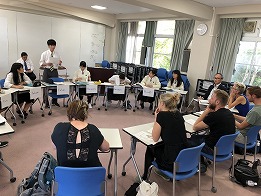 (Picture①)HIS students talk about how immigrants live in Japanese society. 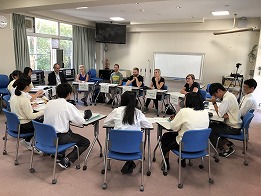 (Picture②) Teachers from the Netherlands talk about immigrants in their country. |
| 2018/ 10/1(Mon.) 1st year (16th) |
SGH Project:Debate (Final) (1st year) The affirmative team, Group A from Class 1, and the negative team, Group C from Class 2, had the highest scores during the preliminary rounds, so they competed against each other in the final round of the debate. The theme of the debate was whether Japan should accept more immigrants than now. The affirmative side argued: 1. Japan should take in more immigrants to increase the number of laborers and skilled workers. 2. More immigrants in Japan mean that Japan will develop and globalize itself more. 3. More immigrants can lead to the development of local economy. (Picture①) The negative side argued: 1. There are some problems about the current system and the environment in accepting international students in Japan. 2. An environment in which skilled workers and their family can live comfortably in Japan has not been created. 3. There are some defects in the current immigrant-receiving system, so no more immigrants can be accepted. (Picture②) Both teams showed their own evidence to support their arguments, and debated each other. (Picture③) The other first-year students and two professors from Kwansei Gakuen University judged the debate, and the affirmative side won. After the debate, two special judges, Professor TOBA Mirei from the School of Sociology at Kwansei Gakuin University and Associate Professor NAGATOMO Jun from the School of International Studies at Kwansei Gakuin University commented on the debate. (Picture④) 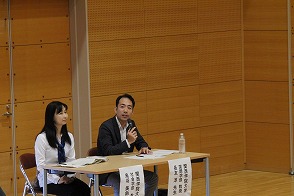 (Picture④)Two professors from Kwansei Gakuin University comment on the debate. |
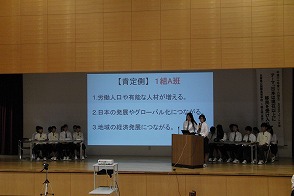 (Picture①)The affirmative side, Group A, Class 1, constructs their argument. 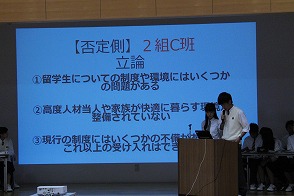 (Picture②)The negative side, Group C, Class 2, constructs their argument. 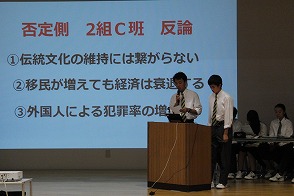 (Picture③)The negative team rebutts the affirmative team. |
| 2018 9/1(Sat.) 1st year (16th) |
2018 SGH Study Tour @ Osaka University (1st year) Two first-year students from Hyogo Prefectural International High School (HIS) took part in the first Osaka University Co-Creation Series Seminar, titled, ‘A City with Disaster Prevention--- how to make the Hokusetsu region well-prepared for disasters considering the damage done by the 2018 Osaka Earthquake.’ The seminar was held on September 1st, Disaster Prevention Day. The purposes were for Osaka University to give lectures about the damage resulting from the earthquake in June that had an intensity of lower 6 on the Japanese scale of 7, problems made apparent after the earthquake, and having discussions with Osaka citizens in order to make them more aware of disaster prevention. The reason why the HIS students joined it was to think about problems foreign residents in Japan will have when disasters happen, and to promote their SGH research on immigration. In the first part, there were three lectures. (Picture①)The first one was given by Associate Professor HIRONO Tetsuro, from the Graduate School of Science at Osaka University. He talked about the mechanisms causing the 2018 Osaka Earthquake. The second lecture was given by Professor YOKOTA Takashi from the Graduate School of Engineering. He talked about problems of regional disaster prevention against natural disasters. Specially Appointed Associate Professor GOTO Takehiro from the Center for International Education and Exchange gave the third lecture about how Osaka University students and citizens evacuated after 2018 Osaka Earthquake. He talked about how international students evacuated. According to his report, there were more than 130 foreign people out of the 140 evacuees in one evacuation spot. He pointed out that under those circumstances there was scarcely any information about the damage caused by the earthquake. He insisted that they should be offered information about an earthquake and its damage in various languages. He said that giving foreign residents free wi-fi access and QR cords after a disaster would be very useful. He also emphasized that people should take religion and food culture into consideration when they deliver emergency provisions to victims, such as halal foods to Muslims. In conclusion, he insisted that people should consider and take measures against leaving weak victims vulnerable such as children, elderly people, disabled people, and people from other countries. In the second part, the lecturers had a panel discussion, and a question-and-answer session with participants and the HIS students. The HIS students feel it is necessary to take measures so that foreign residents in Japan can live without any fear after a disaster. The HIS students learned a lot from the seminar, and they are hopefully going to do better research. |
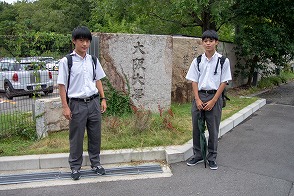 (Picture①)Two HIS 1st-year students join a study tour at Osaka University. 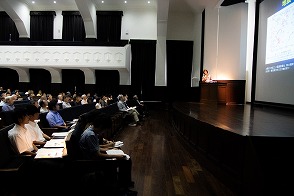 (Picture②) Participants listen to Osaka University lectures about the 2018 Osaka Earthquake. |
| 2018 8/31(Fri.) 1,2 year (16th, 15th) |
2018 SGH Fieldwork in Himeji (1st & 2nd year) Eight 1st-year students and one 2nd-year student from Hyogo Prefectural International High School (HIS) participated in the 2018 SGH Fieldwork in Himeji. This fieldwork had been originally scheduled to be held on the 24th of August with 17 students, but because a typhoon warning was issued on that day, it had been postponed. The purposes of the 4th Fieldwork in Himeji were to visit companies in Himeji City which employ people from the Philippines, to examine the current situation of workers from the Philippines, and to consider what kind of research questions HIS students ask have in the coming Study Tour to the Philippines and the following activities. First, the HIS students visited Glory Ltd. They listened to a company presentation of the company. According to it, the company has 22 factories overseas, and there are about three thousand overseas workers out of 9,000 employees. Around twenty different nationalities are represented. Next, the students went around the facility. They visited the second manufacturing department, and they found three out of 11 employees to be workers from other countries. They all had a residence status of technical intern trainees. After that, the HIS students interviewed two female workers from the Philippines working at Glory. Their residence status was intra-company transfer. They were sent from a factory in the Philippines to Japan, and here they assemble things in a factory. They answered questions from the HIS students. They were asked why they came to Japan, and they answered that it was because they would like to improve their skills and lives. When they were asked what kind of troubles they had while living in Japan, both answered that they have had difficulty in learning the Japanese language. The company has made time on weekends when a Japanese person in charge teaches Japanese to foreign workers. One of the interviewees, however, answered that in addition to that she learned Japanese by paying tuition and attending lessons outside the company. The HIS students thought more about how to help workers from other countries learn Japanese. At noon, they went to Himeji Castle Hotel by bus. After lunch, a person from Route Inn Hotels made a presentation about the hotel. He said that the group was running 294 hotels. He talked about a plan to set up a Japanese language school in Vietnam so that Vietnamese workers could learn the Japanese language and later they could choose to work for hotels in Vietnam or in Japan. In Himeji Castle Hotel there are nine hotel employees from other countries among 152 workers in total. There are four from Korea, three from the Philippines, and two from Vietnam out of nine. Eight are junior employees with permanent long-term temporary resident status. One was a Korean who is using a working holiday system for their visa. Next, the HIS students interviewed three female employees from the Philippines working at Himeji Castle Hotel. They were house keepers. According to the results of the interview, they entered Japan with the residence status of entertainers, and now are working with the residence status of permanent or long-term temporary residents. The reason why they came to Japan was that when they were in the Philippines their neighbors recommended going to Japan. They said that that was during a robust Japanese economy, and that they would not recommend going to Japan if they were in the Philippines now. Three answered that they were remitting money back to their country. When they were asked, “What are good points of working in Japan? “, they answered that Japanese people were treating them kindly. When asked the question, “What kind of troubles do you have in Japan?”, they answered that they all could speak Japanese but they couldn’t read or write Japanese. Their children could learn reading and writing Japanese at Japanese schools, but they had no chance to learn it. They gave the HIS students detailed answers, so the HIS students had a very good chance to deeply understand how these workers were living and thinking in Japan. After these activities, they went back to HIS by bus. |
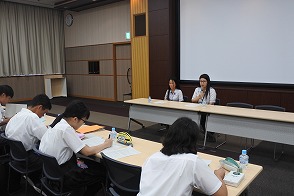 (Picture①)HIS students interview two female workers from the Philippines at Glory Ltd. 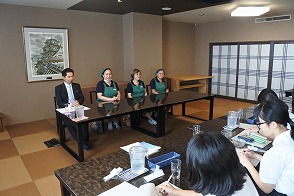 (Picture②)HIS students interview three female workers from the Philippines at Himeji Castle Hotel. |
| 2018 8/27(Mon.) 2 year (15th) |
2018 SGH Study Tour @ Kwansei Gakuin University (2nd year) Six HIS second-year students went on a 2018 study tour at Kwansei Gakuin University. The purpose was to present posters showing results from their SGH research to Prof. NAGATOMO Jun, the head of the Department of International Relations, and deepen their understanding of SGH research through a question-and-answer session with the professor. They also aimed to improve their presentation contents so that they could better present their posters at 2018 National Super Global High School Forum and SGH Koshien (named after Koshien Ballpark in Nishinomiya). The first group consisting of three students presented their poster about research into Thai technical trainees, and after they answered questions asked by Professor Nagatomo, they had discussions with him. Professor Nagatomo advised them that after making research goals clearer, they should revise their research questions and improve the whole structure of their presentation. Next, the HIS group of three presented their poster about research on migrant workers from other countries. They had a question-and-answer session and a discussion with Professor Nagatomo. He told them that it would be better for students not to generalize too much when they obtain research results. For example, if you find that fewer people said yes to a question which asks, ‘Do you agree to accept migrants as house workers?’, you should not conclude that the needs for house workers in Japan are scarce by just looking at this result. Instead, he advised that the HIS students should look at the results more carefully to see what kind of people are trying to accept extra house workers. He said that after that the HIS students can make the problems about accepting foreign housekeepers much clearer. The study tour will help them research and present their immigration research at other events such as National Senior High School Forum and SGH Koshien. |
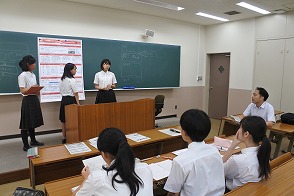 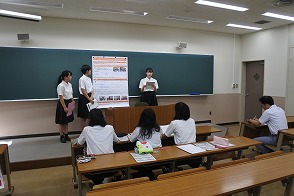 (Pictures)2nd-year students present their posters to Professor Nagatomo. |
| 2018 7/18(Wed.) 1,2,3 year (16th, 15th, 14th) |
SGH Special Lecture: Considering Migration Issues in Japan—what we should
keep in mind in order to accept people from other countires (1st-3rd year) Professor Emeritus KOMAI Hiroshi from Tsukuba University gave an SGH special lecture titled ‘Considering Migration Issues in Japan—what we should keep in mind in order to accept people from other countries’ to all the Hyogo Prefectural International High School (HIS) students. His main points included: ① comments on the third-year students’ SGH research papers ② the premise we make when we discuss immigration ‘issues’ ③ the basic structure of migration problems in Japan ④ the basic principle of cosmopolitanism. He answered several questions during the question and answer session that followed his lecture. 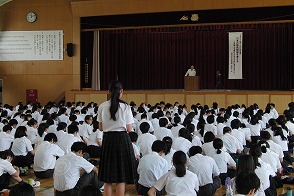 (Picture②)A third-year student asks Mr. Komai a question. |
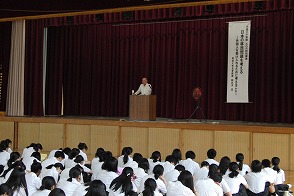 (Picture①)Prof. Emeritus Komai gives a special lecture. |
| 2018 7/17(Tue.) 1 year (16th) |
SGH Study Tour at 3 universities (1st year) 120 Hyogo Prefectural International High School (HIS) first-year students went on a study tour to three universities. (1) Study Tour at Kwansei Gakuin University Forty students from Hyogo Prefectural International Senior High School (HIS) joined a study tour at Kwansei Gakuin University. They travelled from HIS by bus to the university’s Uegahara campus. First, they attended a lecture by Mr. NAGATOMO Jun, a professor of the International Department of Kwansei Gakuin University. The title of the lecture was ‘The Meaning of Migration Study—What you will find when you make migration maps’. Professor Nagatomo began his lecture by explaining why migration study was important. Next, he talked about how the word ‘migrant’ was defined. He explained two definitions---one with a broader meaning and the other with a narrower meaning, and he emphasized that the definitions of the terms were important in research. Next, he talked about what kind of study sociology is. He explained sociology from two perspectives—analysis units and research methods. He suggested that analysis units depend on what kind of study it is---the units of cultural anthropology are micro, while those of economics and politics are macro. He noted that the units of sociology are situated between micro and macro. Next, he maintained that research methods of anthropology are based on quality, while economics and politics research methods are based on quantity, and that research methods of sociology are situated between quality and quantity bases. He told the students that asking research questions was important in their research activities. Next, he talked about diversified immigrants. First, he explained acceptance of ‘international students’ as highly skilled human resources. Then he explained the family unity in America. He also referred to immigrant workers in Australia. Finally he mentioned the acceptance of refugees in Germany. After this, he emphasized the importance of making ‘immigration maps’. He said that by tracking immigration on maps people can see the flow of people and realize a variety of things. In the end, he explained the importance of immigration study. He said that it was important for the students to drop prejudices such as the presumption that the more immigrants there are in a country, the more crimes will be committed there. Then, he said that they should not generalize things too extremely when they use logic in their research. He went on to say that when the HIS students try to think about a policy recommendation, it will be important for them to disclose the results from the analysis instead of making a policy recommendation as individuals. Lastly, he said that it would be very dangerous to use methods that simply compare things among countries, because the backgrounds of any two countries are so different that the immigration policies of the two countries cannot be simply compared. He said that it would be better to use case study methods when they research on immigration. Prof. Nagatomo discussed several topics with HIS students while giving his lecture. They must have learned a lot from this university professor’s lecture. After that, Mr. Nohara from the Center for Secondary and Higher Education Linkage at Kwansei Gakuin University gave a presentation about university. Later they had lunch at the university cafeteria, looked around the campus, and went back to HIS by bus. (2)Study Tour at Ritsumeikan University Forty 1st-year students from HIS participated in a study tour at Ritsumeikan University. They traveled from HIS by bus to the university’s Kinugasa campus. First, they attended a lecture by Mr. MINAMIKAWA Fuminori, a professor from the College of International Relations at Ritsumeikan University. The title of his lecture was ‘America and Its Migrants During the Trump Era Studied From the Perspective of International Relations’. First, he cited some words by Benjamin Franklin and J.F. Kennedy, and said that the United States was a nation of immigrants. Next, he explained there were two ideas about acquisition of citizenship---the one called ‘jus soli’, which means when a person is born in a country, he is automatically given the citizenship of that country, and the other called ‘jus sanguinis’, which means a new-born baby is given the citizenship of their father’s or mother’s country. He mentioned that the United States adopted the policy of ‘jus soli’, while Japan the policy of ‘jus sanguinis’. Next, he cited the former U.S. President Obama’s inauguration speeches, and explained multiculturalism in America. Then he showed data from immigrants between 1820 and 2009, and pointed out that the number of Hispanic and Asian immigrants was increasing. He said that some entrepreneurs who were influential in American economy had been immigrants, and emphasized that these people were contributing to American society. Next, Prof. Minamisato touched upon a speech President Trump made when he announced his candidacy for the presidential election, and he pointed out that President Trump had had a biased view against immigrants from the start. He also presented data which showed that 50 % of the people supporting President Trump thought that immigrants would commit serious crimes. Keeping it in mind, President Trump, when he was sworn in, executed a policy in which immigrants from Middle Eastern countries would not be allowed to enter America. Furthermore, Prof. Minamikawa said that 26 % of the immigrants in America who were born outside the U.S. were illegal immigrants, while 74 % of them were legal immigrants. At present, President Trump has adopted a policy of separating illegal immigrants from legal ones. He said that while 38 % of the American people highly evaluated President Trump’s immigration policy, American people who didn’t consider the policy to be good accounted for 59%, which was the majority of Americans. Moreover, he showed data indicating that there are a quarter of Americans who think that immigrants have a bad influence on the U.S., while 75% of them think that immigrants are serving the country well. Lastly, Prof. Minamikawa talked about challenges to solve immigrant and refugee issues. For example, he talked about preventing wars, which would produce refugees, realizing a society made from social integration and coexistence, poverty issues in developing countries, and making international rules to support immigrants and refugees. Prof. Minamikawa cited a lot of examples from the U.S. today, and the HIS students were very interested in his lecture. After the lecture, they listened to a presentation about the university, and went around on a campus tour organized by Ritsumeikan University students. After having lunch at the university, they went back by bus to HIS. (3) Study Tour at Kobe City University of Foreign Studies(KCUFS) Forty first-year students from Hyogo Prefectural International High School (HIS) participated in a study tour at Kobe City University of Foreign Studies (KCUFS). They went by bus to the university. After they listened to a presentation about the university, they attended a lecture by Ms. SHINODA Miki, a professor at the Department of International Relations. The title of her lecture was ‘Immigrants and Nations’. First, she defined migrants and refugees. Then she explained what happened to Japanese Americans who were interned during World War II. When the war with America began with the Pearl Harbor attack, the War Relocation Authority interned more than 110,000 Americans of Japanese ancestry living in America into internment camps. Those internment camps were located far from cities, and the people were sent from where they lived to rural areas. She explained how they were treated in these camps. Now the camps have all been removed, and only memorial towers have been built in their place, so Prof. Shinoda said that people were starting to forget what happened in the internment camps. The HIS students had a chance to think about the history of Japanese Americans living in America during the war. After the lecture, they had lunch at the university, and went on a campus tour. Then, the HIS students met with the HIS graduates who were now studying at KCUFS. There were four graduates from HIS and some conducted SGH research when they were at HIS. They advised the first-year HIS students about SGH research and gave them some encouraging words. After the meeting, the HIS students went back to school by bus. |
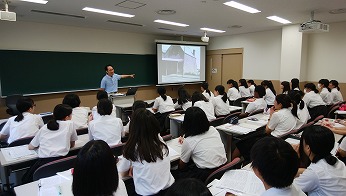 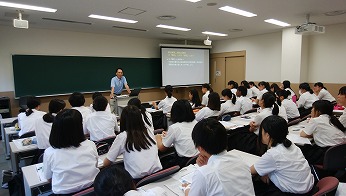 (Pictures)Study tour at Kwansei Gakuin University 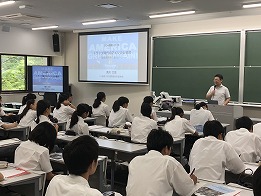 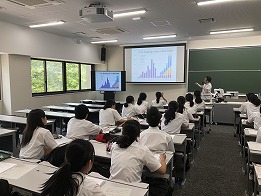 (Pictures) Study tour at Ritsumeikan University 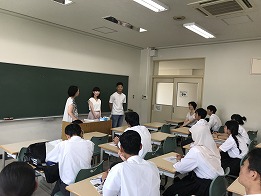 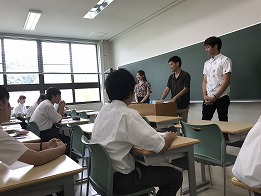 (Pictures)Study Tour at KCUFS |
| 2018 7/9(Mon.) 3 year (14th) |
SGH Presentation @ Nishinomiya Municipal Nishinomiyahama Junior High School (3rd year) Seven third-year students representing the SGH project team from Hyogo Prefectural International High School (HIS) presented HIS Super Global High School (SGH) activities to eighty third-year students at Nishimomiya Municipal Nishinomiyahama Junior High School. All parts of the presentations except for the question and answer session were carried out in English because they were part of English classes for the junior high school students. First, the HIS students introduced their school, and performed an English play. In the play, an HIS student wins some prizes through lotteries and goes on a trip to China, Korea, and Brazil. During the trip, the HIS students asked some questions, and the junior high school students answered them. One of the questions asked when the main character eats steamed gyoza, a Chinese-style dumpling was ‘Why is a steamed gyoza eaten in China, while fried gyoza is eaten in Japan?’ They then talked about the similarities and differences in food culture between Japan and China. Next, the HIS students danced as if they were the idol group, ‘TWICE’. They asked the junior high school students to identify who was Japanese among the members of the idol group during their Power Point presentation. The HIS students said that Korea is a country which has accepted a lot of immigrants. In the idol group, for example, there is a Taiwanese member as well as a Japanese member. Lastly, the main character joins Rio de Janeiro’s Carnival, and all the HIS and junior high school students danced the samba. The last question was why some Asian dance teams dance the samba, a traditional Brazilian dance, in Rio’s Carnival. The HIS students explained that those Asian people were born in Brazil and were Brazilians of Japanese ancestry and were recognized to be part of the Brazilian society. At the end of the play, the HIS students said that the reason why the main character went to these three countries was that they were among the top five countries where people came to live in Japan. They emphasized the importance of understanding Japanese people live with a lot of people from other countries. In the play the HIS students wore Chinese and Korean traditional clothes, and they also used the musical instruments which some junior high school students played in the scene of the samba. Those clothes and musical instruments were loaned from the Multicultural Children’s Center located on the premises of the HIS. The script of the drama had been written by the SGH third-year project team members since February. The drama with the quizzes and dances surely caught the junior high school students’ attention. After the break, the HIS students introduced their SGH research and activities, and talked in English about the results of the survey they did in Vietnam, and the current project of discovering new things in the history of Japanese immigration to Brazil. The question and answer session was after the presentations. The HIS students presented their SGH research for the first time to junior high school students, and they had a good experience thanks to the junior high school students’ eager participation. |
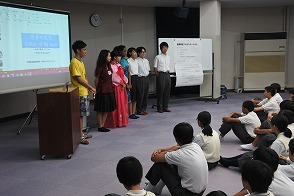 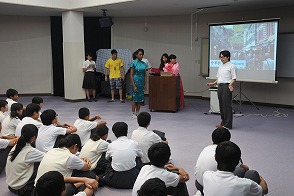 (Picture)HIS students perform a world-tour play. |
| 2018 6/13(Wed.) 1,2 year (16th, 15th) |
SGH Lunch-break Advice on Debate named ”Street Preaching ” (1st & 2nd year) During the lunch break, five second-year students demonstrated how to debate well to twenty-four first-year students in the computer room. The first-year students were leaders and sub-leaders of debate groups for SGH activities, and the five second-year students were leaders and sub-leaders of the affirmative and the negative groups in the finals of the debate contest last year. This activity was named a ‘Street Preaching’ , because its teaching style is like tsuji-seppo in Japanese or a street preaching given by Buddhist monks to people on the ‘street’ (tsuji in Japanese) in the 13th century Kamakura period. The second-year students gave some important advice about debate to the first-year students to improve their debate skills this year. First, the second-year students showed their affirmative and negative constructive speeches, and they gave the first-years some advice. (Picture)They advised them on the importance of collecting a lot of evidence for their arguments, and that it is necessary to practice debate by playing the part of the opposite side as well. The first-year students learned a lot from their seniors about debate. |
 (Picture)Second-year students make a constructive speech. |
| 2018 6/1(Fri.) 1,2,3 year (16th, 15th, 14th) |
SGH Immigration Discussion with German Students from Humboldt School (1st, 2nd, &3rd year) Eleven German students from Humboldt School, who have been visiting Hyogo Prefectural International High School (HIS), and seven Japanese HIS students (two first-year, four second-year, and one third-year students ) had discussions on immigration issues in English. First, Mr. Maekawa, who is in charge of Super Global High School (SGH) activities for this school, made a speech about Japanese immigration policy. Then, three HIS students reported on 1) contributions to society by immigrants in Japan 2) accepting refugees to Japan, and 3) problems in language education caused by accepting immigrants, and German students commented on them. 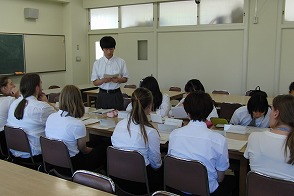 |
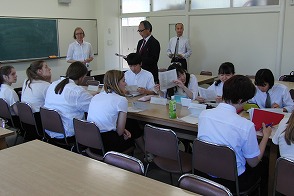 |
| 2018 5/27(Sun.) 2,3 year (15th, 14th) |
SGH Study Tour @ 2018 JAMPS Annual Conference (Day 2) (2,3 year) On the morning of the second day of the 2018 annual conference of JAMPS, researchers reported their research in free presentations in four different rooms, and ten HIS students separated to attend each. (Picture ①)They had a good chance to learn about new immigration policies. At eleven o’clock at a different site, three HIS third-year students presented their research in social coalition sessions.(Picture ②) First, Ms. Nagaoka presented her research titled ‘Challenges and considerations of Japan in accepting immigrants ---Comparing Japan and Spain.’ She talked about how Spain was lagging behind in accepting immigrants from abroad, but it organized its immigration policy in the 21st century. Now it has become a model country which accepts a lot of foreign immigrants. She talked about education given to immigrants in Spain, and she insisted on the importance of giving education to immigrants in Japan. Next, Ms. Yoshikawa presented a report titled ‘Considerations for accepting foreign caregivers—from the results of a survey conducted in the special elderly nursing home ‘Poplar’ in Ikeda City.’ She showed data about a serious shortage of caregivers in Japan and argued for accepting caregiving workers from abroad. Lastly, Ms. Ito presented her research titled, ‘Problems and considerations of an aging society with fewer children---A comparison of Japan and Australia in regards to accepting foreigners’. She mainly talked about accepting highly skilled foreign workers by showing data and comparing Australian skilled immigrants’ acceptance through its point system and acceptance of Japanese highly skilled professionals in Japan. There was a question-and-answer session after the three presentations. A lot of professionals asked questions, and the HIS students answered them. Although the HIS students attended the past JAMPS conference four times in a row, this was the first time that as many as three HIS students gave presentations at the same time. It was a very good experience for them, and they surely learned a lot form it to continue their research and improve it. In the afternoon, a symposium about Japan’s immigration policy viewed from the perspective of the Global Compact of Refugees (GCR) was held, and the HIS students attended it. They learned about the present circumstance of Japan’s acceptance of refugees and its problems. Later, the HIS students wrote a report and concluded the trip in Osaka. |
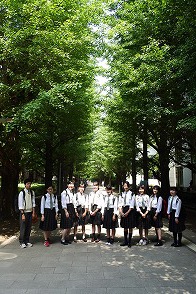 (Picture ①)The HIS students join the 2018 JAMPS annual conference on the second day. 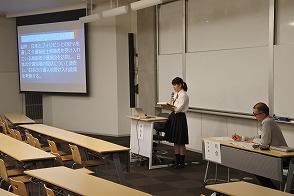 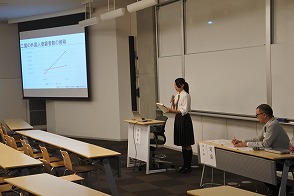 (Picture ②)Three HIS 3rd-year students present their research. |
| 2018 5/26(Sat.) 2,3 year (15th, 14th) |
SGH Study Tour @ 2018 JAMPS Annual Conference (Day 1) (2,3 year) The 2018 Annual Conference of Japan Association for Mirgration Policy Studies (JAMPS) was held at the Komaba campus of the University of Tokyo. Ten students—-five in the third year and five in the second year--from Hyogo Prefectural International Senior High School (HIS) participated in the conference. (Picture ①) First, Mr. WATADO Ichiro, a former chairman of JAMPS, gave a special lecture titled “Reconsideration –between multi-culturalism and inter-culturalism—“. He talked about discussions concerning immigration policy Japan has enacted so far. He talked about an opinion indicating that Japan’s immigration policy has not changed its framework and has stalled since the 1990s. He then talked about another opinion which argued that Japan’s immigration policy has been structurally fragmented, and a so-called “immigration policy without consensus” has been implemented. Next, he talked about the current trend of immigration policies. He cited examples of Akitakata City in Hiroshima Prefecture, and Mimasaka City in Okayama Prefecture. He mentioned an increasing number of cases in which small- and medium-sized cities in rural areas with the falling populations have tried attracting and settling foreign people down in their communities. Next he talked about the transition from local internationalization to multi-culturalism. He explained how European countries accepted migrants in the 1970s, and mentioned examples of multicultural policies such as integration policy and naturalization. He explained, on the other hand, Hamamatsu City in Japan has formulated an integration policy named the “Hamamatsu Intercultural City Vision”. He said that there were some problems about native language education and the right to vote in local elections. The HIS students had a good chance to learn how Japan’s immigration policies have been changing. Next, there was a small symposium. (Picture ②)The theme of the symposium was whether Japan should allow multiple nationalities and how Japan should be when we consider gaps between the Japan’s Nationality Law and the actual situation in Japan. Four panelists presented their reports. A panelist talked about how Korea had allowed multiple nationalities, and others discussed a lawsuit for nationality certification. The HIS students were very interested in the lecture, and had a good opportunity to learn about problems and challenges caused by Japan’s Nationality Law. They returned to a hotel after the conference and wrote a report on the day’s activities. |
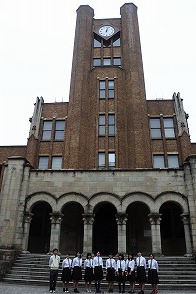 (Picture ①)Ten HIS students join the 2018 JAMPS annual conference. 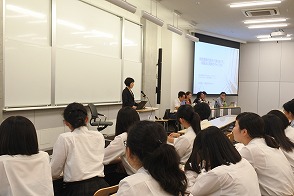 (Picture ②)HIS students attend a symposium on multiple citizenship. |
| 2018/ 5/23(Wed.) 1,2 year (16th, 15th) |
SGH Report on Study Tour in Thailand (1st & 2nd year) Twenty students from Hyogo Prefectural International High School (HIS) who had participated in the study tour in Thailand in November in 2017 reported on it to 1st-year and 2nd-year students. They presented an introduction of Japanese culture and their school, and the results of their research at schools they visited. In the end of the report, the Phillipines was announced as the destination of the next study tour abroad. 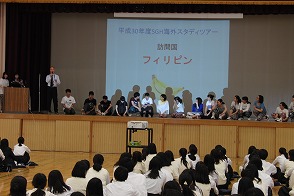 |
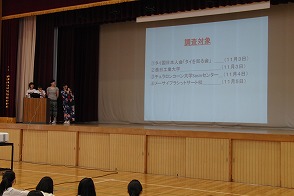 |
| 2018/ 4/23(Mon.) 1st year (16th) |
SGH Keynote Lecture: The Importance of Migration Studies—In Preparation
for Debate (1st year) The SGH keynote lecture was given to Hyogo Prefectural International High School (HIS) students by Professor NAGATOMO Jun from the School of International Studies(SIS) at Kwansei Gakuin University. He lectured on the importance of migration studies, and how they should debate. All the first-year students listened to his lecture. This year they are going to debate about whether Japan should accept more immigrants in the future than now. After the lecture, Prof. Nagatomo answered questions from students about things related to migration studies and debate. 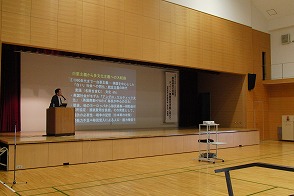 |
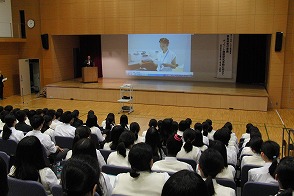 |
| 2018/ 3/24(Sat.) 1st year (15th) |
2018 SGH Koshien (the National SGH Reseach Presentation) (1st year) The 2018 SGH Koshien, the National Super Global High School Research Presentation, was held on the Uegahara campus of Kwansei Gakuin Universtiy. Nine first-year students from Hyogo Prefectural International High School (HIS) participated in it. After an opening ceremony was held in the Central Auditorium, a round-table discussion was held in the G wing. HIS 1st-year student Ms. Nagano, who had passed the first screening, joined the discussion. The theme was what problems would come up when Japanese people accept foreign immigrants as workers and how they can be solved. Six students from various parts of Japan discussed how to solve the problems. Ms. Nagano from HIS became a moderator and helped the participants to have a lively discussion. In the G wing, poster presentations were made, and eight first-year students from HIS took part in them. They presented research on the History of Japanese Immigrants. The title was “A Project to Discover the history of Japanese Immigrants Overseas”. The five-minute presentation of this research was repeated four times. After each presentation, there was a question and answer session. Next, senior high school students from various parts of Japan had a meeting and talked with each other. Lastly, an awarding ceremony and a closing ceremony were held in the Central Auditorium. The HIS students showed the results of their research, and learned a lot from research conducted by other schools all over Japan. It was a fruitful day for the HIS students. 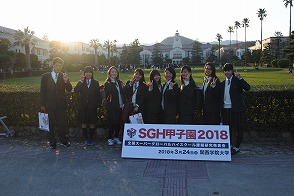 |
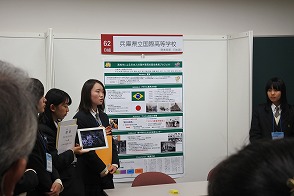 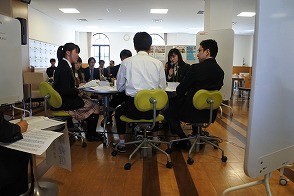 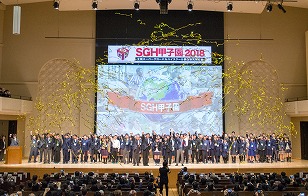 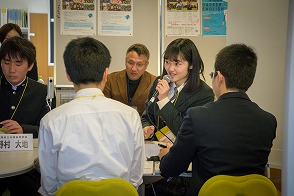 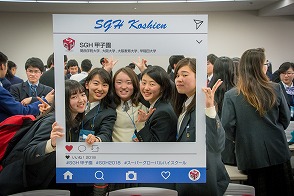 |
| 2018/ 2/19(Mon.) 1st year (15th) |
2018 SGH Study Tour in Tokyo (Day 2) (1st year) The HIS students visited the Komaba Campus of the University of Tokyo. The students presented their immigration research (Picture①) to Ms. Ksenia Golovina, a specially appointed lecturer at the Center for Global Communication and Strategies (CGCS) of the College of Arts and Sciences. She studies immigration, and advised the HIS students about their research. Next, Ms. Golovina gave a lecture about the history of Russian immigration into Japan. There was a question-and-answer session after the lecture. (Picture②③) HIS students asked her specific questions like, “Why did a lot of Russian women immigrate to Japan?” She answered all of their questions one by one. Next, Professor Tom Gally, director of the CGCS, talked about the importance of mastering English and the significance of learning including research. (Picture④) Later, there was a question-and-answer session. It was a good experience for the HIS students to learn a little about the latest immigration research. Then the HIS students left the Komaba Campus (Picture⑤)for the Universiy Museum on the University Tokyo’s Hongo Campus to look around. Finally, they went back to Osaka by bullet train. 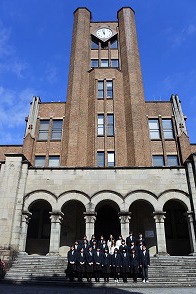 (Picture⑤) |
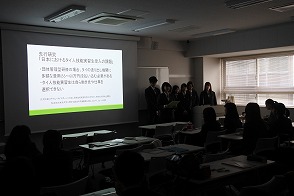 (Picture①) HIS students present their research. 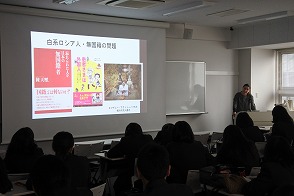 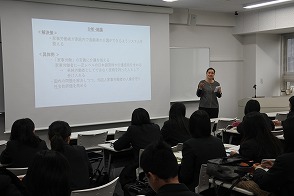 (Picture②③) Ms. Golovina talks about immigration. 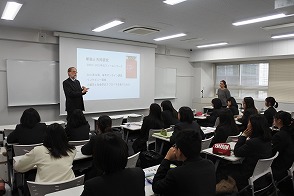 (Picture④) Prof. Gally talks about English learning. |
| 2018/ 2/18(Sun.) 1st year (15th) |
2018 SGH Study Tour in Tokyo (Day 1) (1st year) Twenty-four students from Hyogo Prefectural International Senior High School (HIS) participated in the 2018 Super Global High School (SGH) Study Tour in Tokyo. On the first day, they visited the Japanese Overseas Migration Museum at Japan International Cooperation Agency (JICA)’s Yokohama International Centre. The purpose of the study tour was to consider present immigration problems by learning the history of Japanese immigration. At the museum, there were important historical materials about Japanese overseas migration in the past, and the HIS students looked through them to deepen their knowledge about Japanese migration. (Picture) The first lecture about the history of Japanese people who went overseas was given by Mr. KOJIMA Shigeru, a curator in charge at Overseas Migration Museum. He first talked about when Japanese people began emigrating. Next, he defined persons of Japanese ancestry. Then, he talked about recent immigration of Japanese descendants into Japan. In conclusion, he mentioned that only after Japanese people who had gone overseas overcame various kinds of difficulties and discrimination did they establish their present positions. At present, a lot of foreign people from different countries are coming to Japan, and they are facing trouble and discrimination similar to ones experienced by those Japanese people. Mr. Kojima insisted that these problems in Japan would be solved by learning how Japanese people abroad overcame the same difficulties. After the lecture, the staff members showed the HIS students around the museum and explained the historical materials in detail. It was a very good chance for them to think about how to live together with local people. Finally, the staff showed some very rare historical materials in the museum collection, and the students took notes and pictures and learned a lot. Surely, they had a very good experience from listening to important talks and looking through historically significant materials. |
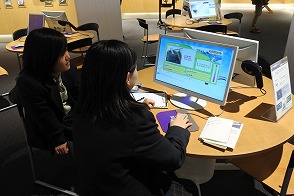 (Picture) HIS students learn about immigration. |
| 2018/ 2/3(Sat.) 1,2,3rd year (15,14,13th) |
SGH 5th Senior High School Students’ Day for Considering International
Issues(1,2,3rd year) At Kobe Fashion Mart on Rokko Island, the fifth Senior High School Students’ Day for Considering International Issues was held. It was hosted by the Hyogo Prefectural Board of Education, Osaka University, and the World Health Organization(WHO) Kobe Center. There were 29 participants from Hyogo Prefectural International Senior High School (HIS). Nineteen of them were in the first year, eight were in the second year, and two were third-year students. First, a Senior Advisor of the WHO, Mr. NOZAKI Shinjiro made a keynote speech about the world and Japan in 2015 and how to realize a happy society in Japan which people around the world would envy. Next, four representative senior high school students joined a panel discussion. They discussed the world and Japan in 2050. In the afternoon, there was a poster session. The HIS students had nine presentations. The HIS first-year students presented posters about:(1) a historical discovery project about Japanese emigrants, (2) a study which was using attitude surveys about what Japanese and Thai high school students think about studying or working overseas in the future, (3) a study on the actual condition of Thai house keepers and the acceptance of house keepers in Japan, and (4) a study using attitude surveys of what Thai high school and university students think about working overseas. Some HIS second-year students presented posters about:(5) a report on surveys about immigration that HIS students conducted during their study tours in the U.S., Canada, and the U.K., (6) a study about Japanese immigration policy using the results of surveys HIS students conducted during their study tour in Vietnam, and (7) a study about the Technical Intern Training Program (TITP) in Japan based on results of surveys of Vietnamese workers, who have been accepted into Japan through a project titled STEP HARIMA in HANOI. The third-year students presented posters about:(8) Japan’s immigration policy on supporting immigrants who want to live in Japan for the rest of their lives, and (9) a relationship between a graying society with fewer children and immigration issues in both Japan and Italy. The group of students showing a poster of (3) made their presentation in English. Each group’s presentation went for ten minutes followed by a five-minute question-and-answer session. The third-year students attracted an especially big audience including university and high school teachers as well as students. They presented the results of their three-year research on paper, and answered questions from the audience. There were several active question and answer sessions Later, comments were made and the day’s events were brought to a close. The first-year and second-year students had a good chance to advance their research , and the third-year students had a good opportunity to present the results of their research. It was a fruitful day for everyone. |
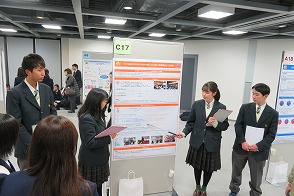 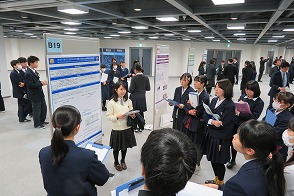 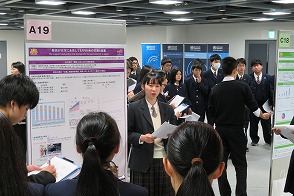 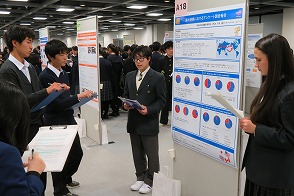 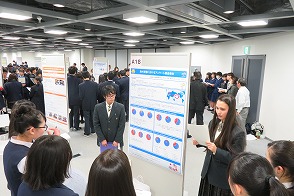 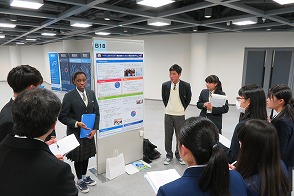 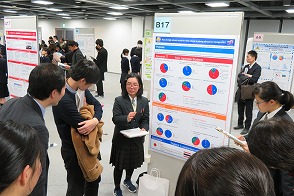 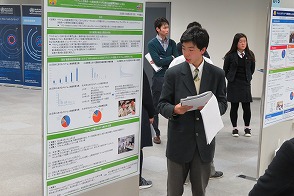 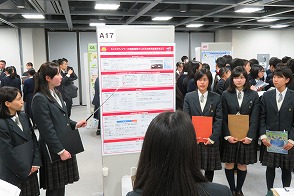 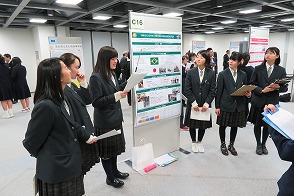 (Pictures) HIS students present their posters. 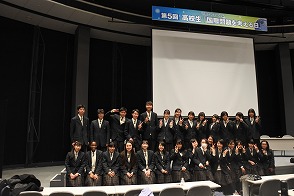 |
| 2018/ 2/3(Sat.) 1st year (15th) |
2018 SGH Fieldwork in One World Festival (1st year) The 2018 One World Festival (OWF) was held at Ogimachi Square of Kantere (Kansai TV) and the North Ward Community Center. All the first-year students from Hyogo Prefectural International Senior High School (HIS) conducted fieldwork there. In 2015, the United Nations held the Sustainable Development Summit and adopted 17 Sustainable Development Goals (SDGs). The 2018 OWF’s purpose was to share these 17 goals, and to offer a chance and a place to meet organizations and institutions, see information and people, and work in the future. The OWF is one of the largest events of this kind in Western Japan. More than 100 organizations including non-governmental organizations(NGOs), nonprofit organizations(NPOs), administrative offices, businesses, schools, and other education-related institutions had booths to inform participants of their efforts to promote international cooperation and to solve social issues. The HIS students’ objective was to conduct fieldwork with a chance to consider solving social issues such as immigration policy, which is their SGH research topic, and to imagine what Japan will be like in the future. The HIS students prepared questions to ask beforehand, asked them at related booths and took notes when they got answers. Some HIS students joined workshops and discussed world issues. The HIS students filled in their worksheets about what they learned. It was a very good chance for them to think about various kinds of issues which the global community is now facing. 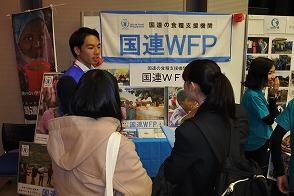 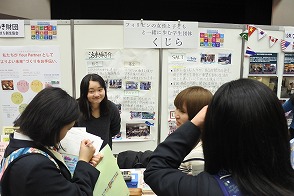 |
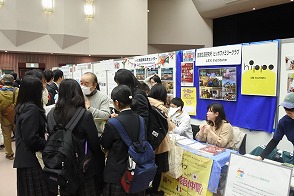 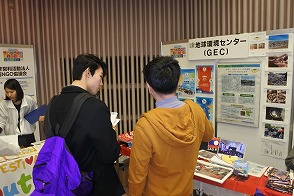 (Picture) |
| 2018/ 1/27(Sat.) 1st year (15th) |
2018 SGH Fieldwork in Ikeda~ Visit to ‘Poplar’ Special Nursing Home for
the Elderly(1st year) Nine first-year students from Hyogo Prefectural International High School(HIS) visited 'Poplar', a special nursing home for the elderly in Ikeda City. (Picture ①)Their main goals were to visit a nursing home which accepts care workers from overseas, to learn about the present situation of Japan’s nursing homes and migrant workers there, and to have a chance to consider whether Japan should accept more immigrants in the future. Another purpose was to visit the same nursing home as last year and learn about any changes in the employment of care workers from abroad. First, a staff member of Poplar explained some things about the facility. (Picture ②)As of this January the home employs 19 foreign care workers. Fourteen of them are care workers and care worker candidates from the Philippines. The rest are international students--three from Vietnam and two from Nepal. The number of foreign workers has increased largely from the ten care workers and care worker candidates from the Philippines that came through the Economic Partnership Agreement (EPA) last January. The staff member said that a new law was enacted a year ago and brought about a drastic change---it means that both care workers through the EPA and international students who are working as care workers could be accepted. The countries from which the workers are coming are spreading to other countries including Vietnam and Nepal. Now about sixty staff members are taking care of old people in Poplar. It has plans to increase the number of foreign workers from 19 to thirty in two years. One reason for this is that there will be a shortage of 400 thousand care workers in the year 2025, when most of the baby boomers born around 1949 reach the age of 75. The other reason is that there will be more and more old people with fewer children in the Japanese society, and it will cause a big shortage of care workers in Japan. Next, the HIS students interviewed the care workers at Poplar—two people from the Philippines who had passed the test to become the EPA care workers and four care worker candidates who came to Japan from the Philippines in December 2017. (Picture ③④⑤) When the workers from the Philippines were asked why they came to Japan, all of the EPA care worker candidates answered that they would like to become highly qualified care workers and help their families financially at home. When the HIS students asked the workers from the Philippines what were good things about coming to Japan, they answered that Japan is a safe and clean country, and workers in Japan are better paid. When the HIS students asked them, “What is troubling you in Japan?”, all of them answered that they found it difficult to understand the Kansai dialect of the Japanese language, because they learned standard Japanese at their language schools. When the people from the Philippines were asked whether they would like to work in Japan, or go back to the Philippines in the future, all of the EPA care worker candidates said that they would like to pass the EPA test and work in Japan. One reason for this is that there are not as many old people in their home country as in Japan, and there are fewer nursing homes, so that they would have fewer job opportunities back in the Philippines. Lastly, the HIS students looked around the facility. They learned a lot about the present circumstances of Japan’s nursing homes and foreign care workers. They will take advantage of their experiences there to carry on their SGH research. 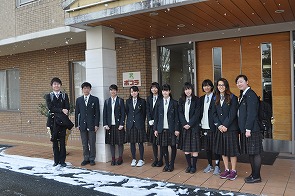 (Picture ①)The students visit the Poplar nursing home. |
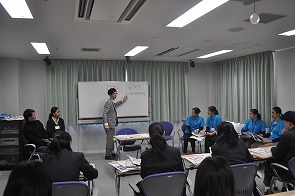 (Picture ②)The facility staffer explains Poplar. 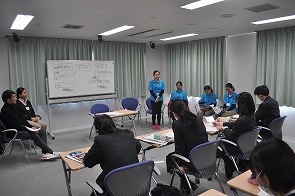 (Picture ③) Filipino EPA candidates are interviewed by the HIS students. 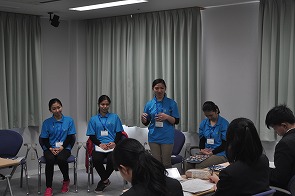 (Picture ④)The HIS students listen to the EPA candidates talk. 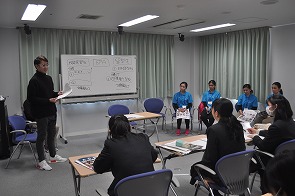 (Picture ⑤)A Filipino EPA care worker talks. |
| 2018/ 1/20(Sat.) 1st year (15th) |
SGH 2017 Meeting for Activities for Making Attractive & Unique School
Features (1st year) At Book Mark Square in Akashi City, the 2017 Meeting for Senior High Schools’ Activities for Making Attractive and Unique School Features was held. Hyogo Prefecture has been promoting this initiative, the senior high schools are each trying to create attractive and distinctive features under various projects with titles such as “Senior High School Students’ Activities Contributing to their Hometowns” and “Prefectural Senior High Schools’ Projects for Promoting Special Features” also called “Inspire High School.” Participants from all over Hyogo Prefecture talked about their activities and results. Three schools presented their activities on the stage. Twenty-eight high schools including Hyogo Prefectural International High School (HIS), represented by six first-year students, presented their activities in the poster session. The HIS students presented their considerations on Japan’s immigration policy based on results from a survey they conducted during their Thai Study Tour. Some HIS students went on a study tour to Thailand in November 2017 and asked Thai people questions about housekeepers. HIS students also conducted an awareness survey on how much demand there is for housekeepers in Japan. They used the results of these two surveys and made suggestions about Japan’s immigration policy in the presentation. After the presentation, there were questions from different schools’ students and teachers and other participants. The HIS students answered them one by one. They had a good opportunity to further their SGH research. |
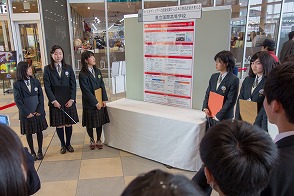 (Picture) Six first-year HIS students present their poster in a poster session. |
| 2018/ 1/17(Wed.) 2,3 year (14,13th) |
SGH 2nd Lunch-Hour Street Preaching-Style Open-Air Lecture(2nd, 3rd year) During the lunch hour on January 17, twenty-two second-year students gathered in a classroom and listened to a talk from a third-year student. These 22 second-year students have chosen ‘Language Skills’ as the school-wide set subject for the next year, and were learning how to write a thesis from a third-year student. The third-year student had finished writing her thesis in the class ‘’ Sharing a Vision of Japan’s Future”, and she gave the following points of advice: (1)read preceding research closely, and (2) collect enough data to base their assertions on evidence. Some second-year students asked her questions such as, “What should I do if I find data which contradicts my conclusion?” The third-year student answered their questions one by one. After giving advice, she encouraged the second-year students by saying, “Though I didn’t feel confident at first, I managed to write my thesis, so I am sure you can too. Keep working hard!” In this meeting, there were teachers in charge of the SGH projects and ‘Language Skills’. |
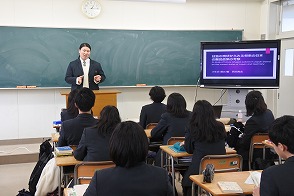 (Picture ) A third-year student gives advice to 22 second-year students. |
| 2017/ 12/23(Sat.) 1,2 year (15,14th) |
SGH:Research Festa at Konan University (1st, 2nd year) The Research Festa was held at the Okamoto campus of Konan University. One group consisting of six second-year students and another group with five first-year students from Hyogo Prefectural International Senior High School(HIS) participated in it. The second-year group presented their report, “Considering Japan’s refugee policy based on results of questionnaires given during the Vietnamese study tour”. It was found that a lot of Vietnamese people interested in working in Japan were worried about learning the Japanese language and adjusting to Japanese lifestyle. Based on the results, the HIS group suggested a plan to decrease their worries. The first-year group presented analyses and conclusion based on results of surveys given to Japanese and Thai students. In the surveys, they are asked how senior high school students in Japan and Thailand thought about studying and working overseas. Both groups of HIS students used English in their presentations and the question and answer sessions. Other high school students working on their SGH research along with university undergraduates and graduates joined the Research Festa. This was a good opportunity for HIS students because they learned about other schools’ research projects. |
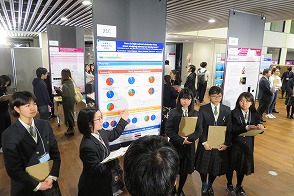 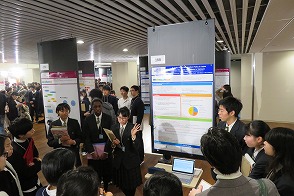 |
| 2017/ 12/19(Tue.) 1-3rd year (15-13th) |
2017 SGH Midterm Presentation of Research & Overseas Study Tour Presentation
(1-3rd year) First, HIS Principal Mr. Matsumoto made an opening speech.(Picture ①) Next, the HIS students gave midterm presentations about the result of SGH research on immigration with the following themes: 1.First-year students presented: (1)a report on a project to discover historical things about Japanese immigrants (Picture ②) (2)a report on a visit to two companies in Himeji during the summer vacation (3)a report on the making of World Migration Maps (Representative:Immigrants from Japan to Brazil) (Picture ③) 2.Second-year students presented: (1)a study of the immigration policy in Japan based on survey of students in Vietnam,(Picture ④) (2)a report on the results of surveys from their overseas study tours to America, Canada, and the U.K.,and (3)a report on the results of a survey of Vietnamese workers and a consideration on the techinical intern training program in Japan. (Picture⑤) 3.Third-year students presented: (1)a study of refugee policies in Japan in the future based on the current states of Japan and Germany,(Picture ⑥) (2)a proposal for a policy and a support system for immigrants in Japan so that they are motivated to stay in Japan permanently, (Picture ⑦) and (3)a relationship between the declining birthrates in aging societies and immigration issues in both Japan and Italy. (Picture ⑧) After the midterm presentation of research was over, the socond-year students talked about the study tour to three countries---the U.K., Canada, and the U.S. to help the first-year students choose one of the three countries 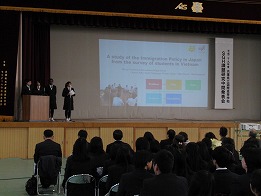 (Picture ④)Second years presents a study of the immigration policy in Japan based on the survey of students in Vietnam" 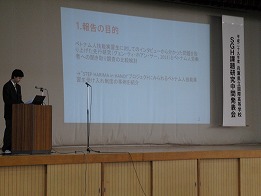 (Picture⑤)A second-year student presents a report on the results of a survey of Vietnamese workers 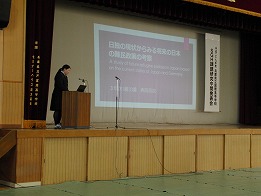 (Picture ⑥)A third-year student presents a study of refugee policies in Japan in the future. 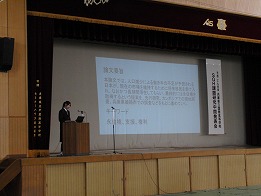 (Picture ⑦)A third-year student presents a proposal for a policy and a support system for immigrants in Japan. 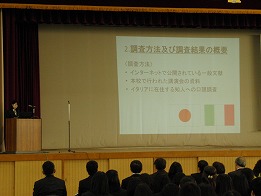 (Picture ⑧)A third-year student presents a relationship between the declining birthrates in a ging societies and immigration issues. |
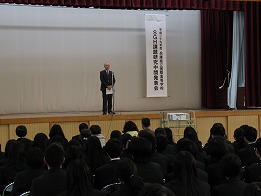 (Picture ①)Mr. Matsumoto, HIS principal, makes an opening speech. 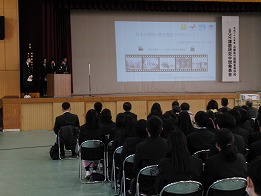 (Picture ②)First years report historical discoveries about Japanese immigrants. 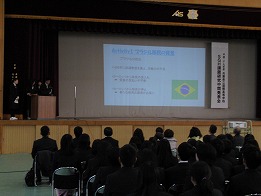 (Picture ③)A representative group shows a map about Japanese immigrants to Brazil. 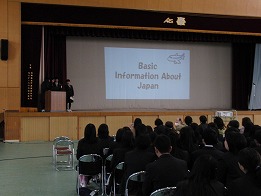 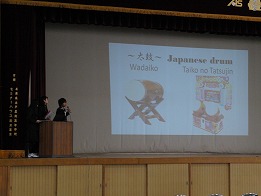 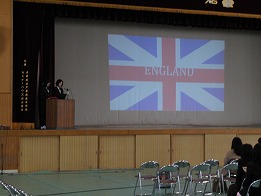 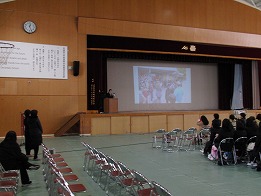 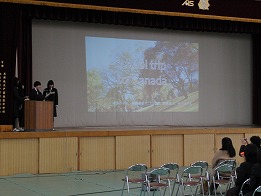 (写真⑨⑩⑪⑫⑬)The second-year students reorted on their overseas study tour to the U.K., the U.S., and Canada. |
| 2017/ 12/4(Mon.) 1st year (15th) |
SGH Project:Debate (Final) (1st year) The affirmative team, Group A from Class 2 ,and the negative team, Group B from Class 1, had the highest scores during the preliminary rounds, so they competed against each other in the final round of the debate. The theme of the debate was whether Japan should accept more immigrants than now. The affirmative side argued: 1. Japan should take in more immigrants to globalize itself more. 2. More immigrants in Japan mean easing the aging of society and stopping Japan’s population from declining. 3.The immigrants can become successors to businesses and stimulate its economy . The negative side argued: 1. Social order can be disturbed by accepting more immigrants in Japan. 2. Accepting more immigrants means more trouble and cost . 3.The immigrants’ human rights are not guaranteed now. Both teams showed their own evidence to support their arguments, and debated each other. The other first-year students and two professors from Kwansei Gakuen University judged the debate, and the negative side won. After the debate, two special judges, Professor TOBA Mirei from the School of Sociology at Kwansei Gakuin University and Associate Professor NAGATOMO Jun from the School of International Studies at Kwansei Gakuin University commented on the debate. Professor Toba said it was good for the affirmative side to show references to their citations on their presentation slides, and that the negative side should have done it too. She also commented that it was better for the negative side to offer an argument that public security and peace would be threatened, instead of saying that social order would be disturbed. Associate Professor Nagatomo said that it was good for both sides to develop their arguments objectively by using their citations, but it would be better for them to use numbers from their citations. He also added that the affirmative side should have used successful examples of the point systems in the U.S. and Canada. 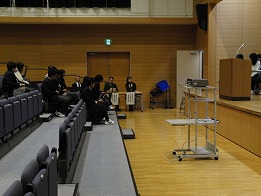 |
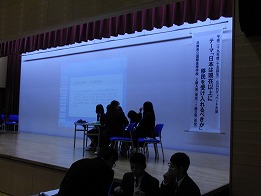 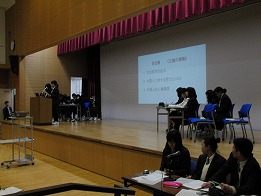 |
| 2017/ 12/2(Sat.) 1,2 year (15,14th) |
2017 Study Tour at Winter Conference of JAMPS(1st, 2nd year) The 2017 Winter Conference of Japan Association for Migration Policy Studies (JAMPS) was held at Nanzan University. Six first-year and second-year students from Hyogo Prefectural International High School(HIS) took part in it. First, they participated in free presentations, and listened to a lot of researches about immigration in different countries. They learned a lot from each presentaion. Next, a joint session between JAPMS and high schools was held, and an HIS second-year student presented a report titled, ‘A Study of Technical Internship Programme in Japan Based on a Survey of Vietnamese Workers: Acceptance of Foreign Workers through the "STEP HARIMA in HANOI" Project.’ Through the “STEP HARIMA in HANOI” project, the Vietnamese technical intern trainees were employed and the HIS students asked them questions during the Fieldwork in Himeji project. He compared the results of the questionnaire given by HIS students to Vietnamese workers and the results of a preceding piece of research. About 20 people participated in the session. After the presentation, there were a lot of questions such as: “How did the HIS students interview the Vietnamese workers?” and “How did the HIS students find the preceding research?” The HIS student answered each question. At the same time, the HIS students received a lot of advice from the participants and learned a lot. Lastly, the HIS students joined a symposium on a reexamination of the institutional structures of the refugee policy in the Nagoya and Tokai Area. A refugee assisting organization reported the current situation of refugees and refugee applicants. Lawyers reported on a trial for the recognition of the refugee status. Also a Nepalese person recognized as a refugee talked about how he achieved this status. The HIS students had a good opportunity to consider accepting refugees in Japan. Mr. Maekawa, a teacher in charge of the HIS SGH research, would like to extend his heartfelt appreciation to JAMPS for giving HIS students a third chance to report their research in a conference setting. They will surely keep working hard on their projects and make full use of these experiences. |
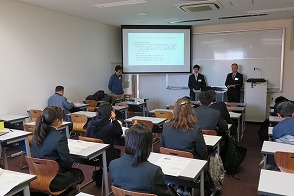 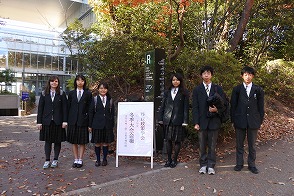 |
| 2017/ 11/30(Thu.) 1-3 year (13-15th) |
SGH Special Lecture: Aiming to make a ‘being with’ type of society (1st-3rd
year) Specially Appointed Professor NISHITANI Osamu from the Graduate School of Arts, Field of Study at Rikkyo University gave an SGH special lecture to all Hyogo Prefectural International High School (HIS) students. He talked about how to design a Japanese society in the future by trying to construct what he calls a ‘being with’ type of society, where all people coexist with each other. His main points were: ①how to design Japan’s future society ②what will happen to society in the present if people do nothing about current issues and let things continue as they are ③the meaning of ‘being with’ and existing through conections to other people, and ④ the realities of the modern world and changing the direction of society in the future. He answered several questions during the question and answer session that followed his lecture. One student asked him what HIS students should do if they would like to help to make a ‘being with’ type of society. Mr. Nishitani answered that they should join HIS activities eagerly, because one of the HIS educational goals is to coexist or ‘be with’ other people. 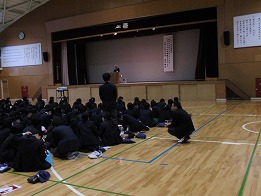 |
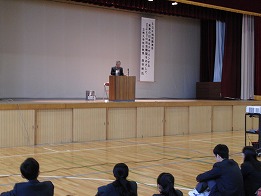 |
| 2017/ 11/25(Sat.) 2nd year (14th) |
2017 SGH Senior High School Students' National Forum |
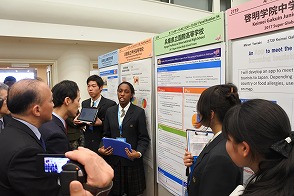 (Picture) |
| 2017/ 11/5(Sun.) 1st year (15th) |
SGH 2017 Thai Study Tour (Day 3) |
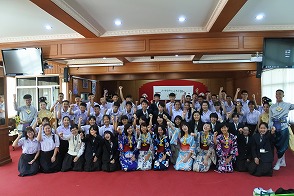 (Picture ①)HIS students visit Maesaiprasitsart School. 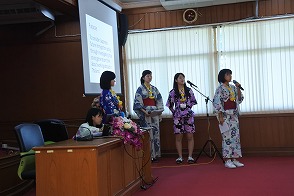 (Picture ②)HIS students showed a Bon dance while wearing Yukata. |
| 2017/ 11/4(Sat.) 1st year (15th) |
SGH 2017 Thai Study Tour (Day 2) |
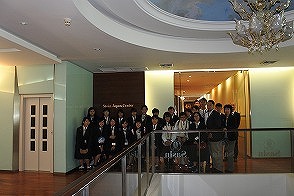 (Picture ①)HIS students visit the Sasin Japan Center (SJC). 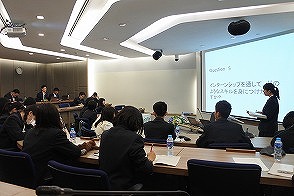 (Picture ②)HIS students asks questions about the internship. |
| 2017/ 11/2(Thu.) 11/3(Fri.) 1st year (15th) |
SGH 2017 Thai Study Tour (Day 1) |
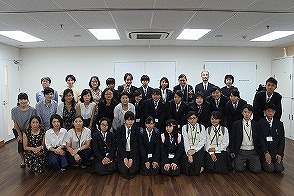 (Picture ①) HIS students meet JAT members. 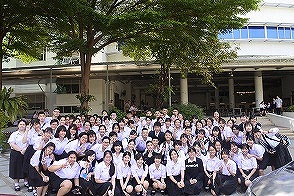 (Picture ②) HIS studnets meet PSDS students. 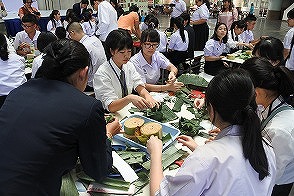 (Picture ③) HIS and PSDS students make lanterns for Loy Krathong festival. 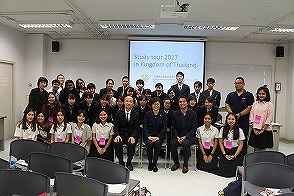 (Picture ④) HIS students visit TNI. |
| 2017/ 11/4(Sat.) 1st & 2nd year (15th & 14th) |
SGH 2017 High School and University Collaborative Research Joint Presentation
at Kyoto University (1st & 2nd year) |
 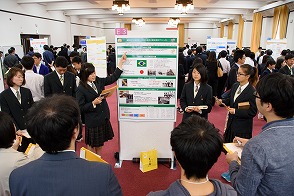 |
| 2017/ 10/30(Mon.) 1st year (15th) |
SGH Lecture: Advice on Debate as to whether
Japan should accept more immigrants than now (1st year) |
 |
| 2017/ 9/29(Fri.) |
The result of the SGH mid-term evaluation of HIS by MEXT SGH In-house Promotion Committee Chairman MAEKAWA Hiroshi The Ministry of Education, Culture, Sports, Science and Technology (MEXT) has disclosed the results of the mid-term evaluation of the Super Global High Schools (SGH) which were designated in 2015. Hyogo Prefectural International High School (HIS) was evaluated with a rating of ‘A’ , the second highest following ‘S’. The ‘A’ level means that HIS is highly likely to achieve its research goal by continuing to put in effort. We would like to thank everyone concerned for your support and cooperation. HIS is going to keep on working on its research. For further information, please visit the website at: http://www.mext.go.jp/b_menu/houdou/29/09/1396726.htm |
|
| 2017/ 9/26(Tue.) |
SGH 2017 Fieldwork in Multicultural Children's Center (2nd & 3rd year) One 3rd-year student and five 2nd-year students from Hyogo Prefectural International High School (HIS) interviewed staff members at the Multicultural Children’s Center, which is located on the same campus as HIS. The main objective of interviewing the staff was to learn about the present level of support for foreigners provided by Hyogo Prefecture. The students learned that the center now mainly works on 4 projects. One of them is a project to send supporters to all students between the ages of 6 and 18 at elementary school, junior and senior high schools who have lived in Hyogo Prefecture (excluding Kobe City) less than a year and ask for support. The supporters help them with their mental health, their education, and career guidance. Through the interview, the HIS students learned a lot and had a good experience. They hope to go on with their research by utilizing the results from the interview. |
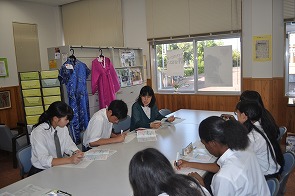 |
| 2017/ 8/28(Fri.) 2nd year (14th) |
2017 Study Tour at Kwansei Gakuin University (2nd year) Four second-year students from Hyogo Prefectural International Senior High School (HIS) participated in the 2017 Study Tour at Kwansei Gakuin University. The main purpose of the HIS students’ attendance was to present their poster, which describes what they did during the first term, to Mr. Nagatomo, an associate professor at Kwansei Gakuin University. They were also given a chance to deepen their understanding of immigration studies by asking Mr. Nagatomo questions. First, the HIS students made a presentation about Japan’s good points, including the aim to have all races and different cultures living peacefully together. (Picture ①)Then, they asked Mr. Nagatomo questions, and they discussed the topic with him. (Picture ②) It was a good chance for the HIS students to get a deeper understanding of the theme. 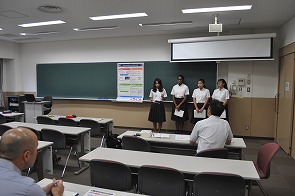 (Picture ①)HIS students present their report. |
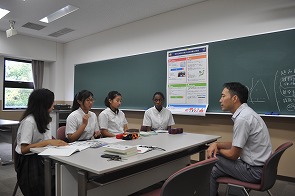 (Picture ②) HIS students talk with Mr. Nagatomo. |
| 2017/ 8/25(Fri.) 1st year (15th) |
2017 SGH Fieldwork in Himeji (1st year) Sixteen students from Hyogo Prefectural International High School (HIS) participated in the 2017 SGH Fieldwork in Himeji. This was the third trip to Himeji. Its purpose was to visit companies in Himeji which employ Thai technical intern trainees, to examine the present situation of the Thai workers, and to think about what should be done in the future. The chief executive officer (CEO) at Shinwa Industrial Co., Ltd. Mr. WATANABE Yosuke, two Thai technical intern trainees employed by Shinwa, the manager of the technical department at Sanko coating Co. Ltd. Mr. YAMANAKA Sunao, two Thai technical intern trainees working at Sanko, and the director of Kansai Metal Industry Cooperative, Mr. SEKI Mitsuhiro attended the meeting. Mr. Watanabe from Shinwa Industrial Co. Ltd. talked extensively about the process they went through before accepting the technical intern trainees from Thailand. First, he got a repor tfrom a Thai training agency on how they had learned the Japanese language and how they prepared for work. Then he went to the agency in Thailand to explain his company, and finally he decided to employ the trainees. Next, the HIS students went to observe a factory owned by Shinwa Industrial Co., Ltd. They saw the Thai trainees welding. Then the HIS students went back to a conference room to listen to the director of Kansai Metal Industry Cooperative, Mr. SEKI Mitsuhiro. He talked about how his company took in foreign trainees. Lastly, the HIS students asked the Thai trainees a lot of questions, and the Thai workers answered them. It was a very good chance for the HIS students to learn about the present situation of the technical intern trainees from Thailand. 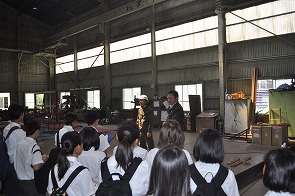 |
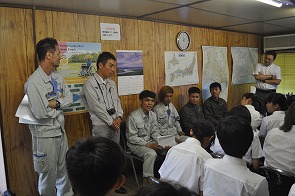 |
| 2017/ 8/9(Wed.) 1st year (15th) |
2017 SGH Fieldwork in Kobe (1st year) Fourteen first-year students from Hyoro Prefectural International High School (HIS) participated in the 2017 SGH Fieledwork in Kobe. First, they arrived at JR Motomachi station and walked from the immigrant facility to Kobe port to the Kobe Center for Overseas Migration and Cultural Interaction. The route was used by actual immigrants. At the center, Mr. Amatatsu gave the HIS students a lecture on the history of immigrants who came to and left from Kobe. After the lecture, they went down to the migration museum on the first floor, and Mr. Amatatsu explained the exhibition. He talked about how to collect immigrants in Japan, and how they prepared for overseas trips. Then he described what they experienced before going abroad, during the voyage, and after arrving at their destinations. Lastly, the students moved back to the lecture room and summaraized what they learned from the fieldtrip. 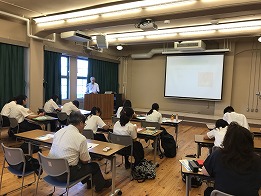 |
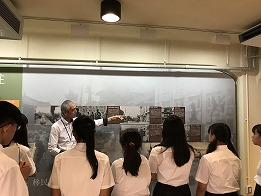 |
| 2017/ 7/19(Wed.) 1st-3rd year (13-15th) |
SGH Special Lecture: ”Foreigners”living in Japan today--aiming to make
a society where all live peacefully together (1st-3rd year) Professor SUZUKI Eriko from the Department of Literature at Kokushikan University gave an SGH special lecture to Hyogo Prefectural International High School (HIS) students. She talked about the present situation of "foreigners (people of foreign origins in Japan)" and what should be done to make a society where "foreigners" and Japanese live peacefully together. Her main points were: ①multiculturalization in Japan ②"inequality" and "foreigners" ③ "foreigners" in the labor market ④ education for children of foreign roots, and ⑤ living peacefully together. She answered several questions during the question and answer session that followed her lecture. 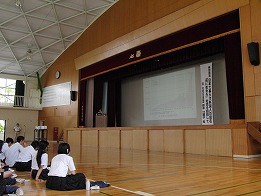 |
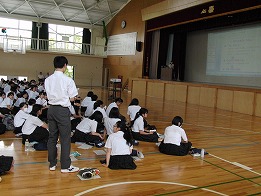 |
| 2017/ 7/10(Mon.) 1st year (15th) |
SGH Study Tour @ Kobe University 2017 (1st year) On July 10th, all of the Hyogo Prefectural International High School (HIS) 1st-year students went on study tours. 120 HIS students were divided into three groups of 40. One group of 40 students attended an SGH study tour at Kobe University. (Picture ①) In the morning, they learned about the university. Some HIS graduates who are now students at Kobe University came to talk with and encourage the first-year students. (Picture ②) After that, they went to see the university’s library. In the afternoon, KARASHIMA Masato, an associate professor of the Faculty of Intercultural Studies at Kobe University, gave a lecture on immigration studies. (Picture ③) After the lecture, there was a question and answer session, which was a good chance to deepen the students’ understanding about immigration studies. 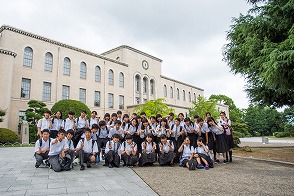 (Picture ①) 40 HIS students go to Kobe University. |
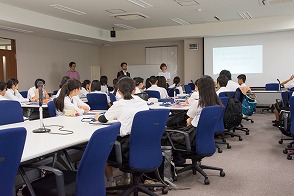 (Picture ②)HIS graduates encourage HIS students.  (Picture ③)HIS students learn about immigration. |
| 2017/ 7/10(Mon.) 1st year (15th) |
SGH Study Tour @ Ritsumeikan University 2017 (1st year) On July 10th, 120 Hyogo Prefectural International High School (HIS) first-year students were divided into three groups of 40, and they went on study tours. One of the groups who went to Ritsumeikan University (Rits) got a lecture from YONEYAMA Yutaka, a professor of the Department of Literature at Ritsumeikan University.(Picture ①) He talked about immigration history, especially, of the Japanese immigrants to the U.S. After the lecture, a question and answer session was held, and it deepened the students’ understanding about immigration. In the afternoon, they toured around the campus of the university.(Picture ②) 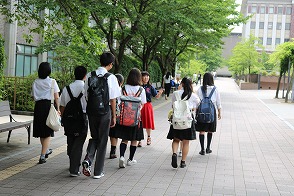 (Picture ②) HIS students tour around Rits. |
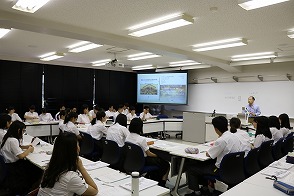 (Picture ①)40 HIS students learn about immigration at Rits. |
| 2017/ 7/10(Mon.) 1st year (15th) |
SGH Study Tour @ National Museum of Ethnology (1st year) On July 10th, 40 students of Hyogo Prefectural International High School (HIS) went on a study tour to National Museum of Ethnology (NME). (Picture ①) In the morning, they got a lecture from MISHIMA Teiko, an associate professor of the Department of Globalization and Humanity. (Picture ②) She talked about “moving people”. Since the students were making immigration maps, it was a good chance for them to think about why people were moving. Later, the students went around the museum, and studied about the various cultures of the world. (Picture ③) 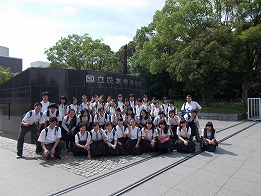 (Picture ①) 40 HIS students visit NME. |
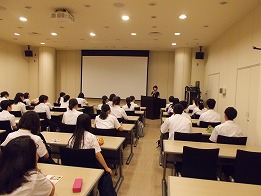 (Picture ②) HIS students learn about "moving people". 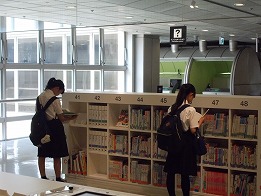 (Picture ③)HIS students study about the world's cultures. |
| 2017/ 6/16(Fri.) |
The 2017 Liaison Council of SGH The first 2017 Liaison Council of Super Global High School (SGH) was held at Ochanomizu University, and the bunkyo school building on the Tokyo Campus of Tsukuba University. About 350 people from 123 SGH schools, 56 SGH associate schools, and several education board members participated. In the third part of the meeting, the participants were divided into 11 groups and teachers from 22 SGH schools presented reports to their sub group. Mr. Maekawa, a senior teacher from Hyogo Prefectural International High School (HIS), reported the results of its SGH research. He talked about how the HIS students made migration maps, joined study tours and fieldwork in and outside Japan, studied in specially tailored school subjects, and participated in an academic conference. |
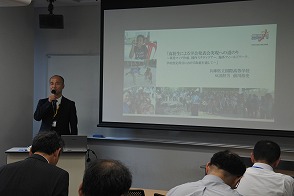 |
| 2017/ 6/15(Thu.) 1, 2 year (14th,15th) |
SGH Lunch-Hour”Street Preaching ” (1st & 2nd year) During the lunch hour, four second-year students, and 24 first-year students who were the leaders of migration map groups gathered in the central hallway, and the first 'street preaching' was held. The purpose of this activity was that the second-year students who made migration maps and reported them last year would share their ideas with the first-year students. (In fact, they did not 'preach' but gave some advice.)(Picture ①) First, the second-year students showed how to make a presentation about migration maps and what they thought about them, and then advised the first-year students about the procedures. The first-year students listened to the advice attentively. (Picture ②) 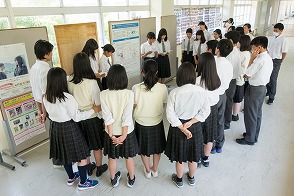 (Picture ② |
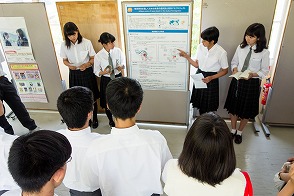 (Picture ①) |
| 2017/ 6/5(Mon.) 1st year (15th) |
SGH Lecture: The Importance of Migration Studies--What Can We Learn by
Making Migration Maps? (1st year) Associate Professor NAGATOMO Jun from the School of International Studies at Kwansei Gakuin University gave an SGH lecture to Hyogo Prefectural International High School (HIS) 1st-year students. He lectured on the importance of migration studies, and what the students can learn by making migration maps. First he talked about the definitions of 'immigrants and migrants' in social studies---the specific term 'immigrants' mean people who aim to live in another country forever, and 'migrants' mean people who move to another country temporarily including international students. Next he talked about different views ofimmigrants and different immigration policies in other countries. Lastly he talked about why migration studies are important. He said people can get rid of biased views of immigrants after studying about immigrants, and they can also form their own opinions about them. Mr. NAGATOMO answered some questions from HIS students after the lecture.  |
 |
| 2017/ 5/28(Sun.) 2,3 year (14th, 13th) |
SGH Study Tour at 2017 Annual Conference of JAMPS (2nd & 3rd year) The 2017 Annual Conference of the Japan Association for Migration Policy Studies (JAMPS) was held at Seijo University, Tokyo. Two second-year students and eight third-year students from Hyogo Prefectural International High School(HIS) took part. In interest group B, a third-year student Ms. MINEYAMA and an HIS senior teacher Mr. Maekawa presented a report on the relationship between an aging society with fewer children and immigration problems in Japan and Italy. 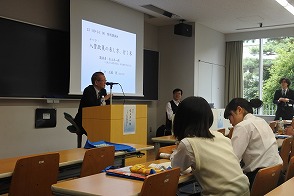 Click here for the JAMPS website: |
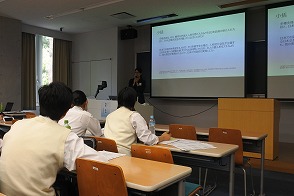 |
| 2017/ 5/24(Wed.) 1,2 year (15th, 14th) |
SGH Report on Study Tour in Vietnam (1st & 2nd year) Twenty-one students from Hyogo Prefectural International High School (HIS) who had participated in the study tour in Vietnam in November in 2016 reported on it to 1st-year and 2nd-year students. They presented an introduction of Japanese culture and their school, and the results of their research at schools they visited. They also talked about Vietnamese towns and culture. In the end of the report, Thailand was announced as the destination of the next study tour abroad. 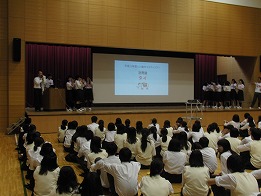 |
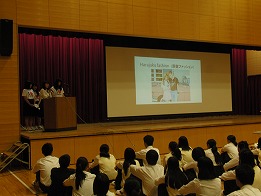 |
| 2017/ 5/1(Mon.) 1st year (15th) |
SGH Keynote Lecture: In Starting Immigration Studies--Why Are Immigration
Studies Important?(1st year) Professor MINAMIKAWA Fuminori from the College of International Relations at Ritsumeikan University made a keynote speech to Hyogo Prefectural International High School (HIS) 1st-year students. He lectured on what is important when they start immigration studies. He talked about international immigrants in the modern world and what immigration studies are about. Later, he answered some questions asked by HIS students. 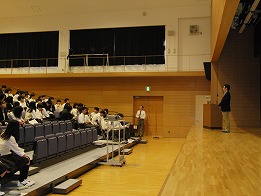 |
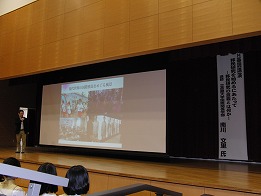 |
| 2017/ 3/19(Sun.) 1st, 2nd year (13th, 14th) |
SGH Koshien 2017 (1st & 2nd year) On March 19, SGH Koshien 2017, a national Super Global High School (SGH) research presentation conference was held at the Nishinomiya-Uegahara Campus of Kwansei Gakuin University (KGU). Twenty-four students from Hyogo Prefectural International High School (HIS) participated in it. (Picture ①) One group made an oral presentation, three groups made poster presentations, (Picture ②)and one student participated in a group discussion. The students who took part in the oral presentation and group discussion had been selected after passing the first screening. The students from HIS presented their SGH reports on immigration research. The oral presentation group gave their report in English. (Picture ③)After the presentations, the HIS students got a lot of feedback and advice from people all over Japan, and watched other SGH school students present their SGH research. It was a very productive and educational day for them.  (Picture ②)An HIS group makes a poster presentation. |
 (Picture ①) 24 HIS students join SGH Koshien 2017.  (Picture ③)An HIS group presents its immigration research in English. |
| 2017/ 2/18(Sat.) 1st year (14th) |
SGH Study Tour in Tokyo 2017 (2nd day) (1st year) In the morning, the HIS students went to Tokyo Gakugei University International Secondary School (TGUISS) and watched four presentations of Super Science High School (SSH) research and four presentations of Super Global High School (SGH) research. Every research was good and solid because they included preceding research, research, analysis, and consideration. The HIS students learned a lot from the persuasive presentations which used a variety of data. After having lunch with TGUISS students, the HIS students presented reports on their fieldwork in Himeji, the study tour to Vietnam, and the migration maps. (Picture 1) Next, the TGUISS students presented their report about halal dishes in Japan and proposed better halal foods for Muslims in Japan. It was an interesting and impressive presentation. Lastly, the HIS students and the TGUISS students engaged in group work to propose an immigration policy Japan should adopt in the future, and commit it to paper after exchanging their ideas. (Picture 2) It was a stimulating chance for the HIS students to carry on their research. |
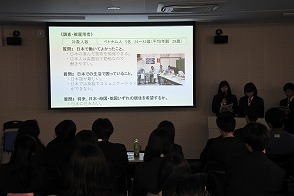 (Picture 1) HIS students present their reports. 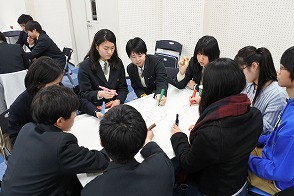 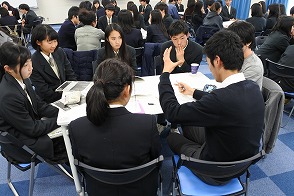 (Picture 2) HIS and TGUISS students exchange ideas to propose a better immigration policy. |
| 2017/ 2/17(Fri.) 1st year (14th) |
SGH Study Tour in Tokyo 2017 (1st day) (1st year) Thirty-six first-year students from Hyogo Prefectural International High School(HIS) participated in the 2017 Super Global High School (SGH) study tour in Tokyo. (Picture 1) Their goal was to study immigration by discussing the issue with a university researcher and students from other SGH schools. First, the HIS students visited the Tokyo Institute of Technology (TIT), and listened to the introduction of the university.(Picture 2) Next, they went on a campus tour to visit facilities including the library. Then, the HIS students presented immigration reports. (Picture 3) Associate Professor SATO Yuriko asked questions and the HIS students answered them. The HIS students talked about their reports on the fieldwork in Himeji, the study tour to Vietnam, and the fieldwork in Ikeda. The students who had participated in these activities all made their presentations that day. Ms. Sato made comments and gave advice after the presentations. Next Ms. Sato presented an outline of the world policies about accepting international students and highly skilled workers, and the difference in policies between Japan and Germany. (Picutre 4) She answered questions from the HIS students after her presentation. They learned a lot from the activities. 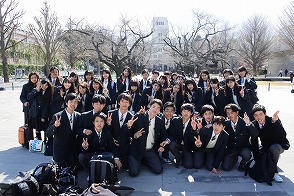 (Picture 1)36 1st-year students of HIS participate. |
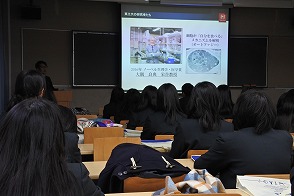 (Picture 2) HIS students listen to TIT introduction. 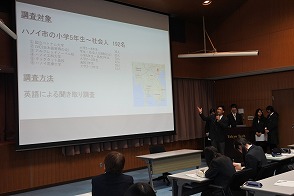 (Picture 3) HIS students present their reports. 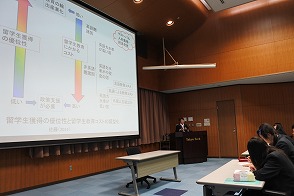 (Picutre 4)Ms. Sato presents Japan-Germany policies. |
| 2017/ 2/11(Sat.) 1st, 2nd year (14th, 13th) |
SGH:Hyogo-Kobe World Meets for YOUTH (1st & 2nd year) The fourth Senior High School Students' Day for Thinking about International Issues, Hyogo-Kobe World Meets for YOUTH, was held at Kobe International Exibition Hall, and thirty 1st-year and 2nd-year Hyogo Prefectrual International High School (HIS) students participated. In the morning, a keynote speech was made and a panel discussion was held, and in the afternoon, the HIS studnets met with members of international groups, and joined a poster session. One of the 2nd-year HIS groups talked in English about what kind of migration policy Japan should take in the future with a poster. Another group presented a report on their fieldwork in Cambodia, and the other group made a poster presentation about their study tour abroad. One of the 1st-year HIS groups talked about their survey of Vietnamese people who worked abroad, and another talked about their project of immigration and emigration maps. In addition, two other groups including the JRC (Junior Red Cross) club, and some students taking a lesson of International Volunteer Study, one of the HIS international subjects, also made presentations, showing their posters.They answered questions from the audience and discussed some issues. The HIS students learned a lot from their activities. |
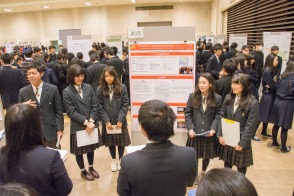 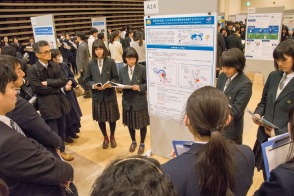 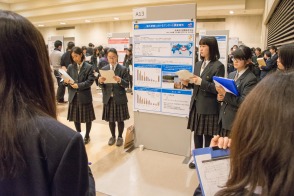 |
| 2017/ 1/28(Sat.) 1st year (14th) |
SGH Fieldwork in Ikeda~ A Visit to ‘Poplar’ Ikeda Satsuki-kai Special Nursing Home for the Elderly(1st year) Nine first-year students from Hyogo Prefectural International High School (HIS) visited Poplar, a special nursing home for the elderly, in Ikeda City. The HIS students wanted to visit one of the nursing homes which have accepted care worker candidates from the Philippines through the Economic Partnership Agreement (EPA) and learn about the present situation of Japan’s nursing homes and migrant workers there. They interviewed 5 Filipino women at the nursing home. First, Mr. Itamiya, the chief director of Poplar, explained this facility, and answered questions from the HIS students. Next, the HIS students interviewed five Filipinos working for Poplar, using both English and Japanese. They asked the workers how they felt about working in the nursing home and what they were planning to do in the future. The HIS students got detailed answers from the Filipino workers, and were able to learn a lot about the present situation of the migrant workers there. They are going to report on the fieldwork and take advantage of their experience in other SGH activities. |
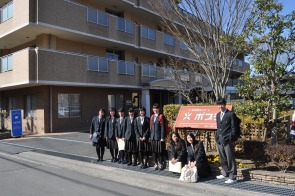 (Picture①)HIS students visit Poplar Nursing Home. 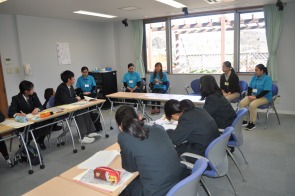 (Picture②)9 students interview Filipino care workers. 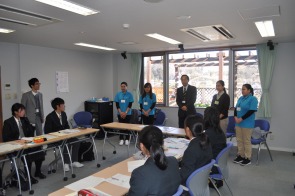 (Picture③)Chief Director Iyamiya introduces Poplar. |
| 2016/ 12/19(Mon.) 1st, 2nd year (14th, 13th) |
SGH 2016 Midterm Presentation of Research &C.C.C. Presentation (1st & 2nd year) In 2016 Super Global High Schol(SGH) midterm presentation of research, the 1st-year and the 2nd-year students presented results on migration. Also, the 2nd-year students talked about their overseas study tour in Communication, Cultural Understanding, and Contribution(C.C.C) presentations. Those presentations were given at the International Exchange Hall of Hyogo Prefectural International High School(HIS). First, HIS Principal, Mr. Akimune and a supervisor at Hyogo Prefectural Board of Education Ms. Matoba made an opening speech.(Picture ①②) Next, SGH in-house promotion committee Chairman Mr. Maekawa outlined the Super Global High School (SGH) project of HIS.(Picture ③) Then, the first-year students gave midterm presentations about the result of SGH research on migration: (1)a report of a debate (in Japanese) about migration in the 1st-term (Picture ④) (2)a report on a visit to two companies in Himeji during the summer vacation (3)a report on the making of World Migration Maps in the second term (Representatives: (A)New Zealand (B)Kenya (C)Vietnam)(Picture ⑤) (4) a report on a study tour to Vietnam in November Next, the second-year students presented results on migration: (1)a report on the study tour to Cambodia in November last year (2)High School Summit and joint presentations of high-school and university through collaborative research at Kyoto University (3) a report on the 2016 Winter Conference of Japan Association for Migration Policy Studies in December (Picture ⑥)(4) a report on the study tour to three countries After the midterm presentations of research was over, the socone-year students talked about the study tour to three countries---the U.K., Canada, and the U.S.(Picture ⑦) to help the 1st-year students choose one of the three countries. 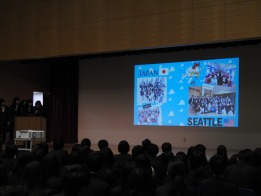 (Picture⑥)Reports on their study tour |
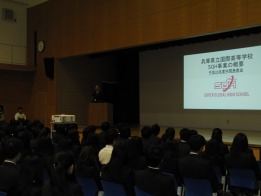 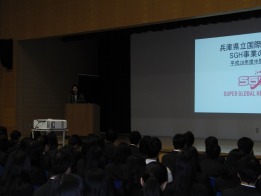 (Picture①)HIS Principal (Picture②)Supervisor Matoba 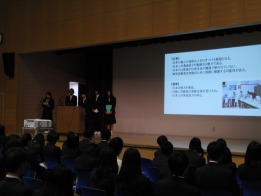 (Picture③)A report on the debate 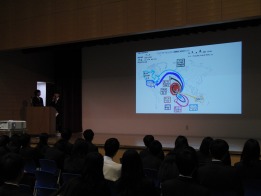 (Picture④)A report on World Migrant Map 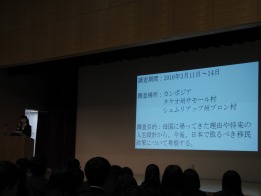 (Picture⑤)A report at JAMPS |
| 2016/ 12/3(Sat.) 1st ,2nd year (14th, 13th) |
SGH Study Tour at 2016 Winter Conference of Japan Association for Migration
Policy Studies(1st & 2nd year) The 2016 Winter Conference of Japan Association for Migration Policy Studies (JAMPS) was held at Kobe College, and four first-year students and six second-year students from Hyogo Prefectural International High School(HIS) took part in it. In free presentations, a second-year student, MANDOKORO Nanoha, presented a report on the results of a questionnaire she had addressed to some Cambodian people during the study tour to Cambodia on March 2016. She also suggested what kind of migration policy Japan should take in the future. In the following question and answer session, participants asked questions about the analysis and the consideration of the present situation in Cambodia, and the situation in Japan as well. This was the first presentation Ms. MANDOKORA made in the academic conference, and she seemed rather tense, but she was able to answer the questions well. The other nine students from HIS participated in a symposium on the challenges around the issues of diversity and inclusion (D&I) in accepting foreign workers from the point of view of the business sector. The HIS students asked the panelists how Japan should send out the information on an improved situation in accepting more foreign workers. Each student seemed to have learned a lot from participating in this conference. 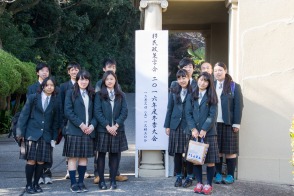 (Picture①)10 students from HIS |
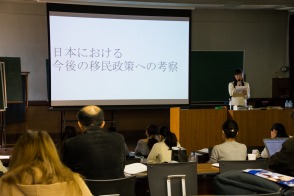 (Picture ②)Ms. Mandokoro reports at free presentations. 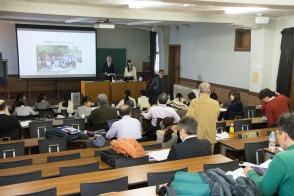 (Picture③)Q & A session |
| 2016/ 11/24(Thu.) 1st, 2nd year (14th, 13th) |
SGH Special & Human Rights Lecture (1st & 2nd year) The 2016 SGH Special & Human Rights Lecture was held and all the students at Hyogo Prefectural International High School (HIS) attended it. The lecturer Mr. MIYAJIMA Takashi, a professor emeritus at Ochanomizu University, talked about what kind of multicultural society Japan should be from the viewpoint of migrant studies. He lectured on: (1)why Europe became "a new migrant continent", (2) four types of migrant, (3) change from migrants to settlers, (4)how migrants were integrated in society, (5) change from migrants to citizens--how citizenship is considered in the West, (6) multiculturalism and its problems (7) Japan's "internationalization" and its realization (8) Japan facing migrants and the minority (in the 1980s), (9) Japan starting to accept foreign workers (in 1990), (10) why Japan doesn't take in foreign workers by the front door, (11) migrant women's human rights and workers' rights (12) an increase in permanent foreign residents and settlers, and (13) aiming to live in a multicultural society. Mr. Miyajima answered questions from HIS students after the lecture. |
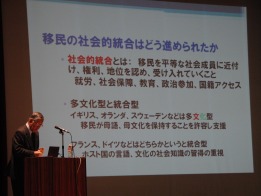 (Picture①)Mr. Miyajima gives a lecture. 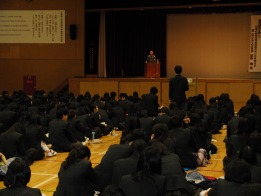 (Picture②)A student asks a question. |
| 2016/ 11/6(Sun.) 1st, 2nd year (14th, 13th) |
SGH 2016 High School and University Collaborative Research Joint Presentation
at Kyoto University(1st & 2nd year) The high school and university collaborative research joint presentation in 2016 was held at Kyoto University Clock TowerCentennial Hall. About 120 students from high schools in Hyogo prefecture and five teachers and about 40 students from Kyoto University and Kyoto University graduate schools took part. Five first-year students, 11 second-year students, and four teachers from Hyogo Prefectural International High School(HIS)participated in it. Mr. KISHIMOTO Masashi, an assistant professor at Kyoto University Graduate School of Engineering Department of Aeronautics and Astronautics gave a memorial lecture on energy problems. Then, all groups made a one-minute presentation about their posters and a poster session was followed. The HIS first-year group reported in Japanese on: (1)debate about immigrants, and (2) a visit to companies during the summer vacation. The HIS second-year A group reported in Japanese on fieldwork in Cambodia, and the HIS second-year B group reported in English on a vision of Japan which is aiming to live harmoniously in a multicultural society in the future. In a group discussion after the poster session, HIS students and Kyoto University students discussed issues about migrant studies. |
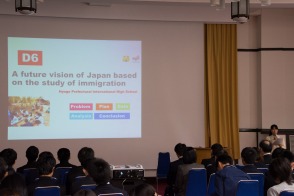 (Picture①)One-minute presentation on the poster 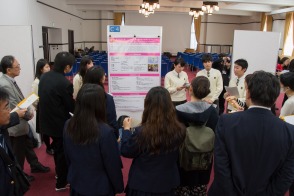 (Picture②)A poster session |
| 2016/ 11/6(Sun.) 1st year (14th) |
SGH Study Tour in Vietnam(5th day)(1st year) The HIS students visited these schools, and had a very good experience of meeting and talking with a lot of Vietnamese people. They left Hanoi Airport, and flew via Ho Chi Min to Kansai International Airport on November 6th. |
|
| 2016/ 11/5(Sat.) 1st year (14th) |
SGH Study Tour in Vietnam (4th day)(1st year) In the morning, the HIS students visited Thach That High School. They met twenty eight first-year students. (Picture ①) The HIS students again gave their presentation and interview. Three of the students were interested in working in Japan. Three more answered that they would be interested if they were assisted in communicating in Japanese. Another three students said that they would be interested in working in Japan if Japanese people understood English better. 17 of them answered that they would like to study in Japan, because some loved Japanese anime, or fashion, and some said that Japanese people were kind. The percentage of the Vietnamese students who were interested in working in Japan was low, probably because the number of the students who were learning the Japanese language was small. After the questions, they talked with each other. Some Vietnamese students played their favorite Japanese songs on their smartphones. The HIS students danced wearing yukata. (Picture ②)Many of the Vietnamese students seemed to be interested in yukata. In the afternoon, at a hotel in the city, the HIS students asked 12 Hanoi Medical University nursing students some questions.(Picture ③) First, a university teacher gave the HIS students a lecture on the present situation of medical service in Vietnam and in Japan. The HIS students again gave their presentation. In the interview, seven of the medical students answered that they were interested in working in Japan. The HIS students reported the present situation about nurse candidates under the Economic Partnership Agreement (EPA). The HIS students mentioned a difficult situation for nursing candidates, showing that only about ten percent of the candidates pass the National Nursing Examination every year. After the presentation, the HIS students asked them if they would like to come to work in Japan despite the difficult situation; Eight out of twelve answered they would come to Japan because they considered working in Japan would be a good experience and Japan was a safe place. When they were asked how they would like to be helped, eight answered that they would like to have assistance in understanding the Japanese language. The HIS students found that the Japanese language education was a big issue here again. Later, the HIS and Vietnamese students were divided into groups and talked with each other. |
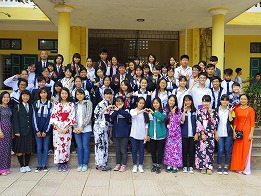 (Picture①)HIS students meet Thach That High School students. 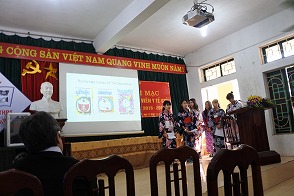 (Picture②)HIS students dance in yukata. 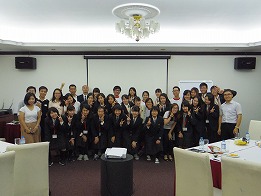 (Picture ③)HIS students meet Hanoi Medical Uni. nursing candidates. |
| 2016/ 11/4(Fri.) 1st year (14th) |
SGH Study Tour in Vietnam(3rd day)(1st year) In the morning, the HIS students visited a private school, Alfred Nobel School (ANS), and met 70 students between the 5th and the 11th grade. The HIS students made their English presentation about Japan, their school and their SGH report. After the presentation, they asked questions about working in Japan. Three of them answered that they were interested in working in Japan, and two answered that they would like to study in Japan. When the HIS students asked them what would be necessary for them to work in Japan, they answered that they would like to work in Japan if Japanese people could communicate in English better. The HIS students found that the Vietnamese students there were interested in jobs and countries in which they were able to use English, because they had been receiving education in English since they began elementary school. Later, the HIS students went around the school in groups and talked with the Vietnamese students. In the afternoon, the HIS students visited Hanoi University of Science and Technology. (Picture ②) They met twelve second and third-year university students who were learning the Japanese language. The HIS students gave their presentation and interviewed the university students. Ten of them were interested in working in Japan, and stated high wages as a motivating factor. All twelve university students answered that they would be interested in working in Japan if they got assistance in understanding Japanese, and eleven of them answered that they would be interested if Japanese people could communicate in English better. The HIS students found that the language barrier was one of the greatest problems. After the question and answer session, the HIS students talked with the university students. |
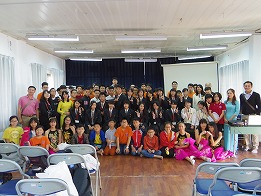 (Picture①)HIS students visit Alfred Nobel School. 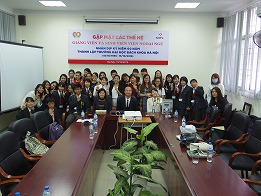 (Picture②)HIS students visit Hanoi University of Science and Technology. |
| 2016/ 11/3(Thu.) 1st year (14th) |
SGH Study Tour in Vietnam (2nd day)(1st year) The HIS students visited Vietnam National University Hanoi in the morning. They attended a lecture about global issues with 35 university students. Later, the HIS students talked about Japan and their school, and their SGH research in English. (Picture ①) After the presentation, the HIS students asked English questions about working in Japan. It was found that all of the 35 university students were interested in working in Japan if they were helped to learn Japanese, and ten of them said that they would like to work in Japan if Japanese people had better English abilities. They found that the language was an important factor when considering what immigration policy Japan should take. At Hanoi Sahul Hotel where they had lunch, the HIS students attended a job fair titled STEP HARIMA in HANOI. (Picture ②)The project was hosted by Himeji Employers’ Association. The small and medium-sized companies in Harima District, Hyogo, held a joint company information meeting in Hanoi to employ Vietnamese people. After the meeting, the HIS students went to a meeting of the Japan Vietnam Club (JVC) where Vietnamese people learned the Japanese language. (Picture ③) Here the HIS students presented information about Japan and their school, and their SGH reports. They asked Vietnamese people if they would like to go to work in Japan. All of the 35 people answered that they were interested in working in Japan. When the HIS students asked them why they were learning the Japanese language, some answered it was because they would like to work for Japanese companies and some answered it was because they would like to study in Japan. The Vietnamese people got information about Japan on the Internet, and many of them were interested in Japanese culture such as Japanese anime, manga, and celebrities. After receiving their answers, the HIS students talked with the Vietnamese people. (Picture ④) It was a very good experience for the HIS students to exchange views with the Vietnamese people. 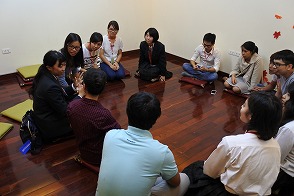 (Picture ④)HIS students talk with Vietnamese people. |
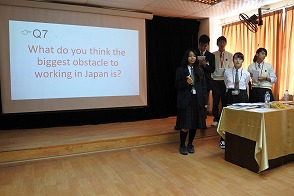 (Picture①)HIS students speak at Vietnam National University Hanoi. 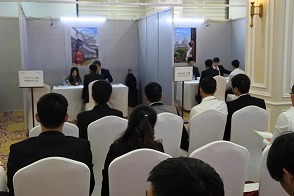 (Picture②)HIS students visit a job fair in Hanoi. 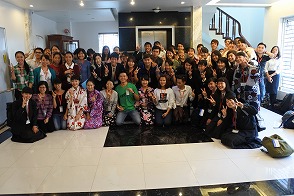 (Picture ③)HIS students visit Japan Vietnam Club. |
| 2016/ 11/2(Wed.) 1st year (14th) |
SGH Study Tour in Vietnam(1st day)(1st year) Twenty-one first-year students from Hyogo Prefectural International High School (HIS) participated in the study tour in Vietnam between Nov. 2 and 6, 2016. On the first study tour last year, the HIS students visited Cambodian villages; Many of the Cambodians, who had gone to work in Thailand, returned home to Cambodia because of low wages and illegal working status. Many of the Cambodian workers had not been educated enough. Previously, the HIS students had interviewed Vietnamese workers in Himeji. To follow this up, the students decided to interview educated Vietnamese people. The purpose of this tour was to determine how to accept more immigrants from overseas, and to propose a way in which Japan can help a large number of immigrants and Japanese people live peacefully together. Another purpose was to make reports, analyze the results, and share their proposals with other students, people in Japan and all over the world. The HIS students departed Kansai International Airport, (Picture ①)and arrived at Hanoi, Vietnam, at 13:40. They walked around, saw the city influenced by the past rule of China and France, and learned about the history of Vietnam.( Picture ②) |
 (Picture①)HIS students depart from KIX.  (Picture②)HIS students walk around Hanoi. |
| 2016/ 9/26(Mon.) 1st year (14th) |
SGH Project:Debate (Final) (1st year) The final of the debate was held. The two teams from the affirmative and negative teams whose scores were the highest in the preliminary rounds played in the final. The theme of the debate was whether Japan should introduce a dual nationality system to take in migrants. The affirmative side argued: 1. Japan should introduce the system to prevent Japan's population from declining. 2. It should intruduce the system so that both Japanese migrants abroad and internationl migrants in Japan can return to their home countries easily. 3. It should introduce the system to boost the Japanese economy. The negative side argued: 1. Japan should not intruduce the system because there is an educational gap between children with a dual nationality and children whose parents were born in Japan. 2. It should not introduce the system so that tourist spots will remain unique to visitors from other countries. 3. It should not introduce the system because rights and obligations of the public laws between Japan and other ounctires become complicated. Both teams showed their own evidence to support their arguments, and debated each other. (Picture ①②) After the debate, two special judges, Professo MITO Takamichi from the law department of Kwansei Gakuin University and Associate Professor NAGATOMO Jun from the School of International Studies at Kwansei Gakuin University commented on the debate. One of their comments was that it is very important to read a wide variety of books and to then organize these contents into their arguments.(Picture ③) The negative team won. Both team members and the other first-year students who judged the debate were able to deepen their knowledge about migrant issues through the debate.(Picture ④) 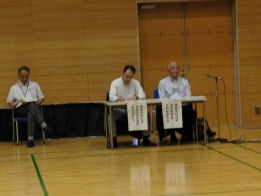 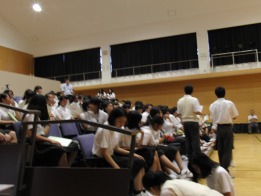 (Picture ③)▲Special judges (Picture ④)▲ |
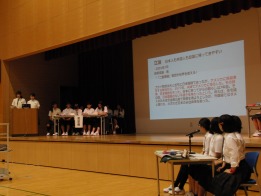 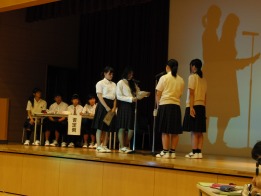 (Picture ①②)▲They debate on the stage. |
| 2016/ 9/2(Fri.) 1st, 2nd year (13, 14th) |
SGH Lunch-Hour Street Preaching (1st & 2nd year) At the lunch hour on September 2, four second-year students and 24 first-year students gathered in the central hallway. The second-year students tried to advise the first-year students about a debate which was going to be held in the following week. (Picture )The second-year students debated last year. They showed how to debate, and told the first-year students about important points for debate. The first-year students, who were debate team leaders, were eager to listen to the advice from the second-year students. |
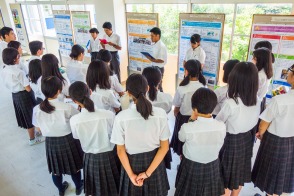 (Picture)Four 2nd years advise 24 1st years about debate--like preachers on the street. |
| 2016/ 8/29(Mon.) 1st year (14th) |
SGH Study Tour at Kwansei Gakuin University (1st year) On August 29, ten first-year students from Hyogo Prefectural International Senior High School (HIS) visited Kwansei Gakuin University (KGU). (Picture ①) The purpose of the tour was to know more about migration studies in order to prepare for a debate that would be held in September. What they were going to talk about in the debate was whether Japan should introduce the dual nationality system to accept migrants. They had prepared questions they were going to ask before the study tour. They discussed those questions with Associate Professors Mr. NAGATOMO Jun and Mr. SHIHO Kei from the School of International Studies at Kwansei Gakuin University. The two teachers taught them how to debate, and told them about some cases of nationality systems in other countries and human rights issues including citizenship. The students actively participated in the discussion with the teachers (Picture ②) and had a good chance to know more about nationality systems and migration studies. They hoped to debate better in September by using what they learned in the tour. |
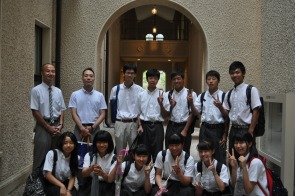 (Picture ①) Ten HIS students visit KGU. 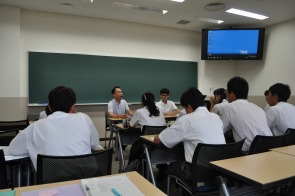 (Picture ②) HIS students discuss migratory issues with the KGU Associate Professors. |
| 2016/ 8/26(Fri.) 1st year (14th) |
SGH Fieldwork in Himeji (1st year) On August 26, 18 first-year students from Hyogo Prefectural International High School (HIS) visited two companies in the Himeji area. They interviewed 18 highly skilled Vietnamese workers there. They visited Kajiwara Iron Works Co., Ltd. in Himeji City (Picture ①②) and Takata Industry Consolidated Cooperation (Picture ③④) in Kanzaki-gun. After they listened to the introduction of the companies, they looked around the factories. They interviewed a Vietnamese empoyee at Kajiwara Iron Works and four Vietnamese employees at Takata Industry. In a talk with the companies’ employers, they found that small- and medium-sized companies were lacking highly skilled workers, and that was why both companies started to employ capable Vietnamese workers. The companies said that the Vietnamese people they were employing were so serious and hard-working that they had a good influence on the companies. In the interviews with the Vietnamese workers, they said that the best thing about coming to Japan was that they have been able to learn about advanced technology during their time here. They also said that all their Japanese co-workers were working hard and supporting them, and working in the companies was very comfortable for them. What was troubling to them, however, was the Japanese language. The Vietnamese workers found it difficult to understand the Japanese dialect and ambiguous expressions of the language. Some Vietnamese said that they often have trouble communicating in English, because Japanese people don’t understand them. The HIS students got a lot of information from the interviews, and they hope it will be helpful in considering what Japan should do in the future. |
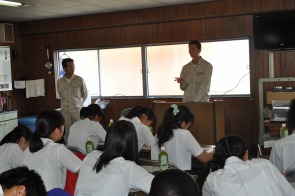 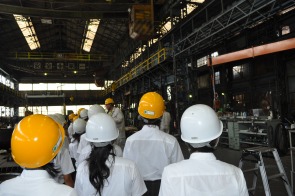 (Picture ①②)HIS students visit Kajiwara Iron Works Co., Ltd. 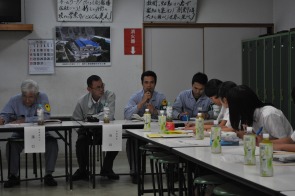 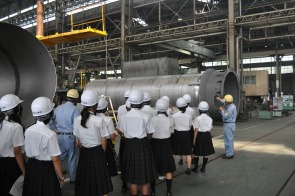 (Picture ③④) HIS students visit Takata Industry. |
| 2016/ 8/21(Sun.) 2nd year (13th) |
Hyogo-Kobe GLOBAL HEALTH High School Summit (2nd year) On August 21, 2016, the WHO Kobe Centre and the G7 Kobe Health Ministers' Meeting Promotion Council held the Hyogo-Kobe GLOBAL HEALTH High School Summit at Kobe International Conference Center. The summit was held as one of the pre-events of the Kobe G7 Health Ministers' Meeting, which was held in Kobe from September 11 to 12. Fifteen second-year students from Hyogo Prefectural Senior High School (HIS) participated in it and made two poster presentations. One group made a presentaion in English about a future vision of Japan based on the study of immigration . In 2015, a great number of migrants and refugees flooded Europe, leading to a migrant crisis in Europe. Today, Japan doesn't accept migrants fundamentally, much less refugees. As there are more older people with fewer children in Japan today, it is changing into a society where its population keeps on decreasing. The HIS students acquired various kinds of data from their fieldwork. In this poster presentaion, the group tried to share an idea Japan should adopt so that it could become a multicultural society in the future. The other group made a poster presentaiton about the same topic as the previously mentioned, along with information about their fieldwork in Cambodia. The field trip to Cambodia was held in March, 2016 in order to research more on the theme of HIS Super Global High School. The HIS students interviewed some peole who had worked abroad on a Cambodian farm where a lot of people went to work overseas. They asked the Cambodians why they went overseas and what social factors made them do so. After considering the answers to those questions, they tried to propose an idea about how Japan should adapt in the future. There was a question-and-answer session after the poster presentations. The WHO Kobe Centre Director, Alex Ross, discussed the questions with the HIS students in English. He made a comment on some plans the HIS students proposed so that Japan could take in more migrants in the future. He said that Japan couldn't avoid the issue of the decreasing population, and that the HIS students should look into the cases of countries like Germany, which was able to stop the pupulation from decreasing. He also said that Japanese deep-rooted prejudice against immigrants was a big problem, and that it would be very important for Japanese to get rid of the unreasonable dislike of migrants. The HIS students learned a lot from their poster presentations. In the plenary session, the HIS students particiapted in the discussion. |
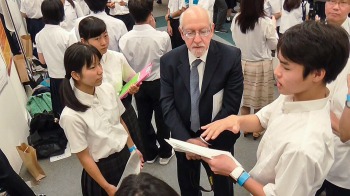 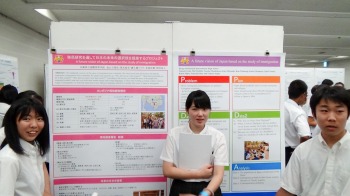 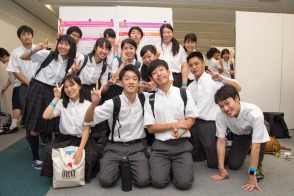 |
| 2016/ 8/10(Wed.) 2nd Year (13th) |
SGH Fieldwork@Multicultural Children's Center(2nd year) On August 10, 2016, the two second-year students from Hyogo Prefectural International Senior High School (HIS) visited the Multicultural Children's Center and talked with a senior supervisor, HORIUCHI Michiko, of the Human Rights Education Division in the Hyogo prefectural board of education to investigate the HIS's SGH topic on migrants. They tried to find how foreign people living in Japan are assisted in learning the Japanese language. Some students visited Cambodia and interviewed migrants there, and others visited Himeji and interviewed Vietnamese migrants who were working for companies in Himeji. They started to consider the importance of helping migrants in Japan to learn the Japanese language. That was why they looked into the way foreigners living in Japan and children of foreign descendants are taught Japanese. The Multicultural Children's Center is located in the same compound as HIS, and language supporters are sent there to help foreign students learn Japanese at school. The HIS students found how the supporters were teaching the Japanese language. After interviewing the supporters, the HIS students found it would be necessary to keep on sustainable help for the language learners, and to give assistance not only to children but also to their parents in learning Japanese. |
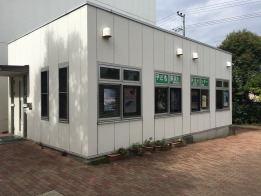 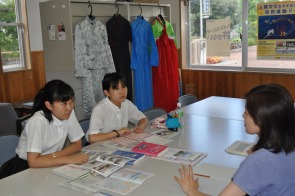 |
| 2016/ 7/12(Tue.) 1st &,2nd year (13th&14th students) |
SGH Special Lecture : Which policy should Japan adopt in the age of decreasing
population?--Is it right or wrong to accept immigrants ? (1st &2nd
year students) Mr. MENJU Toshihiro, a chief program officer of Japan Center for International Exchange(JCIE) gave a special lecture to the first-year and the second-year students at Hyogo Prefectural International High School (HIS). He talked about which policy Japan should adopt in the age of decreasing population---Is it right or wrong to accept immigrants? After the lecture, HIS students asked questions and he answered them. 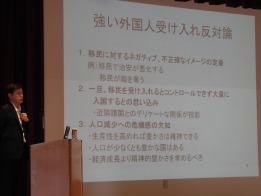 |
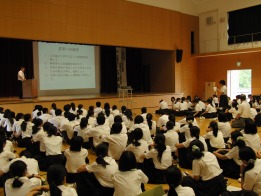 |
| 2016/ 7/11(Mon.) 1st year (14th students) |
SGH Study Tour @ Kyoto, Osaka, & Ritsumeikan Univ. (1st year students) All the 120 students in the 1st year at Hyogo Prefectural International High School(HIS) participated in SGH study tour at Kyoto, Osaka and Ritsumeikan universities. They visited them to attend a lecture given by a professor who researches on migratory issues, and to have a discussion with the professor in order to have a chance to deepen their understanding about migration studies. (1) SGH Study Tour at Kyoto University The 40 students visited Kyoto University by bus. (Picture ①)They got there at about 10 o'clock and visited the Kyoto Museum. After that between 10:30 and 12:00, they had a lecture given by NISHIYAMA Noriyuki, a professor at the faculty of integrated human studies. The theme was how Japan should be in the future in terms of its immigration policy, and how to think about Japanese problems in comparison with French ones. (Picture ②) He talked about the present situation of emigration in Japan and in France, the history of immigration in France, and the way Japan should be in the future. He elaborated on the reason why France started accepting immigrants in its history. He explained that from the viewpoint of demography Japan is going to have the most aging society with few children that no other country had ever experienced. He also talked about the importance of conducting migratory studies in order to think about how Japan should be in the future. After the lecture, HIS students had a discussion and a Q&A session with Professor Nishiyama to deepen their understanding of migratory studies. Later they visited Kyoto University library and had lunch there. They returned to school by bus. (2)SGH Study Tour at Osaka University Another group of 40 students visited Osaka University. (Picture ③) They arrived at 9:30, and learned how to use the library with Online Public Access Catalog(OPAC). Later, the eight groups of 5 students tried to find books searched with the OPAC in the library.(Picture ④) Next, they had a lecture given by YAMASHITA Hitoshi, a profesor of the graduate school of language and culture at Osaka University between 10:30 and noon. The theme was how a multicultural society should be, and what Japan should take into consideration when accepting immigrants in the future. He talked about the past immigration and racism issues, and how to solve the current immigration issues. |
|
| 2016/ 6/20(Mon.) 1st year (14th students) |
SGH Lecture on Japan's and the World's migration issues (1st year) Professor MITO Takamichi from the law department of Kwansei Gakuin University gave a lecture to the first-year students at Hyogo Prefectural International High School (HIS). He lectured on migration issues in Japan and in the world. After the lecture, Mr. Mito answered questions from HIS students. |
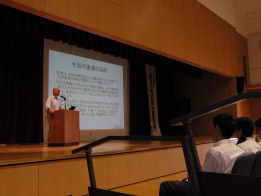 |
| 2016/ 6/19(Sun.) 2nd year (13th students) |
SGH Study Tour in Tokyo (2nd day) (2nd year) Ten 2nd-year students from Hyogo Prefectural International High School(HIS) made a presentation at Otsuma Women's University about the future of Japan based on the study of immigration . (Picture①)They reported on the European migrant crisis, in which a great number of migrants poured into European nations in 2015. They also said that Japan now basically closes its doors to immigrants and has accepted very few refugees. On the other hand, Japan is changing into a society with a decreasing population due to declining birthrate and aging population. They used the data obtained from their fieldwork, and talked about how Japan should become a multicultural society in the future. Mr. Kubo at Otsuma Women's University, and Ms. Sano at the Japan Society of Social Design Studies listened to this presentation, asked some questions, and discussed the issues with the HIS students. (Picture②)The students had a good opportunity to think about how to improve their proposals. 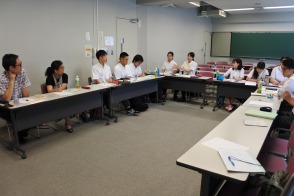 (Picture②) |
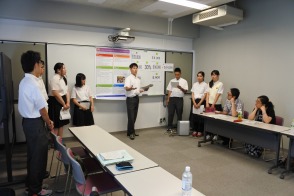 (Picture①) |
| 2016/ 6/18(Sat.) 2nd year (13th students) |
SGH Study Tour in Tokyo (1st day) (2nd year) The Japan Society of Social Design Studies(JSSDS) held an open forum at Rikkyo University.(Picture①) The title was 'Thinking again about social designs: what principle underlies a society--with ethics, a system, and reality in mind'., and 10 second-year students from Hyogo Prefectural International High School(HIS) participated. First, Professor Emeritus NISHITANI Osamu of Tokyo University of Foreign Studies gave a lecture about what principle or ethical basis underlies a community. He clearly explained what living together means. Next, Professor Emeritus MIYAJIMA Takashi of Ochanomizu University gave a lecture. He talked about what kind of a community European countries have been aiming to become by going beyond their different national principles and historical backgrounds. He also told the audience how institutional agreements are affected in European countries due to world migration. Then, Ms. SANO Atsuko at JSSDS reported on the present situation of Germany which used to aim at becoming a nation-state. She talked about what kind of community Germany is now trying to become. and what efforts it has been making. Lastly, the three lecturers held a panel discussion, and answered questions from the audience. Some HIS students asked quesions and participated in the discussion. (Picture②)The HIS students had a good chance to think further about how different people and groups can live together in Japan, and it is related to HIS's SGH research theme of sharing a vision of Japan's future through migratory studies. |
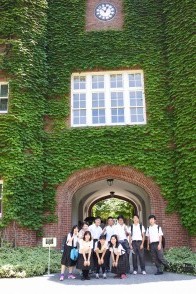 (Picture①) 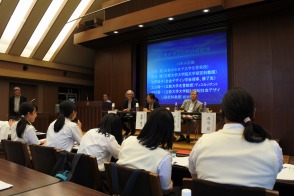 (Picture②) |
| 2016/6/6 (Mon.) 1st year (14th students) |
SGH Lecture: What migration policy Japan should adopt and how Japan should
react to the world situation An SGH lecture was given to Hyogo Prefectural International High School (HIS) students by Associate Professor SHIHO Kei from the School of International Studies at Kwansei Gakuin University. He lectured on what kind of migration policy Japan should adopt, and how Japan should react to the world situation. All the first-year students listened to his lecture. After the lecture, Mr. Shiho answered questions from students about things related to migration studies. 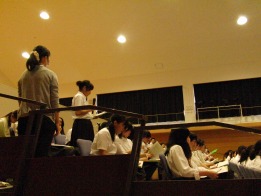 |
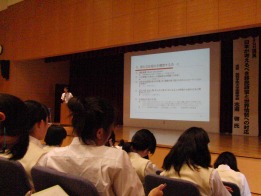 |
| 2016/6/1 (Wed.) 2nd year (13th students) |
SGH Project:Presentation &Discussion about Migration and Refugee Policy with German Students from Humboldt School Hyogo Prefectural International High School(HIS) students, and visiting German students from Humboldt school gave presentations and had a discussion on migration and refugee policy in English. 12 German students and 22 HIS students participated. First, four German students from Humboldt gave a presentaton on the present situation of migration and refugees in Europe and German efforts to solve these problems. An HIS student asked them, "Why is Germany trying to take in more immigrants, though there are a lot of problems in doing so?" The German students answered that Germany is an economic superpower, so accepting more immigrants and refugees is a German responsibility. "(Picture 1) Next, HIS students gave a presentation on their project to research migration and create a vision of Japan's future, using a poster. (Picture 2)German students asked a lot of questions, and HIS students tried to answer them.(Picture 3) They continued to discuss things after the meeting was over.  (Picture 3) |
 (Picture 1)  (Picture 2) |
| 2016/5/25 (Mon.) 2nd year (13th students) |
SGH Cambodia Study Tour Report Meeting 20 second-year students who had participated in a study tour in Cambodia between March 11 and 14, 2016 told the first and second year students about their tour. They talked about their activities in Cambodia and their interviews with the local people. 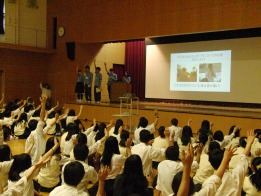 |
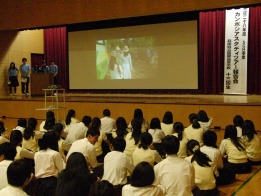 |
| 2016/5/2 (Mon.) 1st year (14th students) |
SGH Keynote Lecture: The Importance of Migration Studies--What should we
learn through Migration Studies? The SGH keynote lecture was given to Hyogo Prefectural International High School (HIS) students by Associate Professor NAGATOMO Jun from the School of International Studies at Kwansei Gakuin University. He lectured on the importance of migration studies, and what people should learn through migration studies. All the first-year students listened to his lecture. After the lecturet, Mr. Nagatomo answered questions from students about things related to migration studies.  |
 |
| 2016/3/25 (Fri.) 1st year(13th students) |
SGH Fieldwork in Himeji As Hyogo Prefectural International High School (HIS) Super Global High School research, a dozen first-year students participated in fieldwork in Himeji. The purpose of the fieldwork was to visit companies in Himeji, where foreign workers were employed as highly skilled professionals through the project called STEP HARIMA in HANOI promoted by Himeji Employers' Association. HIS students researched about the present situation of small and medium-sized Japanese businesses, and migratory work. They had a chance to think about Japan's future. The 12 first-year students visited Tsuta Metals & Machinery in the morning, and Sawada Precision Company in the afternoon. At Tsuta Metals & Machinery, the employment of foreigners was explained to the students. (Picture①)The company first employed four foreign workers when it accepted Indochina refugees. In the 2000s, foreign workers started to be employed as trainees, and in 2015, fifteen foreigners including trainees were employed. They come from Vietnam, Thailand, Peru, and Korea. The company started employing foreigners because the number of workers who wanted to work in the manufacturing industry was decreasing, and the company wanted to continue hiring new workers. The students learned that Tsuta Metals & Machinery is planning to employ two technical trainees, who can work without a working visa, though that limits the period of their stay in Japan. They also learned that there are not enough highly talented university graduates with a science background in small and medium-sized companies. After the explanation, they went to visit factories to see how foreigners were working. In the afternoon, they visited Sawada Precision Company. They listened to an introduction of the company, and visited the factory. (Picture ②)They learned that six foreign technical trainees and two foreign workers were emplyed. In the factory they were able to interview some workers. After they looked around the factory, the company gave them a chance to talk with three Vietnamese workers. In the interview, they learned that they came to Japan to learn the highly-advanced art of manufacturing in Japan. The workers plan to use the knowledge they gain in Japan to set up companies when they go back to Vietnam. The students also learned that Japanese was used in the company, and that the Vietnamese workers were having a hard time learning Japanese. The company helps them by holding a study meeting to learn Japanese on Saturday and Sunday. The fieldwork this time gave the students a chance to think about Japan's future. The students hope to utilize their experience in the following research. |
 (Picture ①)HIS students listened to the explanation made by Tsuta Metals & Machinery.  (Picture ②)HIS students saw Sawada Precision Co. factory  (Picture ③)HIS students interviewed Vietnamese workers |
| Mar. 14(Mon.) (2016) |
SGH Cambodia Study Tour (4th day) At 7:40, they set out to do fieldwork and arrived at Phlong village in Siem Reap Province. In Phlong, the village chief welcomed them. (Picture ①) The students were divided into two groups and interviewed three families the village chief introduced. They addressed questions to the people who had gone abroad for work. The students asked questions in English, and the interpreter translated English into Khmer. The local people gave answers in Khmer, which were translated into English for the HIS students. (Picture ②) They had interviews with eight Cambodians in total. They found that most of them went to Thailand, and some of the family members had gone to Korea to get higher wages. What was different from the migratory workers in Samor village in Takeo Province was that the people from the village of Phlong did many different kinds of work such as farming on sugar cane farms and working in a canned factory or a glove manufacturing factory. They migrated to work abroad so that they could get more income. Like the people in Samor village, Takeo Province, most of the migratory workers couldn't read or write, so they had a hard time collecting information. Illiteracy among workers may force them to get involved in illegal work. Students gathered a lot of data from the workers on this day.(Picture ③) After the fieldwork, they passed Angkor Thom and Angkor Wat, and arrived at Siem Reap Airport in the evening. They flew back to Kansai International Airport via Hanoi, Vietnam, and arrived in the morning on March 15th. They finished their Cambodian Study Tour safely. They are going to carry on their research in migration with the valuable experiences they got in Cambodia. 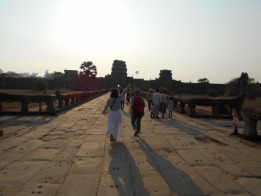 (Picture ④) The group went past Angkor Wat |
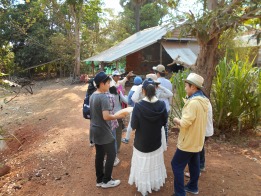 (Picture ①) The HIS group arrived at Phlong village 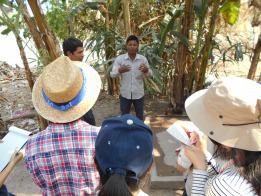 (Picture ②) HIS students intervied migratory workers 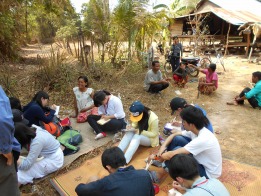 (Picture ③) HIS students interviewed people in Phlong village |
| Mar. 13(Sun.) (2016) |
SGH Cambodia Study Tour (3rd day) In the morning, they had breakfast in Samor village in Takeo Province, and they had one more chance to spend time with the 3 Cambodian international school students and the children.(Picture ①)They started to get used to communicating with people in English and with the local children in simple Khmer. A lot of children gathered early in the morning to say good-bye. The HIS students and children took a commemorative photograph together.(Picture ②) After lunch in Phnom Penh, they visited Tuol Sleng Genocide Museum and studied some Cambodian history. They learned that there are a lot fewer people over thirty years old because many of them were either massacred by the Pol Pot regime or killed in the following civil wars. After the museum visit, they went to Phnom Penh Airport and flew to Siem Reap. They met a Cambodian, Mr. Pong. He learned Japanese at a technical school, and he is now a tour guide mainly for Japanese tourists. At dinner they asked him various kinds of questions about migration. (Picture ④) 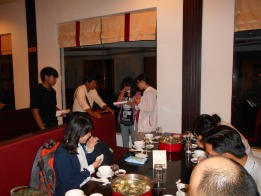 (Picture ④) The group interviewed Mr. Pong |
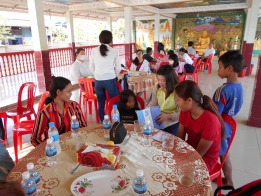 (Picture ①) HIS students met Cambodian international school students in Samor village 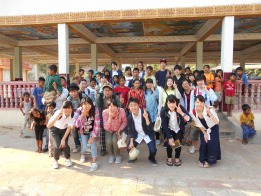 (Picture ②)HIS students took a photo with the children 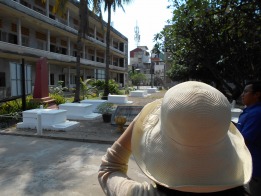 (Picture ③)The group visited Tuol Sleng Genocide Museum |
| Mar. 12(Sat.) (2016) |
SGH Cambodia Study Tour (2nd day) In the morning the group went from the Cambodian capital of Phnom Penh to Takeo Province. The students looked at a village's well made with the money HIS students collected and talked with the villagers.(Picture ①) At noon, the study group moved to Samor village and had local Cambodian food made by the villagers for lunch. There were many children at the Buddhist temple in the center of this village. (Picture ②) The HIS students used a dictionary of the Khmer language and tried to teach Japanese games like rock-paper-scissors and origami to the Cambodian children. They had a good time together. (Picture ③) After lunch, the HIS students were split into three groups. Each group visited a house, and interviewed migratory workers.(Picture ④) The HIS students asked questions in English, and interpreters translated these English questions into Khmer and then translated the people's answers into English for the HIS students. In total, nine Cambodians were interviewed, and the students found that most of them had gone to Thailand for their migratory work because they had very little information about other countries besides Thailand. Very few of them can read or write, so they seem to have trouble gathering information relevant to their migratory work. The HIS students gathered a lot of other data, and they had a very good experience. After dinner, students took part in a cultural exchange with the Samor villagers. The HIS students showed a dance from a famous Japanese animated cartoon, Yokai Watch. Later they did a Cambodian dance with the villagers. The performances finished at 21:00. The HIS students and the villagers got to know each other better through these activities. 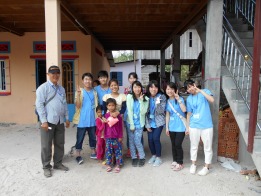 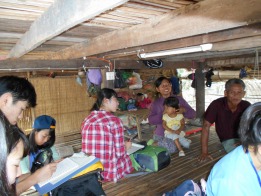 (Picture ④)HIS students interviewed migratory workers at their local houses 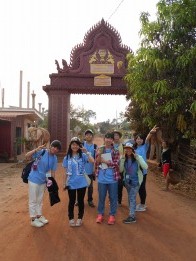 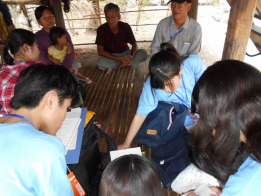 (Picture ⑤)HIS students went on fieldwork in Samor village |
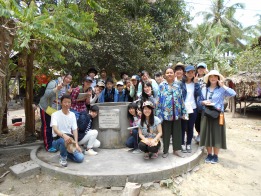 (Picture ①) HIS students saw the well 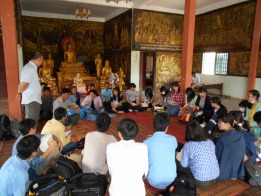 (Picture ②) HIS students met villagers at the temple in Samor village 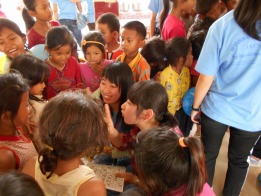 (Picture ③)The students played with children in Samor village |
| Mar. 11(Fri.) (2016) |
SGH Cambodia Study Tour (1st day) The Cambodian study tour group gathered at Kansai International Airport at 8:00. They flew via Vietnam and arrived at Phnom Penh Airport in Cambodia at 17:15. (Picture ①) The group then moved to a restaurant and had dinner with three students from a Cambodian international school. The Hyogo Prefectural International High School (HIS) students asked questions and spoke a lot with the Cambodian students in English. (Picture ②)The Cambodian students spoke about Japan's advanced technology. They also said that many Camobodians had a good impression of Japan because Cambodia was able to install roads and a sewage system thanks to the official development assistance(ODA) from Japan. They would like to go to Japan in the future if they have a chance. People connected with the Cambodian government also joined the meeting and gave a detailed report of the present situation concerning Cambodian migratory workers. The meeting finished at 21:00. The HIS students learned a lot from it. |
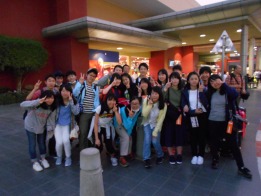 (Picture ①)The HIS group arrived at Phnom Penh Airport 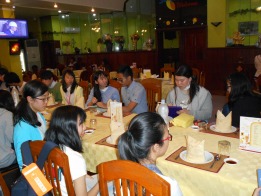 (Picture ②) HIS students spoke with Cambodian international school students |
| Feb. 17(Wed.) 2016 |
SGH Study Tour in Tokyo (2nd day) On the second day of the study tour in Tokyo, the students attended workshops run by staff members from the Office of the United Nations High Commision for Refugees (UNHCR)and Japan Associaton for Refugees(JAR). First, a staff member from UNHCR, Ms. KITAGAWA Airi, led the students in a discussion about what they would take with them if they had to run away from conflict. (Picture①) Next, UNHCR Public Relations Officer, Ms. MORIYA Yuki led a workshop.(Picture②) She answered questions that the students had sent beforehand. She explained what assistance UNHCR offers to refugees, and asked the students to sympathize with refugees in harsh conditions. She touched upon the situation in Syria, where a growing number of refugees are running away. She also mentioned that the severe situation near the border of Syria is leading to children fleeing in small boats to European countries. She mentioned that UNIQLO, an apparel company, was sending used clothing to refugee camps, and urged the students to consider how high school students can help refugees. Next, Ms. AKASAKA Mutsumi held a workshop for the students. (Picture③) She talked about the situation of the immigrants who are coming in to Japan, and the assistance for them. She said that JAR answers as many as 60 calls from refugees a day. She mentioned that Japan has recognized a very limited number of refugees, and emphasized that there are a lot of refugees in Japan, including those who have submitted an application for refugee status, and who cannot return to their own countries. When one of the students commented that more people should assist refugees in Japan, Ms. Akasaka said that it is more important that the people who assist them be eager, and said that the quality of the supporters is more important than the number of the supporters. Because the students listened to people who had firsthand experience working with refugees, they better understood the present situation of refugees. On the way home, the students wrote a report, and all of them finished their study tour in Tokyo safely. |
 (Picture①)  (Picture②)  (Picture③) |
| Feb. 16(Tue.) 2016 |
SGH Study Tour in Tokyo (1st day) On the first day of the study tour in Tokyo, the students had workshops led by Ms. SANO Atsuko and Mr.OSHIGE Shiro at the University of Tokyo. (Picture①) Before the workshops, all 32 students had read Ms. Sano's doctoral thesis, and Ms. Oshige's book about Japan's future in the era of immigration and emigration. They also had two study meetings about those reading materials. First, Ms. KUMADA Akiko, an associate professor from the graduate school of engineering at the Universtiy of Tokyo, introduced the university.(Picture②) Next Ms. SANO Astuko from the University of Tokyo talked about the German immigration policy. (Picture③) Before the workshop, the students had sent questions about her thesis, and she answered these questions in the workshop. She emphasized the following point the most: the reason why Germany started to accept immigrants was not because Germany would first have to deal with the problem of the decreasing population in the country, but because it recognized its histroy after World War II. In addition, she quoted the phrase, "Germany did not accept laborors but human beings.", and suggested some important things Japan should consider when it accepts immigrants to Japan in the future. Then, Mr. Ohige led a workshop. (Picture④)Again, the students sent him questions, and he answered them in the workshop. He emphasized that before Japan tries to decide whether it will take in immigrants or not, it should properly recognize the fact that a great number of immigrants already live in Japan. After both teachers finished their workshops, the students asked additional questios and they elaborated on the concepts about which they spoke. (Picture⑤)The students could better understand the theory behind immigration policies, and had a very important learning experience . After the students returned to the hotel and had dinner, they wrote a report about the first day. (Picture⑥)  (Picture⑥) |
 (Picture①)  (Picture②)  (Picture③)  (Picture④)  (Picture⑤) |
| Feb. 7(Sun.) 2016 |
SGH Project: Fieldwork in One World Festival For a Super Global High school research, all the first-year students took part in fieldwork during the One World Festival. The One World Festival is one of the largest events in Western Japan, in which around 150 organizations such as non-government organizations/non-profit organizations (NGOs/NPOs), international institutions, govenmental organizations, educational organizations, and companies broadly introduce their international cooperation to solve social issues. The purpose of this fieldwork was to have a chance to think about social issues such as immigration study and a vision of Japan's future. (Picture①) On this day the students came to school and rode a bus to a venue in Ogimatchi, Kita Ward, Osaka City. They researched the organizations and the companies they were interested in on the Internet, and visited their booths. (Picture②) At the companies' booths, the students asked how many foreign people were employed and how the companies made efforts to solve international problems. At NGO/NPO booths, the students researched how refugees are assisted and how people socially in trouble should be helped. One of the students had an interview with an international student from Vietnam, and learned why she came to Japan. In Vietnam, received a scholarship sponsored by a Japanese public utility foundation, which allows her to attend a Japanesen university. (Picture③) At government booths, the students listened to what the Japan International Cooperation Agency(JICA) does and how international contributions should be made. It was a very productive day for the first-year students, who are working on SGH research., |
 (Picture①) 150 organizations  (Picture②) interesting booths  (Picture③) interview |
| Feb. 6(Sat.) 2016 |
SGH project: Participation in the Third Senior High School Students' Day
for Thinking about International Issues The 3rd Senior High School Students' Day for Thinking about International Issues was held at Convention Center at Osaka University. About 260 students from 22 schools including seven Super Global High Schools(SGH) and three SGH Associate Schools from Hyogo, took part in this project. Eleven 1st-year students joined this project from Hyogo Prefectural International High School(HIS).(Picture①) In the morning, SURUGA Kazuto, Specially Appointed Associate Professor at the Global Collaboration Center of Osaka University, made a keynote speech. This was followed by four students' presentations regarding different international issues. HIS' own Nanoha Mandokoro spoke about immigration and emigration problems. Professor MATSUSHIGE Hisakazu of Osaka University's International Public Policy Department, who acted as a moderator, also questioned the students about their presentations. (Picture②) She specifically talked about the influx of immgrants in Germany. She said that as Japan's birthrate declines and the population ages, social issues such as depopulation in local areas, rising security expenditures, and a shrinking workforce, will become more serious. She proposed inviting more immigrants to Japan in order to help solve thses problems. In the afternoon, 41 groups presented their posters in a poster session. Two groups from HIS showed their posters and explained their projects.(Picture ③) Group A talked about making World Immigration Maps, while group B presented about a debate held at HIS. They both answered questions from other participants. Both groups were asked why they studied immigration, and they answered that they want to propose a plan that lets both Japanese people and immigrants live happily in Japan. Some people said that Group A's maps made it easier for other students to visualize the flow of immigrants. Other people thought group B was good because their presentation on the pros and cons of letting more immigrants into Japan was in an easy-to-understand format. |
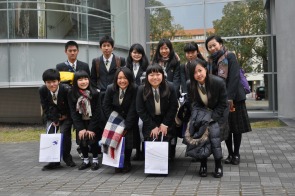 (Picture①)Eleven 1st-year students from HIS 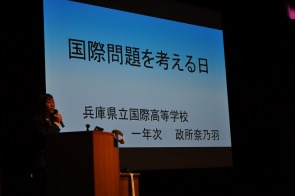 (写真②)Ms. Mandokoro, a panelist 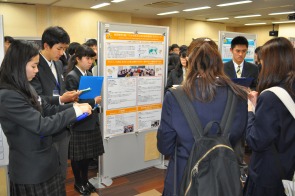 (写真③)Participating in a poster session |
| Jan. 23(Sat.) 2016 |
SGH Study Tour in Kwansei Gakuin University "High School Students' Open Forum" A Super Global High School(SGH) study tour was held at Kwansei Gakuin University. The EU Institute in Japan, Kansai (EUIJ Kansai) held a symposium and an open forum for high school students at the central auditorium in Nishinomiya-Uegahara campus. The symposium was about Japan's assistance for refugees and the European Union's policy on refugees. Twelve of the first-year students from Hyogo Prefectural International High School(HIS), who researched migrants for SGH, participated in this symposium. (Picture ①) In the morning, Mr. IGUCHI Yasushi, a professor at the School of Economics at Kwansei Gakuin University, made a keynote speech on the current situation and challenges faced by the EU in accepting refugees. Ms. KOIKE Yuriko, a member of the House of Representatives, gave a special lecture on the current situation and problems with Japan's refugee assistance. In the afternoon, high school students participated in the open forum. There were three sessions: (1)The EU's measures for refugees, with emphasis on recent Syrian refugee issues, (2)Whether Japan should accept refugees, and (3)How Japan should take in refugees. Students from Osaka Prefectural Kitano High School, Hyogo Prefectural Nagata High School, Kwansai Gakuin High School, and others took part in a heated discussion. The participants from HIS spoke out positively and contributed much to the forum. (Picture ②) |
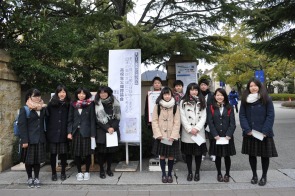 (Picture ①) 12 participants from HIS 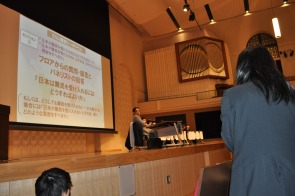 (Picture ②) an HIS participant speaking at a forum |
| Jan. 18(Mon.), 2016 |
2015 SGH Lecture by Mr. Ando, the First Graduate A 2015 Super Global High School(SGH) lecture was given by ANDO Sakai, one of the first graduates of this school. He spoke about "Japan seen from the United States of America, a multicultural nation with emphasis on coexistence--what Japan needs in order to become such a muticultural nation". Mr. Ando is now studying economics in a graduate course at Columbia University. The first-year students were interested in the lecture by Mr. Ando, who had studied at this school. In the question and answer session, the students asked a lot of questions about migrants, his life in America, and his school life in this school. |
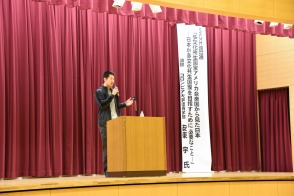 |
| Dec. 22(Tue.) 2015 |
SGH Research Makes "World Migration Maps" For the Super Global High School(SGH) reseach project, the first-year students made "World Migration Maps", spending 6 periods of integrated studies (C.C,C.) on Oct. 10th, 19th, 26th, Nov. 9th, 16th, and 30th to complete the project. The students were divided into 12 groups of ten, and each group researched one of 12 nations. In cooperation with Society and Information classes, the students used data from the website "THE GLOBAL FLOW OF PEOPLE"to create their maps. Each group illustrated the immigration to their nation from other countries and the emigration from that nation to other countries on a world map printed on a large piece of paper. Then, they considered the possible causes of the migration in the 12 nations and wrote them down. The students showed their migration maps during the SGH Midterm Presentation of Research held in December. The finished maps are displayed in school so that others may gain knowledge from this research. |
Click here for 'World Migration Map' |
| Dec. 17(Thu.) 2015 |
2015 SGH Midterm Presentation of Research (1st-year students) C.C.C. Presentation (2nd-year students) In 2015 Super Global High Schol(SGH) midterm presentation of research, the 1st-year students presented results on migration, and the 2nd-year students talked about their overseas study tour in Communication, Cultural Understanding, and Contribution(C.C.C) presentations. Those presentations were given at the International Exchange Hall of Hyogo Prefectural International High School(HIS). First, HIS Principal, Mr. Akimune and Chief Supervisor at Hyogo Prefectural Board of Education Ms. Katsura made an opening speech.(Picture ①) Next, SGH in-house promotion committee Chairman Mr. Maekawa outlined the Super Global High School (SGH) project of HIS.(Picture ②) Then, the first-year students gave midterm presentations about the result of SGH research on migration: (1)a report of a debate about migration (in Japanese) in the 1st-term (Picture ③) (2)a report on a visit to a canned fruit company during the summer vacation (3)a report on a visit to a university during the summer vacation (a discussion on migration at Kwansei Gakuin University) (4)a report on joint presentations of high-school and university through collaborative research at Kyoto University in the second-term (5)a report on the SGH special lecture (by Ms. SEYA Rumiko) (6)a report on the making of World Migration Maps in the second term (Representatives: (A)Dominica (B)Brazil (C)Germany (D)Cambodia (E)Australia) (Picture ④) (7)a report on the 2015 Winter Conference of Japan Association for Migration Policy Studies in December. In the latter half, the second-year students talked about the activities of the C.C.C. projects: (1)an outline of local surveys about the overseas study theme"Easy Peasy Japanesey" (2)what they learned in C.C.C.(Picture ⑤) (3)each report on the overseas study tours:(A)the UK (B)America (C)Canada)(Picture⑥) (4)a demonstration and an explanation of a presentation at foreign elementary and high schools(Picture ⑦) Lastly, the principal gave a closing address, commenting, "All the presentations were better than I had expected."(Picture ⑧) |
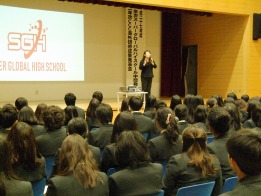 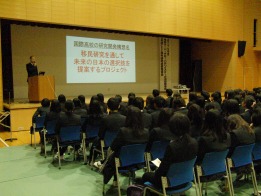 (Picture ①)Ms.Katsura (Picture ②)Chair Mr. Maekawa 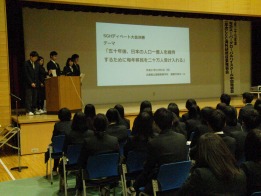 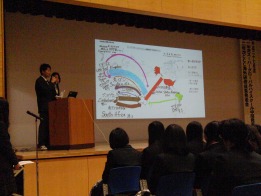 (Picture ③)About the debate(Picture ④)Migration maps 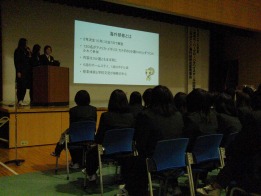 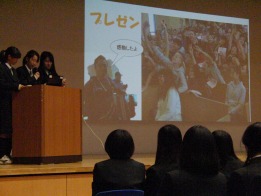 (Picture ⑤)About C.C.C (Picture ⑥)About study tours 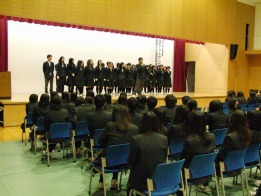 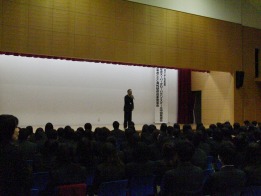 (Picture ⑦)Overseas presentations(Picture ⑧)Principal |
| Dec. 12(Sat.), 2015 |
SGH Study Tour in Nagoya The 2015 Winter Conference of Japan Association for Migration Policy Studies(JAMPS) was held in Nagoya on the campus of Chukyo University on December 12. 16 first-year students and 2 teachers from Hyogo Prefectural International High School(HIS) participated.(Picture ①) All the students participated in free presentations. Five of them participated in Free Presentations 1, three joined Free Presentations 2, and four students participated in Free Presentations 4. Each chose presentations they were interested in. This was the first time that they had taken part in a real academic conference. They were nervous at first, but some of them were active enough to ask some questions. When they said, "I come from Hyogo Prefectural International High School," the audience seemed impressed that the high school students were joining the academic conference.(Picture②) All the students learned a lot and they were greatly inspired. In Free Presentations 1, the students listened to a presentation by Ms. SANO Atsuko from the University of Tokyo, whose data was used by an HIS group in a debate. When Mr. Tasaka, an HIS student who quoted her data said to Ms. Sano that he had read her paper, Ms. Sano seemed to be greatly interested because he was only a high school student. Later the HIS students talked with her and they took a picture together.(Picture ③) |
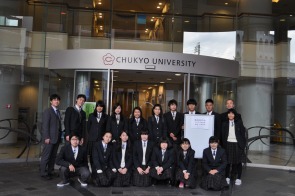 (Picture ①)Venue for the conference, Nagoya Campus of Chukyo University 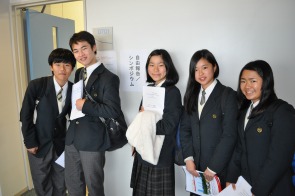 (Picture ②)Participation in Free Presentations 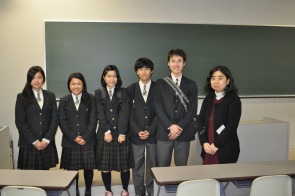 (Picture ③)With Ms. Sano from the University of Tokyo |
 |